#who is the entire city and the entire vast forest and possibly the entire ecological region
Explore tagged Tumblr posts
Text
#Spotify#music for when you’re driving to ace hardware to buy mousetraps so you can kick out that mouse like Nick Cave says#and when you get there you give him your best friend’s phone number bc you unfortunately have it memorized and he goes to ace hardware all#the time for work#and the guy on the register squints at you and confirms the very male name on the screen#and you resist the urge to squeak out an excuse and just confirm#and then you stop by aldi on the way back and buy two tubs of Greek yogurt and two bottles of synergy kombucha#bc even though you brew your own and actually have way more than you could possibly handle rn bc it’s so hot in your house#you are a sucker for limited edition flavors and it will cause you to spend $8 on kombucha#so you buy pomelo lemonade and cherry coconut lemongrass#which is the summer flavor named unity or something#and you usually get one every year#but you still feel ridiculous walking out of aldi with two tubs of yogurt and two bottles of kombucha and nothing else even though no one#you know sees you even though west ********* is crawling with acquaintances#and then you get back in your car and you’re proud of the rare burst of executive function which allowed you to finally put the new battery#in your car keys even though you stole the battery from target like two months ago you just couldn’t figure out how to open the damn thing#and the convenience is novel and you think wow maybe I should injure my ribcage more often if it’s forcing me to take care of all these#tiny tasks like buying mousetraps and replacing your key battery and cooking figs in honey et cetera#and you drive down the hill and see low clouds snagging in the blue ridge mountains and feel alright for a moment#and go to the scratch and dent where you buy butter and a couple 33¢ seltzers and a diet ginger ale as a lil treat#and when you get back home you drop it on the gravel road and the ginger ale begins to leak out so you put your mouth to it even though the#thought of what nonsense is on the outside of the can from the manufacturing and shipping process lingers#and by the time you get to the kitchen and pour it over ice in a mason jar it’s fairly flat from the burst of bubbles when you poured it#awkwardly with one hand#and you drink what remains on the porch where it’s a post-rain subdued sky sort of dusk#and you think about how much it’s gonna hurt to leave and how you have no other option because of how entwined you’ve become with someone#who is the entire city and the entire vast forest and possibly the entire ecological region#and then you’re still hungry so you eat some meal prepped overnight oats that were for tomorrow morning. the end#journal
3 notes
·
View notes
Text
What Is Burning the Amazon? A Plea from Brazilian Anarchists
As the fires in the Amazon rainforest continue to burn, our comrades in Brazil have sent us this analysis of the causes of the catastrophe and how it should inform our vision of the future.
“I worry about whether the whites will resist. We have been resisting for 500 years.”
—Ailton Krenak
Living Dystopia
The scene is gloomy. On August 19, 2019, smoke covers cities across the state of São Paulo, turning day into night at 3 pm. The previous day, in Iceland, people organized the first funeral, complete with a gravestone and a minute of silence, for a glacier declared dead. The smoke that engulfed São Paulo is caused by forest fires in the Amazon Forest far away in the North of Brazil; the glacier has disappeared due to rising temperatures related to the carbon dioxide accumulating in the atmosphere.

Chief of the Tenharim people of southern Amazonas fighting wildfire.
These tragic scenes—almost picturesque, almost absurd—could sound comical if they weren’t real. They are so extreme that they remind us of fictional scenarios such as those described in the novel And Still the Earth, a Brazilian environmental dystopia by Ignácio de Loyloa Brandão. Written in the 1970s during the military dictatorship in Brazil, the book describes a fictitious dictatorial regime known as “Civiltar,” which celebrates cutting down the last tree in the Amazon with a jingoistic declaration that it has created “a desert greater than that of the Sahara.” In this story, all the Brazilian rivers are dead; jugs of water from each of the extinct rivers are displayed in a hydrographic museum. Aluminum can dunes and highways permanently blocked by the shells of abandoned cars are the backdrop of São Paulo. The city itself suffers from sudden heat pockets capable of killing any unsuspecting person; mysterious diseases consume the citizens, especially the homeless.
The author claims that he was inspired by real events that seemed absurd and unusual at the time. Today, these are becoming ever more ordinary.
News of the increased burning of the Amazon has sent shockwaves around the world. Burns rose 82% in 2019 over the same period last year in Brazil, according to the National Institute for Space Research, and new outbreaks of fire are still being reported as we write. The catastrophic images of destruction have fueled the indignation of people around the world who are concerned about the future of life on earth, seeing how important the Amazon rainforest is for climate regulation and global biodiversity. Images of the fires compelled French President Emmanuel Macron to bring the subject to the G7 summit and to exchange barbs with President Jair Bolsonaro in the media after France offered millions of dollars in funds to fight forest fires.

Protest against deforestation in the Amazon, in São Paulo, August 23, 2019.
Since the end of 2018, half a billion bees have been found dead in four Brazilian states. The death of these insects that are essential to fertilizing 75% of the vegetables we eat is linked to the use of pesticides banned in Europe but permitted in Brazil. In August 2019, the court dismissed the charges against a farmer who used pesticides thrown from a plane as a chemical weapon against Guyra Kambi’y indigenous community in Mato Grosso do Sul in 2015. The same month, groups of farmers, “land grabbers” [people who falsify documents in order to obtain ownership of land], union members, and traders used a Whatsapp group to coordinate setting fires in the municipality of Altamira, Pará, the epicenter of fires consuming the Amazon rainforest. As reported in Folha do Progresso, the “day of the fire” was organized by people encouraged by the words of Jair Bolsonaro: “The goal, according to one of the leaders speaking anonymously, is to show the president that they want to work.”
The recent wave of fires linking President Jair Bolsonaro’s policies to attacks against forests, peasant farmers, and indigenous peoples is an intensification of a process as old as the colonization of the Americas. While the Workers’ Party (PT) was still in power, many projects were introduced to expand and accelerate growth, including the construction of the Belo Monte plant, which displaced and impacted indigenous communities and thousands of other people living in the countryside. The approval of the Forest Code in 2012 enabled farmers to advance over indigenous territories and nature reserves with impunity, while suspending the demarcation of new protected lands.
Both left and right governments see nature and human life chiefly as resources with which to produce commodities and profit. The government of Bolsonaro, a declared enemy of the common people, women, and indigenous groups, doesn’t just threaten us with the physical violence of police repression. In declaring that he will no longer recognize any indigenous land, Bolsonaro is intensifying a war on the ecosystems that make human life possible—a war that long precedes him.
A 500-Year-Running Disaster
For centuries, we have struggled to survive the greatest disaster of our time, a disaster that threatens the sustainability of all the biomes and communities on this planet. Its name is capitalism—the cruelest, most inequitable, and destructive economic system in history. This threat is not the result of the inevitable forces of nature. Humans created it and humans can eliminate it.

Anarchists in Sao Paulo on August 23, 2019 protesting against the government and against the deforestation of the Amazon: “Burn fascists, not forests!”
In Brazil, we have witnessed firsthand how this system exploits people, promotes genocide, and degrades and pollutes the earth, water, and air. Even if we ultimately manage to abolish it, we will still have to survive the consequences of letting it go on for so long. The destruction of entire ecosystems, the poisons in rivers and in our own bodies, the species that have gone extinct, the glaciers that have disappeared, the forests that have been cut down and paved over—these consequences will remain for many years to come. In the future, we will have to survive by gathering what we need from the ruins and waste that this system has left in its wake. All the material that has been torn from the ground to be strewn across the earth’s surface and dumped into the seas will not return overnight to the depths it came from.
Recognizing this should inform how we envision our revolutionary prospects. It is foolish to imagine that the abolition of capitalism will expand that the consumer activities that are currently available to the global bourgeoisie to the entire human population; we must stop fantasizing about a regulated post-capitalist world with infinite resources to generate the sort of commodities that capitalist propaganda has led us to desire. Rather, we will have to experiment in ways to share the self-management of our lives amid the recovery of our biomes, our relationships, and our bodies after centuries of aggression and exploitation—organizing life in regions that have become hostile to it.
The ways we organize our resistance today should be informed by the fact that our revolutionary experiments will not be taking place in a world of peace, stability, and balance. We will be struggling to survive in the midst of the consequences of centuries of pollution and environmental degradation. The best-case scenario for the future will look like the situation in Kobanê in 2015: a victorious revolution in a bombed-out city full of mines.

Last stand: neither utopias nor dystopias—revolution!
So What Is Burning the Amazon?
There is a consensus among scientific researchers, government institutions, social movements, and rural and urban peoples regarding the impacts and risks of global warming and increasing industrialization and urbanization. Some of these consequences are about to become irreversible. The deforestation of the Amazon itself may become irreparable if it reaches 40% of its total area.
It has never worked to demand that governments solve these problems for us—and it never will. This is especially foolish when we are talking about the environmental disasters caused by their own policies. Land seizures and the deforestation of the Amazon are inextricably interlinked with the organized criminal enterprises that smuggle and kill in the countryside. Fully 90% of the timber harvested is contraband supported by a vast apparatus of illegal capitalism involving armed militias and the state itself.
Populist leaders like Bolsonaro aim to benefit from the unfolding ecological catastrophe at the same time that they deny it is occurring. On the one hand, they claim that there is no need for action to curb global warming—alongside Trump, Bosonaro was the only other leader who threatened to abandon the Paris Agreement, claiming that global warming is a “fable for environmentalists.” This helps to mobilize the far-right base, which admires and celebrates outright dishonesty as a demonstration of political power. On the other hand, as the consequences of climate chaos and environmental imbalances become obvious undeniable facts, these leaders will opportunistically take advantage of environmental crises, product shortages, refugee migrations, and climate disasters such as hurricanes as pretexts to accelerate the implementation of ever more authoritarian measures in the fields of health, transportation and security. Using authoritarian and militarized means to determine who can have access to the resources they need to survive in a context of widespread scarcity is what many theorists have called ecofascism.
The intervention of foreign states in the Amazon forests according to their own economic interests is simply the continuation of the colonialism that began in 1492. No government will solve the problem of fires and deforestation. At best, they might slow the impact of the exploitation they have always engaged in. Neoliberal capitalism demands endless growth, mandating the transformation of forests and soil into competitive consumer goods on the global market.
So what is burning the Amazon—and the entire planet? The answer is clear: the pursuit of land, profit (legal or not), and private property. None of this will be changed by any elected or imposed government. The only truly environmental perspective is a revolutionary perspective seeking the end of capitalism and the state itself.

Mundurukus warriors without state support set out for direct action to expel loggers from the Sawré Mybu Indigenous Land in Pará.
Exercising Our Ability to Imagine
The dystopian images of And Still the Earth and George Orwell’s novel 1984 were intended as warnings: exaggerated projections of the worst that can happen if we fail to change the course of history. Today, with cameras around every corner and our own TVs and cell phones carrying out surveillance on us, it is as if these dystopian novels are being used as a handbook for governments and corporations to bring our worst nightmares into reality.
Dystopias are warnings; but utopias, by definition, represent places that do not exist. We need other places, places that are possible. We need to be able to imagine a different world—and to imagine ourselves, our desires, and our relationships being different as well.
We should use the creativity that enables us to picture zombie apocalypses and other literary or cinematic calamities to imagine a reality beyond capitalism right now and begin building it. Today, as reality surpasses fiction, our activities are largely characterized by disbelief and passivity. But you cannot be neutral on a moving train—especially not one that is accelerating on a track into the abyss. Crossing your arms is complicity. Likewise, acting individually is insufficient because it maintains the logic that has brought us here.
We have to rediscover revolutionary reference points for self-organized and egalitarian collective life. We need to share examples of real societies that have resisted the state and capitalism, such as the anarchist experiments during the Russian and Ukrainian Revolutions of 1917 and the Spanish Revolution of 1936. We should remember, also, that all of these were ultimately betrayed and crushed by, or with the connivance of, the Bolshevik Party and the Stalinist dictatorship that followed it, which carried out unprecedented industrialization and the mass displacement of agrarian peoples. This illustrates why it is so important to develop a way of imagining that does not simply replicate the visions of capitalist industrialism.
We can also look to contemporary examples like the Zapatista Uprising in Mexico since 1994 and the ongoing revolution in Rojava in northern Syria. But in addition to the examples offered by anarchists or influenced by anarchist principles, we should learn from the many the indigenous nations around us: Guaranis, Mundurukus, Tapajós, Krenaks, and many others who have ceaselessly resisted European and capitalist colonial expansion for five centuries. They are all living examples from whom anarchists can learn about life, organization, and resistance without and against the state.
If there is any fundamental basis for solidarity in response to the attack on the foundation of all life in the Amazon, it is the potential that we can build connections between the social movements, the poor, and excluded of the world and the indigenous and peasant peoples of all Latin America. To put a halt to the deforestation underway in the Amazon and countless similar forms of destruction that are taking place across the planet, we must nourish grassroots movements that reject the neoliberal resource management of soil, forests, waters, and people.
For a solidarity between all peoples and exploited classes, not between paternalism and the colonialism of governments! The only way to address the environmental crisis and global climate change is to abolish capitalism!
Another end of the world is possible!

55 notes
·
View notes
Text
DECOLONIZE EARTH
I was born belonging to a field and a forest edge until civilization stole my being and ‘developed’ my home. Years later I was still a teenager when I stole back some summertime alone in noncivilization, a juniper knoll over a lake. Each dawn a mourning dove perched on the branch above greeted morning cooOO-woo-woo-woooo. For years after, work-consume city culture swallowed my life. One day I opened my city door shocked to find a lame mourning dove on the deck. My mind wondered on which human construct caused the collision. My inner self, original self, truest self, arose from artificial hibernation. My animal being compassionately watched over this other animal being through days and nights as her body healed. When she found strength to fly away, I mused mystical meaning of this visit from my past converting this deck artifice into wild refuge. Too quickly I distracted back into illusory life.
I moved to another urban area, this one with sloped landslide-prone ‘parks’ astonishingly let be as withered wildlife habitat. They were dumped, fragmented and encroached into by domesticated humans and their invading tag-along plants and animals. These wild lands civilization rejected for ‘development’, however degraded, became my authentic life. In forests dominated by conifers, much taller and widespread than junipers, in swaths along saline shores, my animal being reawakened. This time I heard nature’s cries and responded wholly, learning ways of tending the wild. Indigenous plants are the locus of thriving wild, so I observed their characters, their pleasures and aversions, movements and constraints, givings and takings, shape-shifting communities and ranges, and what assists them in their struggles with invading colonizers.
My assists aligned with the science of restoring ecology, but my emphasis on caring observations of everything wild awakened a connection deeper than anything science. I didn’t see my change coming, or plan it, though I was ready for it and accepted it fully. Despite reports as increasing in population, the only time I saw a mourning dove since moving to the land of towering conifers was on a walk through a human altered environment. Crows harangued with raptor-warning caws from electric lines above her lifeless body on roadside lawn. Blood dripped from her beak as a hawk held her still with a talon to rip open her breast. My mind wondered if humans’ ‘development’ vastness created space too open, stealing cover that serves hawk the advantage. After years of lying dormant inside me, mourning dove’s call intuitively sounded, not entering through my ears but emanating through my voice. cooOO-woo-woo-woooo
Mourning doves are so uncommon in the forests that I began using the call to communicate with habitat restoration friends working within sound range, drawing selective attention of others familiar with expected bird calls of the place. I varied the emotionality of the call to signal meaning, from “I’m here now” to “Come check this out!” Now that my project focuses on inviting return of extirpated indigenous plants, each time I cast seeds, bury rhizomes or stake stems into a habitat in which the species once thrived, I sound the mourning dove’s call selectively to all others who live in this home to announce the plant’s presence. Then I leave the wild alone to reacquaint.
During a recent training on how nonNatives can ally with Native Americans I learned a lesson not taught: restoring wild ecology is the deepest way colonized humans can decolonize. Returning a place toward its pre-colonized state is rewilding both the place and the rewilder’s self. This training however centered on identity politics, which I see as correlational to and part of the birth of human colonization: civilization. Humans’ domestication and domesticating is colonization’s core, which is wild life’s core problem. As this training revealed, civilized humans wage futile fights paradoxically against civilization’s hierarchies. Further, they see the heinous power they hold over nonhuman animals as worth the price of civilizations’ ‘progress’, from world takeovers much farther back than humans’ most recent post-stone age globalization.
Post-stone age colonization removes us from wild ways of knowing, for example, replacing childhoods in connection with nature to childhoods enclosed behind walls studying ways of controlling nature. Humans’ stone age colonization enculturated humans away from primal ways of living by unnaturally positioned themselves as Earth’s top predator as they expanded. This most noticeably manifests in the shifting human foodway from biological herbivores to advantageous omnivores. From foraging to dominating by organized hunting.
Past shifting human lifeways of a place creates a curious predicament in restoration ecology. The restoration reference point of a place resembles the most recent phase diversity of life was thriving there. In most cases that phase was a settled period after the habitat was markedly altered by human colonizing actions impacting the environment. If nature restorers’ reference point for a place was shaped by actions such as old growth forest burns set by some to open gaps for hunting opportunities, how do they account for these missing human interactions that shaped the ecology?
For thousands of years humans have decided how all life live, further which life and entire species live and which die. Imagine a pre-human colonization wildlife map. Imagine wildlife timelines fluctuating at points of first human contacts, how interconnections transitioned from wild dynamics to hierarchies under human control. Species deemed appealing to human usefulness or preference moved to the top, while any species unwanted was marginalized and risked extermination. Imagine nonhuman animals hosting a training for humans on the history of their oppression and exploitation, complete with stories of their slaughters and species extinctions, as well as their resistance stories and strategies, with an invitation for you to support them.
An invitation to ally with nature, to liberate Earth from human colonization, would center on rekindling primal relations with others we now oppress. A training to ally with wild life would confront humans’ colonizing propaganda, stereotypes and defenses with countering truths. Not all past humans hunted, many remained foragers, just as many humans today as young as toddlers instinctively choose to refrain from animal exploitation. Humans’ reign over others is not natural, nor is humans’ consuming animals part of the ‘circle of life’, no matter how much ‘thanks’ is expressed. The heart of wild interactions and relations is not using others as resources, but thriving community wild life. Other animals do not mystically ‘offer’ themselves for consumption, whether or not ‘every part’ of their body is used. They are not ‘food’ animals brought into existence for us to live, but wild animals often bred into unnatural form by imprisoning civilized hands.
Truth is, humans are an incredibly adaptive species with great abilities to change toward sustainable lifeways, if they would take steps in overcoming their speciesism. In a training to ally with nature, they would get a checklist to test their speciesism, akin to Dr. Raible’s checklist for antiracist white allies. *I demonstrate knowledge and awareness of the issues of speciesism. *I continually educate myself about speciesism. *I raise issues about speciesism over and over, both in public and in private. *I identify speciesism as it is happening. *I take risks in… Like civilization, speciesism is so rampant, so ingrained in all of everywhere, the chasm feels unbridgeable. But going hand in hand with civilization, not facing the daunting task of bringing down speciesism means humans’ own demise.
Like all oppressions, the dominant group benefits leave tracks of misery seeming so unnecessary in retrospect. Bringing down the old ways gives space for the new. Humans can identify and breach the cracks in the cycle of systematic oppression of nature at each step. The generated misinformation and propaganda. The justification for further mistreatment. The institutions perpetuating and enforcing speciesism birthed in civilization. The internalized dominance and feelings of superiority. The internalized oppression via subscribing to the narrative. The cultural acceptance, approval, legitimization, normalization. The systemic mistreatment of nature. Whether targets are specific or broad, planting seeds in the hearts and minds or immediately effective actions, opportunities abound.
While the path of the new way does not and cannot have an overarching plan, some potential actions of the new way can be envisioned. Collectively reduce human population. Give back land for indigenous rewilding. Restore habitat toward times of last thriving ecosystems, that is pre-European colonization. Invite the return of extirpated species. Where possible, reintroduce human-removed indigenous top predators. Sanctuaries for liberated animals bred into domesticated forms who cannot go feral or co-adapt into habitat community. Shrink animal agriculture first, plant agriculture second. If possible, skip over architecting food forests & permaculture with humans at the center and return straight to foraging. Draw from sciences without bias barriers to wildlife’s innate right to live on their own terms
Humans will either soon drive themselves to extinction with many others, or they will decolonize themselves by mutualizing their alliance with Earth’s living communities. Hope lies in releasing mass delusion, in bringing down speciesism and civilization that dragged it in, in assisting Earth’s transition into a rewilded state that includes the compassionate feral folio-frugivore human living in symbiosis with others. Not utopia, but liberating Earth from human domestication. The transition has already begun, and all humans are invited to join. cooOO-woo-woo-woooo
27 notes
·
View notes
Note
In 2050, what will life on Earth be like?
this is going to be a long post because I am extremely interested in futurism and predicting the future with scientific, social and economic models. I’ve spent countless hours viewing content like futuretimeline.net, futurism.com and youtuber Science & Futurism with Isaac Arthur, and have written a few papers on predictions of the future. Just to make things more convenient for me though I’m going to round this up to 2050-2070, because I think there will be events in, say, 2064 that definitely rely on things that happen in the 2050s. I’ll also break this down under different sections such as technology, economy, environment, politics, society, etc to make it easier to read rather than one giant mess of paragraphs.
That being said, I’m not very optimistic about 2050. I think if we avoid the climate scenarios I list and force change through sociopolitical and economic revolutions, we will see a much brighter future, but at the rate now I’m honestly so worried about where we’re heading because the consequences will have an impact on every single human being on the planet.
TECHNOLOGY
Probably the most optimistic part of this. Technology by this time will have changed everything from global communications, to manufacturing, to even the clothes you wear. Widespread advances in medical and genetics technology will have vastly expanded lifespans for those with access to healthcare. Diseases like AIDS and Alzheimer's will have vaccines or cures, and cancer, while not truly curable, will be very treatable with survival rates nearing 100% - for those who have access to it. The rich will be able to afford “designer babies”, being able to pick desirable traits for their children in vitro. Nanotechnology has advanced to the point it is feasible and used in everything from the construction of houses, fighting diseases in the body, mitigating climate change, and clothing. Computational power continues to grow exponentially, Moore’s Law is dead. Artificial Intelligence will be everywhere, and has advanced to the point that it may seem sentient to people. Automation has taken most of the jobs on Earth, with service, factory, and accounting jobs being long gone. The majority of cars will be smart cars with self-driving capabilities. Green energies like solar, hydroelectric, wind, and even biofuels and nuclear power (possibly including very limited fusion power) will slowly replace fossil fuels such as coal as the primary power source, but oil will still be in great demand. National space agencies such as NASA, the ESA, Roscosmos and private corporations like SpaceX will have solved the long-time problem of immense costs of launching things into space through the use of new fuels, rocket designs, and launching systems such as mass drivers, leading to the beginnings of space infrastructure and industry orbiting Earth. A new space station to replace the long since decommissioned ISS will be created completely in orbit, likely with a rotating wheel design for simulated gravity. The moon will have a small scientific outpost on it, and Mars will have a permanent, yet tiny human settlement. Space tourism will be a thing, albeit for the wealthy, and the benefits of low gravity will allow for automated manufacturing in space. Asteroid mining will take off around this time. Cybernetics as seen in science fiction and cyberpunk media will become a reality, as prosthetic limbs and artificial organs will have advanced to being as physically capable as the real thing, though I doubt they will be as widespread as featured in sci-fi media. Most people in developed countries will have technology on them at all times, either it being smart clothes, the implants that allow 24 hour access to the internet in their skull, or the nanomachines in someone’s blood.
SOCIETY
Society is under great stress around this time. The consumer culture and hyper-spending of the 20th and early 21st century will be nonexistant or mostly phased out across the globe, as economies are forced to adjust to diminishing resources and political upheaval around the globe. Newer generations resent the older generations - blaming them for the cause of many problems. World population growth has stagnated around 9.8-10 billion people, with the majority of the population aging, with a drain on capital as the worker-to-elderly ratio begins to fall. Media has become completely decentralized and diverse. Athough the number of democratic countries has risen significantly over the years, many have turned inward, cutting off foreign relations. Revolutions, wars and failed states have produced a strikingly different geopolitical map than seen at the beginning of the century.The gap between the rich and the poor widens to the point of upward social mobility being nigh impossible, at the same time as the world’s first trillionaire appears. Massive demonstrations and rioting increase around the globe. Food and water shortages are common everywhere, even in the “first world.” Poorer and arid countries are struck the worse. There are 150 million climate refugees, a six fold increase since 2010. Radical parties on both sides of the political spectrum, from communist and eco parties on the left side to anti-immigrant and fascist parties on the right side, both promising to relieve the stress of the people, explode in popularity. News of revolutions and military coups in developing countries are seen almost daily. Nationalism and xenophobia surges across the globe as people become heavily distrustful of foreigners and immigrants. The vast majority of people live in massive, sprawling megacities. As more and more wealth trickles upwards to the hyper-rich elite, there is a growing consensus that money itself – the profit motive – is a major obstacle to future progress, and a new driving force may be required for civilization to flourish. Free market capitalism is largely viewed as a woeful and broken system, as people shift away from consumerism towards a more conservational economic system.
ECONOMY
As more wealth trickles to the hyper wealthy elite, the average person feels the burden of a more and more uncertain and often times recessive economy. Decades of stagnation has produced a fragmented, chaotic global economy. Nearly half of every country on the planet has shit credit ratings, effectively making them bankrupt. US national debt has now surpassed almost 400% GDP, exceeding even the levels seen during World War II. China has surpassed the US in GDP, but itself will be surpassed by India, all three will stagnate or worse depending on political and ecological events that will happen around this time. As said before, majority of service, manufacturing, and accounting jobs have been taken over by AI and automated services, creating a class of people that have no income that could represent as much as 66% of the population of a given country. Governments are forced to initiate programs such as a universal basic income. Megacorporations have become a thing, and corporations profit from climate change mitigation and even war and international conflicts. Nearly the entirety of the working US population at this time is employed by a corporation, with “self employed” people being merely contract employees or artisan creators. The world is facing an economic recession worse than the 2007 recession, with climate change being a major factor.
ENVIRONMENT
The deadline set by the Paris Agreement for eliminating carbon emissions by 2035 had been missed. The result in 2050 has lead to conditions that could be called apocalyptic. Arctic ice melt has lead sea levels to rise nearly a meter, greatly impacting coastlines and low-land areas. Cities like New York, London, Hong Kong, Honolulu, and many more have erected great sea walls and pumping systems to keep out seawater. Cities like Venice have been greatly depopulated or outright abandoned due to flooding, and entire small island nations face destruction and collapse as they cannot stop the erosion of their coastline. Many of the islands in the South Pacific and Indian Ocean have been completely abandoned, moving to Australia or Eurasia. Warmer seas have lead to massive superstorms that kill hundreds of thousands, up to a million, each year. Coastal regions are battered by typhoons and hurricanes that far exceed the damage caused by storms like Hurricane Katrina. Tornado Valley in the United States expands and covers states as far as Ohio, with tornadoes becoming more and more extreme each year. Drought and heat waves are excessively common. Desertification has expanded as far north as Spain and the Mediterranean in Europe, and the breadbasket states in the US. Permafrost melt in Russia and Canada and Greenland have turned these countries into agricultural superpowers. Mining settlements and even cities are being founded in coastal Antarctica as global warming has melted the ice and caused temperatures to increase to a cold, yet tolerable. The equatorial region of the Earth has become so hot and arid that few stable countries exist in the region. In Africa, South America, and Asia, rivers begin to run dry, causing regional skirmishes and resource wars over water with upriver countries holding what little water flows as a political tool. Over half of the Amazon rain forest has been deforested for farms that last only a few years at most, creating deserts and parched scrublands. Wildfires have tripled in areas such as California and Australia. The 6th Mass Extinction, known as the Holoscene Epoch and caused by man, is in full effect, environmental destruction has reached it’s apex, with 0.5% of animal and plant species going extinct each year in tropical forests alone. Overfishing, warming seas, and ocean acidification has resulted in mass amounts of marine wildlife dying off, effecting food supplies of humans and animals heavily. 1/5 of all reptile species are extinct at this time, with amphibians being effected even more. Outbreaks of super-resistant bacteria and viral infections are worsened by the climate. The shortage of food and water worldwide, extreme droughts, superstorms, and flooding coastlines along with the political conflicts such as war and economic depression that arises from the climate crisis has created over 150 million climate refugees throughout Asia, Africa, South America, the Middle East, and Oceania. With nowhere to turn, they head to Northern regions such as Europe, North America and Eurasia for relief, creating the single largest migration crisis in recorded history that heavily effects international politics.
POLITICS
Global political systems are in a period immense transition and struggle. Due to worsening climate change, a depressed global economy, and political upheaval across the globe, the state of the planet is in an immediate threat to world peace. Much of the world has moved into a rapidly degrading geopolitical situation, with climate change and a seemingly unending stream of climate refugees driving the crisis. Throughout this period, increasing numbers of equatorial countries are now classified as failed states, with collapsed governments and directionless populations. Civil war is becoming common in most regions. Countries adjacent to equatorial regions are experiencing severe political and social strife, with anti-immigration gripping the US, Europe, and Africa far, far worse than current times. The Mediterranean and Eastern Europe has become highly militarized with Italy, Spain, and Greece hit with massive migrations, resulting in nationalist and fascist governments coming to power. Countries in Europe are in a political deadlock over food and water, with the EU likely collapsing at this time. The country of South Africa has turned into a war zone as it aggressively turns back refugees from Central Africa, which has almost entirely been consumed by desertification. Asia is facing multiple problems as well, with countries like Bangladesh slowly being emptied of it’s population. South East Asian populations are fleeing to neighboring countries such as China and India, which themselves are seeing populations flee to Europe and elsewhere. At the southern border of the US, the situation is extremely pressing. Massive flows of immigrants from South and Central America due to political and economic collapse has caused anti-immigration to surge to extreme levels in the US, with extreme nationalistic and fascist parties gaining support. Though Brazil and Argentina have managed to retain some stability, the mountainous northwestern countries like Peru and Bolivia have degraded and collapsed into armed camps protecting water supplies. Central America collapses into civil war. Countries such as New Zealand, Japan, and the UK have stabilized themselves by completely cutting themselves off and becoming self-sufficient. The equatorial droughts and worldwide instability has left the Middle east as a wasteland of destructive anarchy, with only a few countries remaining somewhat stable. It is very likely that a low-scale nuclear war will erupt between countries like India and Pakistan or Israel and Iran over immigration, water, and food. As the Arctic has melted, freeing up resources that have yet to be tapped such as oil, Russia and the United States race to claim territories in the far north, leading to escalation and political tension and possible war between the two countries. It is likely that at least one city will be devastated by a terrorist nuclear weapon by 2050, with massive amounts of weapons grade nuclear material disappearing from Russia after the dissolution of the Soviet Union in the 1990s. Bioterrorism and even nanotech terrorism can occur, as gene editing and nano manufactoring technology has become widely more accessible. Amidst the massive instability and suffering worldwide, many end times and primitivist movements arise across the globe. Institutions such as the UN, the EU, NATO, and BRICs will likely dissolve around this time. It is possible the world may enter World War 3 over the lack of resources, the worsening climate, the climate refugees, and claims to water.
I know this is a REALLY fucking dark outcome, and I’ll probably be wrong with a lot of this, but this is what I’m expecting to happen around 2050. I’ve studied a lot of these articles and futurism sites for a long time now and this is what I’ve put together from all of those. While I think we face a dark and uncertain future, I think the world will actually recover and get better a little further in the future.
8 notes
·
View notes
Link
We briefly mentioned the problem of hierarchy as the shared root of many systems of oppression in our first column two weeks ago. In this article, we want to expand on the meaning of hierarchy—a system of obedience and command backed by the threat of force—and ground it in history. If we are to understand what we face and avoid reproducing it in building a new society, the social roots of hierarchy deserve a more thorough exploration.
In Western society, there are two prominent 'origin stories.' One is that of the Hobbesian ‘war of all against all,’ in which humans are innately vicious and violent, and only the introduction of strong authority could keep people's natural state in check. The other story is that prior to the existence of civilizations, humans lived in egalitarian and mostly peaceful bands enjoying the natural abundance of nature. In this version, it was only with the development of agriculture and centralized societies that we fell from grace and became the violent and hierarchical creatures we are today. Both stories share an assumption that pre-civilization humans can be painted with a broad brush, and that hierarchy - whether good or bad - can be traced to a natural evolution point in human history.
Thinkers like Rousseau, Spinoza, and Hegel weren't satisfied with the idea that hierarchy is natural. They asserted that humans have the capacity to be either hierarchical or egalitarian, depending on history and existing social structures, and that human beings are dynamic and not static: there is no single human nature.
Recent anthropological work appears to prove the truth of this more nuanced perspective on the history of hierarchy in human society. David Graeber and David Wengrow argue that the story isn't so simple as anthropology’s old tale of roving communal egalitarian bands, followed by hierarchical agricultural societies. In fact, they explain, extraordinarily diverse social orders often shifted between very hierarchical and more communal social structures over time, even within a single year. Throughout human history - this newer evidence suggests - we were neither 'noble savages' nor victims of a violent chaos. Even the notion that there is a traceable origin point of hierarchy has been challenged, because this variance in social structure appears to have lasted beyond the development of agriculture and cities; many early cities with advanced infrastructure were composed of apparently classless societies.
So how do we explain the near ubiquitous existence of hierarchical political forms today? Graeber and Wengrow state that despite the early diversity of societal structures - with the formation of the first states around 5,000 years ago - hierarchy became the reigning social order and remains so to this day. The emergence of the state was characterized by a monopoly on violence, which also allowed surplus to be forcibly concentrated in the hands of a small elite. With this concentration of wealth came tools of violence and control: kings, priesthoods, armies. With their control over surplus came private property and the need to protect it; from private property came inheritance, and patriarchy as a mechanism to assert ownership of property across generations, through women’s servitude and control over their reproduction.
The Marxist and anarchist traditions have long worked to explain how these historical transformations calcified inequality and domination, how such class societies have developed over time, and how we can transcend these dynamics into a new society of freedom. Marxists theorised that the first class societies emerged out of “primitive communism” through a new division of labour and an agricultural surplus that could sustain an idle ruling class. In Origins of the Family, Private Property, and the State, Friedrich Engels developed the theory of patriarchy’s origin in private property. Marx himself focused on the shift from feudalism to the new class structure of capitalism: an unequal relationship between the owning class and the working class. The bourgeoisie owned the factories, and the proletariat provided their labour.
None of this was a natural phenomenon: it was through a specific historical development that modern tools of control emerged, and it was only by understanding the nature of this hierarchical relationship between two classes that we could collectively undo hierarchy and build an egalitarian world.
For the first century of Marxist thought on class society, however, the connections between human exploitation and environmental exploitation remained largely unexplored. In the mid-20th century, Murray Bookchin, an anarchist theorist and former Marxist, began to develop a framework called social ecology as a way to understand how environmental disaster has its origins in hierarchy as well. Social ecology recognizes that ecological problems are at root social problems. The destruction of our environment is not some natural, vicious drive of humanity, but something that emerges from the very inequalities created by hierarchy.
We have always adapted nature to our needs, but the destruction of our common home is always against our common interests, and people who survive by their knowledge of their ecosystem are rarely inclined to destabilise it. Hierarchy creates a class at the top with particular interests of its own, distinct from those of the rest of human society and the environment from which they emerge, and with the power to pursue those interests against the will of those below. Hierarchy thus facilitates environmental destruction by allowing a small group of elites to pursue their own wealth through exploiting both lower human classes and the rest of nature without accountability or consequences (at least not for them). Bookchin also argued that it was through the domination of one another that we could even conceive of striving to dominate nature.
Since the dawn of early states and classes, elites have marshalled common resources for interstate conflict and enrichment, proliferating slavery, warring armies, and monuments to their conquests. It is no coincidence that Gilgamesh, recorded history’s first mythic hero, was both the king of one of the world’s first states and the destroyer of great cedar forests. From the city-states of Sumer and the independent emergence of permanently unequal societies in other parts of the world, conquest spread new orders of domination globally, to the detriment of the entire web of life. Capitalism is simply the most recent form of this basic dynamic. Capitalism and its structural imperative for growth are fundamentally incompatible with ecological sustainability. And without economic democracy, the vast majority of people who do not own capital have no power to change this course within the present system. Many ecosocialists recognise this, but what social ecology brings to the table is the understanding that hierarchy itself is the enemy of our relationship with nature and the rest of the living world.
Unequal social conditions created by hierarchy are not the only conditions under which ecological destruction can take place, but they make it assured. Take climate change as a contemporary example—in the face of clear evidence that the fossil fuel economy is strangling our collective future, a tiny, powerful elite is nonetheless able to decide again and again to extract and burn for private profit. The poorest people on earth have played little to no role in causing climate change, but they will bear the worst of desertification, rising seas, and ever more powerful storms.
The power of the rich over the poor is the only way this is possible. Social ecology insists that we cannot understand the climate crisis through reference to what 'humanity' is doing to the earth, for humanity is not a united or uniform actor. The particular social order which gives some of us power over the rest drives our unfolding catastrophe. If the 7.6 billion people on the planet had equal power to democratically determine our common future and hold one another accountable for the impacts of our actions, we would not be pursuing more oil in the face of certain destruction and mass death. Only true democracy can get to the root of the environmental crisis, and put a stop to it.
Social ecology is useful not only as a perspective on the origins of our present crises, but for charting a path towards real solutions. If the problem is hierarchy, rather than a few bad actors or industries, then band-aid policies like carbon trading, individual consumer purity, and green technology are revealed for what they are—surface-level tinkering that will not alter the basic structures of our society that are eroding the biosphere. Even if technological advances were somehow able to profitably transition us to a post-carbon economy, rapacious capitalist growth would still outstrip the earth’s carrying capacity and precipitate global ecological collapse. Nothing short of a radical restructuring of our economic and political systems will suffice.
What might this restructuring look like? How, as organisers, thinkers, and revolutionaries, can we begin to move toward such a transition? We know that we must address hierarchy in all its forms—not just capitalism and the state, but also racism, patriarchy, and other systems created by unequal divides among humans, and between humans and the many others with whom we share our common home. Guided by hierarchy as the central problem, we can start building new tools for a democratic and ecological society. Throughout this series, we will be digging deeper into that democracy toolbox. We will examine new institutional forms of economy and politics that we can begin to nurture in civil society, and explore their histories and possibilities. Above all, we will be sketching the outlines of a new political framework for transforming all of society, building from below on the cooperative and democratic community projects of ordinary people. Imagining utopian alternatives is important, but what our movements need is a path to get there.
24 notes
·
View notes
Text
Stand By Me
Long time no see! I’m sorry that I’ve been quiet for a couple of months, life has been really busy and just overall choatic for me. I’ve been trying to send stuff to a school I’m transferring to; I’ve been working frantically on art show works; we had to put one of our dogs down (RIP my big Beauty girl ;-;) and just recently an extended family member has been in the hospital. So yeah, I’ve been busy. But I have been working on writing on the periodic free time I’ve had and I’m ready to start posting again. So thank you for being patient and I hope you enjoy the newest chapters!
EDIT: I forgot to mention that Gallina in this chapter is @seal-pai‘s FFXV OC that I decided to add bc I love her and I do what I want. So if you’re interested in Gallina, go to seal-pai!
Tagging @insomniasix @theyearofdiamonddogs @zoeyredbird1 @seal-pai @ffxv-ocs-unite
Ch 1 <<< Ch 6 : Ch 8 | [Masterlist]
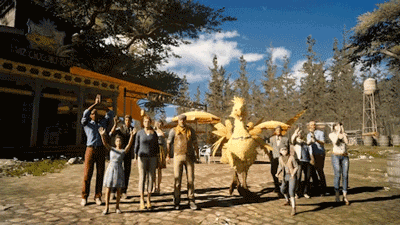
Chapter VII: Where the Chocobos Run
It had been a couple of hours since the company had taken to the road again, leaving Cor and Monica to their own back in Leide. Artemisia was concerned about their whereabouts and doings, but Noctis insisted that they shouldn’t worry about them; the two could handle themselves. So to distract herself, she focused on the wonders of the Duscae region. The wind blew through the five’s hair, the atmosphere much more tolerable than before. The scenery that was once filled with desert sand and a scarcity of vegetation was replaced with mixes of green as far as the horizon and trees just as tall. The air no longer threatened to dry one’s skin if they left the top down too long. Instead, it was moist and refreshing thanks to the abundance of water in the region, something that Leide was lacking. Although, the humidity was no doubt going to be the source of many complaints from Noctis and Prompto, worried about their hair getting limp or frizzy. Artemisia couldn’t help the small huff of amusement at the thought.
“Look out world!” Prompto declared loudly from the front, startling Artemisia from her thoughts. “Here we come!”
“We can finally leave this dust bowl behind,” Gladiolus said with breath of relief.
“The lands beyond are vast by comparison to Leide.” Ignis stated, keeping his ever vigilante eyes on the road.
“Bigger’s better!” Prompto claimed with a saccharine tone, “More stuff to see and do.”
“First comes Duscae, a region known for its wetlands.”
“Really? Wetlands?” Noctis raised a brow at Ignis’ comment, failing to see the excitement in mucky water and mushy grass that sinks if you step on it the wrong way.
“Wetlands are really cool, Noct!” Artemisia urged, nudging his arm insistently.
“I think you’re the only person I know who finds grass cool.”
“No really! From an ecological standpoint, they’re really interesting! They’re one of the most biologically diverse biomes in the world, which means that so many different types of organisms can live together --” Gladiolus watched Artemisia go on her enthusiastic lecture, occasionally listening in on what she was saying out of genuine interest, but mostly enjoying Noctis’ bored and desperate look for escape. “-- And they’re so important when it comes to naturally purifying water. But they’re also really sensitive to pollution, which means that scientists can see early effects of pollution by studying how it affects wetlan-- MMPH!”
Gladiolus quieted her by covering Artemisia’s mouth -- and almost her entire face -- with his hand, pulling her into a playful headlock against his chest. “Okay nerd, we get it.” He smirked when she half-heartedly glared up at him, relinquishing his hold on her and letting Artemisia straighten her posture back to normal.
“Besides the ever exciting ecosystems,” Ignis gave a teasing look to Artemisia from the rearview mirror, “There’s also a chocobo forest.”
“Now we’re talking!” Prompto chimed in.
“Further west lies the Cleigne region, where we’ll find the town of Lestallum.”
“Oh, isn’t that where Iris is heading?” Prompto ask, turning in his seat to look at Gladiolus, as did the other two in the back. Ever since Insomnia’s destruction Gladiolus’ worry over his sister had been obvious. The two had always been close, what with Gladiolus practically raising Iris himself due to their father’s work making him absent a lot. During the trip Artemisia had caught him texting who she assumed was Iris, noting that he had been texting more since the news of their home.
Gladiolus glanced down at his phone before looking back at the others, the usual strength in his eyes. “Barring delays, she should have arrived by now.” He sighed, looking off to the horizon, “Maybe even had herself a look at the meteor.”
“The Meteor of the Six?”
“The same,” Ignis answered Noctis, “Its heat is harnessed to power Lestallum.”
“Whoa, that sounds way cool!” Prompto said, his interest piqued.
Noctis nudged Artemisia. “You going to explain how that works?”
“Would you actually be interested in the complexities that go into making a meteor into electrical power for a whole city?”
“Probably not…”
“Then I’m not going to bother.” Artemisia huffed, a stubborn pout on her lips.
Gladiolus chuckled at the two. “I’m actually looking forward to this.”
After a while more on the road, Ignis spotted a gas station and suggested that they refill the tank. “It will be a long drive.” The group pulled into the station, parking the Regalia next to one of the gas tanks. Everyone exited the car and took a moment to stretch their muscles, having been stuck in the small space for a couple of hours. Artemisia offered to fill the tank while Ignis and Gladiolus visit the shop to buy more potions. Prompto insisted on Noctis posing for a photo, stating that their first steps into the unknown should be documented. One photo turned into another which turned into a whole photoshoot, with Prompto wandering around with his camera and snapping anything he could find interesting. Artemisia failed to see the general interest in a photo of her filling the car’s tank, but she wasn’t going to get in the way of an artist and his muse.
Artemisia had just returned the gas pump to its original place -- she didn’t understand why Noctis always has to grunt when he takes care of the gas; the pump wasn’t heavy -- when a ringtone from Noctis’ phone went off. “Who could this be?” Noctis answered the phone right as Gladiolus and Ignis returned. “Hello?” Gladiolus gave a slight jerk to his head towards Noctis while giving Artemisia questioning eyes. Artemisia could only shrug unknowingly. “Iris?”
That caught Gladiolus’ attention. Him and the rest waited patiently as Noctis continued his conversation. He soon ended the call with a quick “Will do.”
“Was that Iris?” Gladiolus asked, stepping closer to his friend. Gladiolus sighed once Noctis nodded, before crossing his arms and giving a small huff. “Can’t even call her own brother…”
“In all fairness,” Ignis interjected, “Yours wasn’t in the obituary broadcasted all over Lucis.”
“What about me?” Prompto questioned hopefully, “She say anything about me?
“Guys,” Artemisia laughed, “Don’t worry, you’re all beautiful. Now why don’t we get a move on so we can meet up with her.”
Gladiolus was quick to agree, packing away their purchases in the trunk so that they could get on the road again. Noctis was about to go take his usual seat when Prompto grabbed his shoulder and turned him around. “See that sign?” Prompto pointed out further down the road at a giant billboard. The board had a large yellow bird on it and read Wiz Chocobo Post. “Chocobos! Chocobos!” He chanted excitedly, his voice dripping with utter joy. The enthusiasm was contagious as Noctis’ eyes were filled with the same interest as his friend’s.
“Hey, no time for that,” Gladiolus quickly shot back, shutting the trunk with a satisfying thud. “We need to get to Lestallum.”
“It’s still ages away. C’mon, just a quick visit?” Prompto pleaded. He looked over at Artemisia with a quick turn of his head before dragging her to his side, making Artemisia blink in confusion. “Back me up, Artemis! One chocobo lover to another.”
“Uh…” Artemisia interrupted, “Actually, I’ve never seen a chocobo.”
Prompto gasped, dramatically grasping his shirt over his heart as though he had been shot. “What?!”
“Okay, even I’m surprised by that.” Gladiolus added.
“Well w-we have to go now!” Prompto insisted with urgency. “We can’t let her be deprived of the joys of chocobos! Twenty-one years of life and none of it spent with chocobos is a crime! C’mon Noct!”
Noctis shrugged, “He’s got a point.”
“Whoo hoo! Chocobos here we come!”
Artemisia glanced over at Gladiolus, seeing the concern for his sister still present in his eyes despite how he was trying to cover it up. He seemed willing to make the stop at the chocobo ranch, but he obviously wanted to get to Lestallum as fast as possible. “Let’s make it a quick trip at least, guys. We really should get to Lestallum soon,” she insisted.
“Deal! Now c’mon, let’s go!”
With Prompto ushering everyone back to the car, the group was on the road again. They followed the directions provided by the multiple signs along the road, arrows indicating what turns to take. The entire way Prompto was going every mile to display his excitement to see the giant, friendly birds. He had turned on a very hokey pokey song on the radio that was about the creatures with him humming along to it with lyrics like ‘I want to ride my chocobo all day’. It was after the others had asked him to stop his singing that Prompto turned to look at Artemisia in the back seat. “I can’t believe that you don’t know what chocobos are. I would have thought you would have been all over them.”
Artemisia pouted. “I know what chocobos are, I just haven’t gotten the chance to see one in person.” Her busy schedule didn’t leave much room for miscellaneous adventures or outings unless it was either with Ismene or Noctis. Those outings were also a rarity considering that Ismene focused more with academic studies and Noctis always had Gladiolus or Ignis with him as his entourage.
“Well that’s all about to change.” Prompto pointed at another sign, this one including the word Entrance on it. “Here we are!”
Driving off of the main road and down a dirt path, the group came upon the ranch. It was a quant little abode, with a small windmill and tiny picket fence nearby at the front -- most likely where the chicks would go. Behind that was the business building, where a small shop was placed for chocobo lovers to buy antiques, or feed for their feathery friends. In front of that were some umbrella tables for customers to enjoy a meal while watching the animals. To the left were some storage buildings where the birds’ food and water was most likely being held, and to the right were some posts where the birds would be tied to interact with any visitors. The only thing that was missing from this chocobo ranch were the actual chocobos. There was no hide nor feather of the creatures; it’s hardly possible for them to be hiding, the birds were larger than most people.
“Odd…” Ignis mumbled.
“Do you think that they’re closed?” Artemisia asked.
“No way, chocobo ranches don’t close.” Prompto confidently answered. “Maybe they’re just giving them a break from the crowd. It’s hard being a celebrity, y’know.” Prompto joked, gesturing for the others to follow him. “C’mon, let’s go get us some chocobos.” The group followed him to this older man who was working around the meal tables. “ ‘Scuse me,” the man turned around after hearing Prompto’s voice, a name badge on his outfit reading Rancher Wiz. “We’d like to ride the chocobos.”
“The chocobos, huh?” Wiz sighed, a disappointed frown on his face. “I hate to break this to y’all but we can’t permit our birds to leave the post, not while Deadeye’s still about.”
“Deadeye?” Artemisia questioned.
Wiz nodded. “He’s an uncommonly ferocious behemoth that’s taken to prowlin’ these parts of late. His scent makes our birds nervous, and to prevent accidents or tragedies, we have no choice but to suspend rentals.”
“Aw man,” Prompto pouted degernatedly. Noctis also looked incredibly disappointed at the situation. Artemisia rubbed Prompto’s shoulder, trying to comfort him. “I’m sorry guys, but we can always come back later. Hopefully the behemoth will move on.” Wiz stared at the group inquizitively, his eyes narrow in thought before it dawned on him. “Hold on now, ain’t you the hunters that’ve been makin’ a mark?”
The five looked at each other confused, unaware of their recent claims to notoriety. “It would seem so…” Ignis answered.
Wiz tore down a flyer from the nearby notice board where bounties for hunts were presented and handed it to Noctis. It had a rough photo of a behemoth on it and a listing of a reward for the creature dubbed Deadeye. “You reckon you could handle the likes of Deadeye?” Noctis showed the others the bounty, “If you could bring the beast down, there’d be a reward in it for ya.” The group was always in need of more money, that’s for sure. “But knowin’ the danger, I wouldn’t blame ya for saying no.”
“What do you guys think?” Noctis asked, though his smile showed that his mind was already set. “We up for it?”
Gladiolus smirked. “Go big or go home, right?”
“Rest assured,” Ignis directed at Wiz, “You nor your birds will have none to fear once we are done.”
Wiz thanked them for their courageous service, giving directions on where the beast was last seen on Artemisia’s map. Once the group felt like they had everything they needed to know, they set out in the dense woods beyond the ranch. They followed the small dirt path through the forest until the path started to disappear as they moved further in. The edge of the trail was overridden by grass and weed due to the lack of explorers that venture out that far. So the group had to rely on any signs of the beast that they could find to direct them.
“Are we sure we’re going the right way?” Prompto asked, no doubt the ominous atmosphere of the forest making him nervous. The trees were so large and close together that it barely allowed any sunlight to shine through the collection of leafs at the top. And with the knowledge of a famously dangerous creature prowling the area, Artemisia couldn’t blame him for feeling intimidated.
Gladiolus, who was at the front of the group, took in the area before confirming “Oh yeah, we’re heading the right direction.” He gestured to large claw marks that were left in the large rock formation to their left. Prompto gulped at the sight.
Suddenly a blood curdling howl echoed through the area, the group flinching at the sound. “The hell?” Gladiolus growled, reframing from summoning his weapon but ready for action if need be. Birds flew above them as the sound of trees breaking and falling to the ground followed the howl. “Something’s amiss.” Ignis said, his guard up as well.
“We’re getting closer. Everyone stick together.” Artemisia instructed, slowly walking ahead as the others followed.
As the group traveled deeper into the forest they found more evidence of the behemoth’s presence. Claw marks and broken trees littered the ground, and growls echoed out as they walked, each one louder than the other. Artemisia decided not to the alert the others to a small pool of dried blood that she saw, not wanting to put them on edge even more; though her heartbeat definitely picked up after the sight. The further they traveled into the forest -- and closer to Deadeye -- the area became encased in fog, making visibility poor.
“So, Artemis,” Prompto walked closer to her, “as our residential beast master,” Artemisia wasn’t sure if she considered herself that, “got any advice for us?”
“Well… from what I understand, behemoths rely heavily on their sight and sense of smell since their hearing is horrible. And if the name implies, the fact that this one has a bad eye is actually a small advantage for us.” Another crash from a falling tree sounded out. “And we’ll definitely hear it coming before it hears us.” Prompto gave a weak smile, not sure if she helped his nerves or not.
“Don’t worry, Artemis isn’t gonna let us get eaten.” Noctis reassured, confidence all over his expression. “She’s got this.”
“Uh… Right.”
What am I suppose to do I can’t stop a claw that weighs over a ton from slicing right through you better hope that you see it first because you can’t outrun that thing oh by the Six that thing could snatch Noct out of the air with its giant teeth without a second thought if he’s not fast enough oh Astrals why did we do this why did we do this
They followed what evidence of the behemoth they could find through the fog, coming upon a small man-made cavern created by a huge, abandoned construction pipe. It was big enough for someone to crawl through, if one was willing to uncomfortably arch their back or scrape their boney knees on a hard surface that will more than likely result in bruising. Not to mention the idea of being trapped in a small space with a ginormous predator on the prowl wasn’t a pleasant one. But there was no way forward that didn’t involve going through the pipe, so it’s a risk they’ll have to take.
“Noct, wait!” Noctis was about to be the first to enter the pipe when another roar from Deadeye rang, this time it was close enough that the growl vibrated through the metal under Noctis’ hand. Gladiolus had stopped the prince in his tracks, holding his arm out in a protective stance to keep Noctis back from the potential danger. He looked into the dark pipe, investigating for any sign of the beast that was nearby. Artemisia poked her head under his arm to look too, only seeing some vegetation that was able to grow inside the pipe despite the small amount of sunlight. She gulped, taking a deep inhale of breath before slowly exhaling and ducking under the taller man’s arm and heading in first. “Hey,” Gladiolus whispered, urging her to come back behind him. Another growl vibrating down the pipe silenced them. Artemisia waited until it was quiet again, making sure the behemoth had moved on before looking back to the others and gesturing for them to follow. “Stay close.”
Gladiolus released a frustrated huff of air before following her, with the others close behind him. They crawled down the tight clearing, turning along with path. The pipe lead out to another small cavern, this one created with sheets of metal acting as a barrier around them. Whatever they were planning on making here that included such an uncomfortable walking space Artemisia had no clue. She was thankful for the bit of cover though, no matter how much it has degraded over time. Artemisia looked back at the others, checking on them when she heard heavy footsteps coming closer. She jumped forward to the other side of a small hole to where secure cover was, giving Gladiolus a signal to stay put.
“Hold up,” Gladiolus instructed. Soon a behemoth stood just inches away from the group, letting out a roar as it sniffed the air. The beast’s right eye had a scar going down its face and its eye was clouded over, no longer useful. “Deadeye,” Gladiolus pointed to his own eye, “The name says it all.”
Deadeye sniffed their direction inquisitively. Artemisia worried that they had been found before the behemoth looked away, grabbing something in its jaws and starting to feast on it. Based off of the sounds of muscle tearing and bones breaking, Artemisia had an idea as to what preoccupied the beast’s focus for now. She let out a shaky sigh, thankful that it wasn’t one of them. She glanced over to check on the gorging animal before waving her hand in a motion to follow her. Gladiolus nodded, giving the others the same instructions.
The group slowly started to crawl passed the giant beast as it ate, being cautious as to not tip off Deadeye to their presence. Artemisia peeked back to double check that it was still distracted before she started to move ahead, another large hole above her as the protective metal sheets were no longer there. As she crawled she noticed the end of tunnel, breathing a quick sigh of relief.
“Artemis!”
Artemisia whipped her head around when she heard the alarm in Noctis’ voice, seeing the large teeth coming down towards her at the last second. Before Deadeye’s jaws could clamp down on her person she was tackled out of the way, soon finding herself face down in the dirt with a large weight on top of her. Her protests were muffled by the soil as she pawed at the hand on top of her head, taking in a deep breath and spitting out grass once she finally was able to lift it off. “Gladi--”
Gladiolus shushed her, caging her under him as he stared ahead. Artemisia held her breath when she noticed how close Deadeye’s blood stained teeth were as it sniffed down into the tunnel. She could smell its putrid breath, a nauseous mix of the creature’s mouth bacteria and the remains of its recent kill. Noctis and the others were on the other side, eyes wide and frozen to their spots. Ignis had his hand over Prompto’s mouth to keep the blonde from screaming.
Deadeye removed its jaws from the hole and roared above it, splats of its saliva hitting the five’s faces as its breath sent their hair back. It inspected the area once more before walking away with a low growl. Artemisia released the air she didn’t know she was holding once the beast was gone, taking deep breaths to calm her rapid heartbeat.
“Thanks for the save.”
“Don’t mention it.”
“...” She squirmed uncomfortably under him. “Could you get off of me now?”
“Oh,” Gladiolus flinched, realizing how awkward her position was before carefully crawling off, “Sorry.”
The group made it to the tunnel’s end, Artemisia peeking outside first to make sure the behemoth wasn’t closeby before exiting. Everyone stretched once out, their limbs sore from being in such a restricting space. Another familiar growl interrupted the small moment of relief, the group being on the defensive once again as they moved on. This area of the forest had even worse fog than before, reducing visibility to only several feet.
“It’s weak on its right,” Gladiolus informed, “No eye, no horn.”
“We’ll stay in range until we can exploit its blind spot.” Ignis instructed as they carefully moved through the mist.
They moved onward, following the sounds of the beast. The group came upon a clearing of the forest that had large boulders laid out around the area; most likely the rocks had come down from the nearby cliff side, or perhaps Deadeye had moved them there itself. Moving closer, they saw a shadow move amongst the rubble, revealing a tail as the shadow moved. “We got the beast in our sights.”
“But no plan of attack,” Ignis added to Gladiolus’ comment, “The behemoth should be heading back to its lair, where we can catch it fully off guard.”
“Yeah,” Noctis grumbled, “As long as we stay on guard ourselves.”
“If we stay to its right and use the rocks and trees for cover, we should be able to follow it unseen.” Artemisia added. Agreeing, Ignis took the front, leading the group through the mist. He carefully navigated the group close behind Deadeye, using the beast’s tail as an indication to the creature’s location. There were a few times that the creature’s tail was almost within reach, close enough for someone to reach out with their hand. One false move, one accidental brush and the beast would know they were there. One eye or not, the five would be easily taken down by the giant in the thick fog.
The group was in the middle of crossing the clearing, hopping behind cover from one large rock to the other when the behemoth stopped in its tracks. Gladiolus and Prompto hurried over to cover with Ignis, but Artemisia froze in the middle of the clearing as the beast sniffed the air. A deep growl vibrated down its throat as it turned to its right, looking with its good eye. Artemisia pushed Noctis back behind the previous boulder, avoiding Deadeye’s view in time. Deadeye approached them, its large head sniffing the clearing where Artemisia stood just a moment ago. Ignis and the others moved to avoid its left eye, but Artemisia and Noctis stood still as it continued to sniff out their scent.
Artemisia held her breath as she guided Noctis to walk backwards with a gentle push of her hand against his chest. They stayed light on their feet as they backed away, trying not to disturb anything that would give them away. The water in the air must of made finding their individual scent difficult to track as the behemoth took its time.
With one more big sniff, Deadeye slowly turning its head towards the two stranded friends.
Except there was no prey.
Noctis, in the nick of time, had pulled Artemisia down with him into a large patch of tall grass. The two laid on their stomachs, completely engulfed by the long whisks of turf.
The behemoth growled, searching for what had caused the faint scent it had caught, baring its teeth before huffing out through its nose. Seeming to have given up on the hunt, the beast turned around and continue onward to its lair. Artemisia and Noctis slowly rose from their hiding spot once the predator left, disappearing into the fog. The two hurried across to join the others.
“Are you alright?” Ignis asked, brushing them both off the best he could.
“Yeah, we’re good…” Noctis shivered.
“J-Just… really cold now.” Artemisia trembled, trying to stop her teeth from chattering. In the heat of the moment the two failed to see the large amount of mud accumulating in the patch of grass they hid in. Now that they were no longer fearing for their lives, they suddenly became very aware of the chilling muck now plastered to their uniforms.
“At least you’re alive.” Prompto tried to brighten their spirits, though there wasn’t much he could do besides possibly hugging them to warm them up. But he’d rather not get any of that on himself.
“Once we get back to the post we’ll see if Wiz would be kind enough to lend us a washing machine.” Ignis said handing the two handkerchiefs to wipe the mud off their faces. “If they have one, that is.”
“Until then you’ll have to warm yourself up with the heat of battle.”
They both whined at Gladiolus.
The two tried to clean themselves off the best they could with what they had before moving on to find Deadeye, baring with the uncomfortable sensation of their slick clothes sticking to their bodies. When they last checked, Deadeye had hopped over a wall of rock formations before disappearing into the mist. The group followed, squeezing through a tight crevice through the rocks. Once through to the other side the five found themselves in an abandoned, decrepit building. The metal foundation bars of the would-be structure were exposed now due to the decaying concrete falling off its support. Even the entryway was nothing more than an outline of where a door would be. From the there, the company hopped down to lower terrain in what looks like a potential future storage room. Now, all that remained was an wide open area where the behemoth -- who had to be close due to the audible hisses -- decided to make his home.
They stepped carefully, investigating the tree line for any movement that indicated their target. As they moved cautiously, the mist had slowly started to dissipate, allowing Artemisia to notice several barrels sprawled around the area. Noctis had accidentally walked next to one and looked it over before flinching back as though the object had burned him. “Heads up,” Noctis announced, pointing to a caution sign on the barrel. “The barrels are flammable.”
“Eyes forward,” Gladiolus said, pointing to the forest in the distance. Trees snapped as a hulking figure moved through the woods, a familiar one eye zoning in on the group of friends. “We got company.”
The behemoth let out a blood curdling roar, baring its teeth as it leaped down to their level and crushed a barrel with its claws. The oil broke free and stained Deadeye’s foot. Noctis motioned for everyone to step back once they summoned their weapons, breaking out a magical flask filled with elemental fire magic. He chucked the flask at Deadeye’s slick foot, the fire igniting the oil on the beast and catching its clawed paw in flames. Deadeye cried out at the pain, stomping its foot against the ground to kill the fire. The weak fire only seemed to have agitated the creature more as it charged at the group with no hesitation.
The team separated, avoiding the lunging beast. Deadeye turned mid landing, causing it to skid until it hit what remained of one of the walls of the would be storage area. Some of the concrete fell on top of the behemoth, aggravating it even more. The bad landing had caused Deadeye to destroy more barrels, spraying more flammable grease on its body and causing the predator to slip before charging again.
Everyone scurried away from the rampaging beast like mice avoiding the prowling feline; ironically fitting. Deadeye ran after the group, changing its focus from person to person depending on who was closest. Noctis warped away from its attack while Prompto fired at it as he ran, frantically calling for help. “Prompto!” Gladiolus signalled his friend, charging his direction with his sword at the ready. Deadeye’s jaws almost caught Prompto before he fell to the ground, skidding under Gladiolus’ sword before he brought it up in a uppercut, slicing the behemoth’s face. Noctis warped on to the back of Deadeye’s neck, stabbing the muscle with his longsword. Deadeye roared and reared back on its hind legs, sending Noctis flying back despite his best attempts to stay on.
“Noct!” Artemisia and Ignis ran to their fallen friend, helping him up. “Are you okay?”
Noctis pushed away Ignis’ worried hands, forcing himself up. “I’m fine… Would have been better if it had gone down with that first barrel.”
“Your idea was in the right direction,” Ignis assured, “Unfortunately, it didn’t have the impact that we were hoping for.”
“We need more firepower if we’re going to take it down.” Artemisia looked over to where Deadeye had originally slipped, oil everywhere and a huge dent in the unfinished wall with small plates of concrete falling off. Ignis followed her line of sight, taking in the setting too before the two nodded to each other. “Noct,” Artemisia put her hand on his shoulder, “We need you and Gladio to keep it busy while we set up.”
“That’s a big order just for the two of us.” Noctis complained. “What are you setting up for?”
“Why for your original plan to flourish, of course.” Ignis explained, “You and Gladio will keep the beast distracted while we collect more barrels. Once we have enough the two of you will corral it to the spot and then--”
“Boom.”
“Precisely.”
Gladiolus summoned his shield, his only barrier against Deadeye’s claws pushing down on him. “Make it quick.” Noctis groaned before warping at the beast again to help his struggling companion. Ignis and Artemisia hurried to collect what they needed, grabbing Prompto to help. They dodged the hulking behemoth as they ran back and forth, carrying the bins over to the targeted area against the wall. Gladiolus and Noctis kept the beast off of their busy friends, baiting it away from the others and trying to survive in the meantime.
“Whoops!” Prompto rolled the last barrel over, accidentally kicking it over and spilling the contents onto the ground.
“Don’t worry, we should be good to go.” Artemisia secured a barrel against the wall, signalling Ignis. Ignis nodded, joining Noctis and Gladiolus with his daggers ready while Artemisia and Prompto secured themselves on higher terrain. “Corral the beast back against the wall. Artemis and Prompto are at the ready.”
Following the Strategist’s orders, the three men gradually forced the beast back towards the targeted area. The pooled oil was making Deadeye’s feet unsteady and the fluid was coating most of the creature’s body due to its thrashful movements as it fought back. Gladiolus forced Deadeye back against the wall with a strong push from his shield, surrounding the beast with the collected barrels. “Now!” Ignis yelled out to their far ranged companions as he, Noctis and Gladiolus hurried away from oil.
Artemisia smashed a fire flask against her crossbow, encasing her arrows in the magic before Prompto and her shot down at the barrels. Two explosions rang out before they caused a chain of explosions from all of the barrels, throwing Deadeye against the wall behind it. Deadeye cried out in pain as its whole body was engulfed in flames, the oil luring the rampant fire like food for a starving animal. Despite Deadeye’s attempts to run away from the fire, the ground was still soaked and in its frenzy Deadeye couldn’t manage to control its legs well enough to escape the burning pain raking up its body. Artemisia couldn’t help the sympathetic grimace, turning her head away from the scene. If her and Prompto could feel the heat from their perch, she could only imagine what agony the poor creature was in.
Soon the oil was all burned away, scorches left on the ground where grass once was. Deadeye, just barely standing, was covered in horrendous burns and embers still lingered on it. Deadeye breathed heavily as it tried to force itself upright but its legs were burned beyond use, having taken the brunt force of the fire. Noctis, Ignis and Gladiolus approached the pained creature, their weapons still on their persons. Deadeye growled at them, defensive in its weakened state.
With what strength the behemoth had left, it let out another mighty roar, trying to intimidate the others away. Rubble from the wall fell on top of its head, with bigger chunks starting to come down on Deadeye’s head. The explosion had created a deep crack in the wall’s concrete and Deadeye’s roar vibrated up the weakened structure. The wall broke apart, all of the concrete falling on Deadeye.
A large dust cloud erupted, hiding Deadeye and stinging everyone else’s eyes as the impact kicked up dirt. Noctis and the other two rubbed their eyes, blinking away the debris. The dust started to clear, revealing what was left from the collapse. A large claw laid motionless under a hill of rubble, all signs of life absent.
“Magnificent,” Ignis sighed, dusting himself off. Artemisia and Prompto joined the others on the ground, the three taking a moment to breathe. “Nicely done you two. We’ve taken down the target without nary a flame on ourselves.”
“I’m honestly surprised that we didn’t,” Gladiolus touched his forehead lightly, “Pretty sure the tips of my eyebrows burned off.”
“Huh, sounds like that would an improvement to me.” Noctis joked, him and Prompto laughing at his little jab at the big man’s equally burly brows. Gladiolus raised one of said brows, staring down at the laughing two. With a flick of the wrist he pushed the prince, causing Noctis to fall again into the wet dirt below him with a splat. Now it was Gladiolus’ turn for a laugh; Prompto quickly redirected his laughter at his bestie. Meanwhile, Ignis and Artemisia looked on like two tired parents with their rowdy kids. Noctis lifted himself up from the muck with a groan, the earlier discomfort from the first layer of mud coming back ten fold. Artemisia felt an empathetic chill go up her arms; the fight hadn’t warmed her up as much as Gladiolus had said it would. If anything the addition of sweat and the diminishing effects of adrenaline made her feel even colder.
Ignis sighed as he helped Noctis off the ground. “Now you’ll really need to bathe.”
We all do…
Noctis tried to wipe off the dirt on him, only spreading it across his face. “Then we should get back now.”
They could all agree to that.
By the time the group made their way back to the chocobo ranch, the sun had made its slow descent down the horizon, coloring the sky in blues and pinks. Hopefully Wiz would still allow them to see the chocobos despite the early evening sun. Artemisia wasn’t sure what time chocobos usually fall asleep but if Prompto didn’t get to pet some chocobos today, the poor boy might cry. He had been singing the earlier chocobo song almost the entire walk back, the excitement in his eyes overflowing.
Wiz noticed the group coming, meeting them by an umbrella table. He looked at them expectantly, waiting to see what news they brought with their arrival. Artemisia reached into her small belt pouch, handing Wiz a small chip of the dead behemoth’s claw. Wiz’s face broke into a giant smile. “Ya guys did it! You took down Deadeye! The area’s safe again an’ we owe it all to you.” He took Noctis’ hand, not minding the dirt and grim on it, and gave it a firm shake. “On behalf of the locals, I give ya my heartfelt thanks.”
“So…” Prompto scooted forward, “About the chocobos…”
Wiz laughed. “Our birds are at your disposal. You can rent them any time you like.”
“Can we ride some now?”
Wiz hummed, looking at the clock on his wrist before tipping his hat. “I reckon there’s enough time before dark for our heroes to get a few laps in. Let me get some out for ya.” He snapped his fingers. “In fact, since y’all risked so much for us, why don’t ya stay the night at the caravan and have some supper with me and the others? My treat.”
The five were quick to accept the offer; who were they to decline free food and a warm place to sleep. “We appreciate your hospitality.” Ignis thanked him. “If we could trouble you with another thing.” He presented Noctis and Artemisia in their dirty state. “Do you have a washer we could borrow?”
Wiz laughed. “Son, we live on a chocobo ranch. ‘F we didn’t have some kind of machine we wouldn’t look much different than the chocobos themselves. I’ll find you two some clothes to borrow while we throw those in for a cleanin’.” He looked at Prompto. “And I’ll see about those chocobos.”
“Alright!” Prompto squealed, practically jumping with joy. Artemisia envied his enthusiasm, the chill from her dirty clothes making her feel lethargic.
“Gallina!” Wiz called out, peeking through a door that led to the chocobo stalls. “We’re gonna need five birds. Do you have any spare clothes, too?” Him and this Gallina continued talking through the door before a loud kweh rang out. Soon a train of squawking and kwehs followed the first. Prompto grabbed Artemisia, forgetting about the crusty mud on her, and pulled her closer to the small pasture for the birds. “Get ready to be amazed, Artemis!”
Quick flashes of yellow ran past Artemisia’s eyes, all squawking and feathers abundant. Five of the giant birds ran together along the fence that caged them in the pasture, flapping their small wings excitedly as though to simulate flying. A few were leaping into the air, almost skipping as they ran. The birds were big enough that they could easily jump over the fence and run off if they wanted to, but they seemed more than happy to stay in their enclosure. “No jumping!” A woman’s voice called out to the birds. “One of you is gonna fall over the fence again and then no one will be happy.”
The woman walked out of the stall into the pasture; she must be the woman that Wiz was talking to. The woman, Gallina, definitely looked like someone who dealt with chocobos. While she was nowhere near Gladiolus’ muscle definition, she had a solid build with strong shoulders and thick limbs that no doubt could handle a thrashing chocobo. She had her giant, wild hair tied back in a ponytail that reached her rear, pieces of hay and various greens sticking out occasionally. And despite her uniform, there were various visible scars on her person, the most obvious and painful looking ones were the many that covered the majority of her face. Artemisia had never thought of chocobos as violent creatures but even the most tamed animals could be dangerous, especially the ones the tower over most people and were equipped with sharp talons.
Gallina walked over to the group, leaning against the fence. “You the group that Wiz said took down Deadeye?” The five nodded. “Well thanks for that. You have no idea how antsy the birds were the entire time that beast was around.” She looked back at the birds, some were still running in circles while a few ruffled their feathers against the grass, causing their feathers to puff up adorably. “All of that,” she pointed at the happy birds, “Is thanks to you guys.” She opened the hatch on the fence, opening the small gate. “So you ready to ride them?”
“Oh yeah we are!”
Ignis held back the excited Noctis by the back of his neck line. “My apologies, but these two need to bathe first.” He gestured to Artemisia as well.
Gallina blinked. “Oh! That’s why Wiz was asking about uniforms.” She started walking back to the stalls. “Give me one minute and I’ll set you up with a clean pair of clothes.” She was gone for a moment before coming back out with two sets of absurdly yellow clothes. “I know they’re not exactly high fashion, but they’re comfy. I can take your other clothes once you two are done showering. In the meantime,” she looked down at Prompto, who was giving her the biggest sad puppy eyes ever, “The rest of you are welcome to the birds.”
Prompto practically ran into the pen, chanting the birds over to get their attention. Gallina laughed at his enthusiasm; he was fitting in with the chocobos nicely.
“Noct, do you need any assistance?”
“With showering?” Noctis scoffed at Ignis. “I’m not a baby. It’s not like I’m gonna drown in there.”
“Stranger deaths have happened.” Ignis muttered before casually following Prompto. “Just be sure to clean thoroughly.”
A tint of embarrassment colored Noctis’ cheeks as he coughed awkwardly. He looked at Artemisia and vomited out a quick “I’m showering first” before dashing to the caravan before Artemisia could even react.
Artemisia sighed, rubbing her hands over her arms in an effort to warm herself. She couldn’t be mad at him for rushing for the shower, he was twice as dirty as she was. Unfortunately that meant she was going to have to wait until he was done. While her small stature was useful for combat, it wasn’t the best at keeping herself warm. No doubt Noctis was going to soak up the caravan’s limited hot water, too. She felt like it was fair enough for her to be peeved about that.
She suddenly felt a warm weight on top of her shoulders. She looked down and saw Gladiolus’ leather Crownsguard jacket draped over her shoulders, the size difference hilariously noticeable. She looked at Gladiolus, who’s decorated torso was now bare for all to see. “Thanks, but won’t you be cold too?”
“Don’t worry about it, I got my shirt in the trunk.” He assured, patting her on the head before walking away to where the Regalia was parked. Artemisia could see the many stares by the various ranch workers directed at him as the man walked past them to the car. He didn’t seem to mind, especially since the flustered stares and embarrassed giggles only boosted his ego more.
“Heh...”
Artemisia looked back at Gallina, who was leaning on the fence and supporting her head with her hand against her cheek. She had a giant grin on her scared face, directing it at the red head before her. Artemisia blinked curiously. “What?”
“Oh nothing, nothing,” Gallina chuckled. “Hey, we have a couple of showers inside if you want to use one of them. Better than standing around cold, right?”
“Yes, thank you!”
Gallina called for another post worker to watch the chocobos with Prompto and Ignis before she led Artemisia inside. They passed by the few other chocobos that remained in their stalls, Gallina petting them on the heads as they continued. “This your first time here?”
“Yeah, first time with chocobos too.” Artemisia admitted.
“Really?” Gallina looked back at Artemisia over her shoulder. “Huh… Well there’s a first for everything.” Gallina grinned at the smaller woman, her lips clipped by the healed scars on her face. “Don’t worry, I know these birds like the back of my hand. I’ll set you up with the perfect one for you.”
“Have you worked here for a long time?”
“Here: No,” Gallina said, holding a door open for Artemisia. “My family owned our own chocobo ranch in Galahd before we had to move to Insomnia.” Artemisia perked up at the name of her home. “Lived there for a while but then… Well, you know, recent events.” Artemisia’s mood dropped and based off of Gallina’s tone she wasn’t the only one who was feeling for their home, even if it was only temporary for one of them. “We moved out here and been working for Wiz since.” She smiled at Artemisia again. “I will say, Insomnia was never really home for me, but it is nice to see that refugees like you guys seem to be doing okay.”
Artemisia felt a different kind of chill go up her spine. “Was it that obvious?”
“Heh, I know those city clothes anywhere. Insomnian clothes stick out like a sore thumb compared to what most people out here wear.”
“Ah…”
As long as she doesn’t know about Noctis being the new king we’re fine. As nice as these people are, the group couldn’t risk Noctis’ security.
Gallina had her hand on a door knob before she looked at Artemisia again, tilting her head curiously. “But I don’t think I’ve seen those type of clothes very much, even in Insomnia. Were you guys Crownsguard or something?”
Crap!
“Oh no, it’s just a fashion statement.” Artemisia lied, keeping her voice even. “Going for that quirky, punk-rock look. The guys are really into that sort of thing and I just do it so that they don’t look too ridiculous, y’know?”
Gallina stared at Artemisia with a raised brow before shrugging and opening the door to a communal bathroom with a couple of stalled showers. “There’s soap and standard hair products in all of the showers and there’s a bench to lay out your clothes on. Once you’re done showering, you can hand me your dirty ones and I’ll throw them in the wash.” Artemisia thanked her and scurried in, eager to wash herself off of all the grime plastered to her.
After a enjoying her shower -- it was nice not having to worry about one of the guys accidentally walking in on her again -- she changed into the spare clothes that Gallina had left for her. While the outfit was a bit much, what with the shirt being brightly yellow and the small chocobo mascot advertising the ranch, it was better than her having to wear what spare clothes she had. Those clothes were beyond appropriate for a ranch setting and would surely be ruined with all the dirt and chocobo feathers. At least this uniform was comfortable, definitely the kind of material working people would prefer.
Leaving the bathroom, Artemisia went back to the pasture and found Gallina over by the fence, watching Prompto and Ignis interact with the birds. The woman greeted Artemisia when she saw her and took her mud covered clothes. “I’ll be right back and then I’ll set you up with your chocobo.”
Artemisia was about to thank her as the other woman walked away when an awkward cough behind her caught her attention. She looked back and had to stop herself from laughing. Noctis stood there, cheeks red, next to Gladiolus in a ridiculous outfit that differed from her own. This one seemed to have been some kind of festival uniform, the words Moogle Chocobo Carnival written on the torso and the back. It had a picture of a chocobo being ridden by some kind of alien, fairy, devil creature, if such a thing existed. She supposed that it was a moogle, as stated by the shirt. The colors on his shirt, with closer inspection, were just extreme close ups of the two festival subjects’ faces, coloring the shirt yellow, white, pink and orange. The best part of it was the hat that Gladiolus kept insisting Noctis to wear despite his protests. It had a chocobo’s face on the front with little wings sticking out on the sides, and a moogle’s face on the back with an antenna standing up on top. It was all absurdly wonderful.
“Don’t. Say. A thing.” Noctis emphasized, swiping the comedic hat off after Gladiolus put it on him again.
“I don’t know what you mean,” Artemisia giggled, a big amused grin on her face. “You look… stunning.” Noctis groaned, pushing Gladiolus off of him as the bigger man continued to annoy him. “Come on,” the embarrassed man insistently pushed the two into the pen towards the chocobos, ignoring the looks Ignis and Prompto gave him once the three joined them. A rancher had set up a saddle on to Prompto’s chocobo and now the blonde was getting ready for a ride. But it seemed like the chocobo wanted to play a game of tag instead as it lightly pecked Prompto on the head before running off, running circles around the man playfully. The rancher was obviously frustrated that the bird wasn’t behaving and tried to make it stand still while Prompto took some slightly dazed but loving photos of the silly bird.
“Alright the clothes are washi-- What’s going on?” Gallina returned and saw the little spectacle before her. The excited chocobo had gotten a couple of the other birds to join in on its game of chase and the other rancher begged for her to help get them all settled. Gallina sighed, muttering “This is what happens when they’re stuck in their pens for too long…” before joining the fray. She grabbed the reins from the main chocobo as it ran by her, stopping it in its tracks with a yank. The other worker wouldn’t have been able to stop the giant bird with just the reins, but Gallina’s build wasn’t for nothing.
“You,” she tapped the bird’s beak and pointed at it like a mom disciplining her child, “need to stop that, mister. You’ll get to run around in a minute.” The bird leaned forward and starting nuzzling into her neck, shaking its head side to side that made her own move in response. Gallina patted it on its neck before pushing it back once she felt the bird’s beak pecking through her hair. She gave the reins over to the other worker and calmed down the other two excitable birds in a similar fashion. Once all of them had settled down she guided them over to the group of five.
The birds walked over to the guys, introducing themselves to their new riders with little actions of affection. Gladiolus’ chocobo flapped its wings happily after Gladiolus patted it on the head before trying to return the favor and laying its own head on top of his, making a noise almost similar to a purr. Ignis’ bird was the most calm in its greeting, sniffing Ignis curiously before chirping in hello, to which Ignis rewarded it with some satisfying chin scratches. Prompto’s bird finally decided to behave and stand still so Prompto could love on it. Prompto was enthusiastically fluffing the bird’s feathers, rubbing his hands all over it and giving it little scratches. The bird responded with another peck to his head, which must be that bird’s odd way of showing affection. Noctis’ bird acted aloof when Noctis tried to coo the bird closer, only to to start begging for attention when Noctis looked away in defeat. Artemisia giggled at how perfect the combinations for everyone were.
“Artemisia,” Gallina nudged her, guiding Artemisia to the last chocobo as the guys started to situate themselves on their chocobos’ saddles. The last chocobo was sitting in the grass still, perking up when it saw them approach. “This is Dottie,” Gallina patted the sitting chocobo on the head. “She’s your chocobo. She’s super patient and she’s the one that most first riders go with. She’ll be perfect for you.” Dottie shook, ruffling her feathers before standing up and looking at Artemisia expectactly. Artemisia hesitated, standing a distance away from the bird. She knew that chocobos were usually super friendly and tame, but she couldn’t help but be nervous. “Come on,” Gallina urged, waving for her to move closer. “She’s not gonna do anything.”
Artemisia approached slowly, holding her hand out for the bird to smell as she came within reach. The large bird sniffed her hand inquisitively, sneezing lightly -- Or at least as lightly as a giant chocobo can -- making Artemisia flinch her hand back slightly. Dottie let out a little “Kweh!” before bumping its head against Artemisia’s hand, requesting to be petted. Artemisia let out a small sigh of relief, happy to see their first introduction went well and indulged herself in the sensation of the charming chocobo. Dottie’s bright feathers were incredibly soft and acted a lot like fur with the way it responded to be to touch; when she ruffled them it only made it more convincing.
“She’ll keep ya safe when you guys are out and about.” Gallina stated, watching the two bond. She laughed when Dottie forced herself forward to wrap her long neck around Artemisia’s shoulder in a hug. “Aw, see! She likes you.”
Artemisia chuckled at the cute display of affection, smoothing Dottie’s neck feathers in return. She heard a small click and looked over her shoulder to see Prompto with his camera in hand and a giant grin on his face. “Gotta capture the moment!” He proclaimed happily. “Oh. Em. Gee. Cutest bird ever!” Prompto proclaimed, referring to the photo he had just taken of the two. His bird immediately bucked him a little with a sharp squawk, almost like it was insulted that he wasn’t admiring its looks instead.
“We got a course ready for you kids if ya wanna race before nightfall.” Wiz informed, leaning against the otherside of the fence.
Prompto was urging Artemisia to hurry up and board her chocobo, eager to get some racing in. “How about a little competition?” Noctis offered with a confident grin. “The person with the best time gets to sleep on the bed in the caravan.” The caravans only had one queen sized bed, and while they weren’t the highest quality, they were still preferred to the rickety pull out futon.
“You can’t occupy an entire bed to yourself, Noct. You must share the other side.” Ignis interjected sternly.
Noctis sighed, a defeated frown on his face. “Fine…”
“But what’s a competition without a little wager.”
“Heh, I’m down for that.” Considering Gladiolus’ size it’s no guessing why he would prefer sleeping on the big bed instead of the futon.
“Oh yeah!” Prompto laughed over at Artemisia who was having a hard time getting on her bird’s saddle. “Come on Artemis! Don’t want to be left in the dust.”
Gallina helped lift Artemisia the rest of the way over her chocobo, giving Dottie a few secure pats as the rider fixed herself. “Just a heads up,” Gallina whispered in Artemisia’s ear, “Dottie hates losing.” She winked.
In the end, it was Prompto who was sleeping in the bed with a happily full stomach thanks to Wiz’s cooking. And despite the others’ losses, everyone was able to enjoy their time and had some much need laughter amongst themselves and the new friends they found on the ranch.
Though Noctis was a bit insulted that Prompto wanted to share the bed with Artemisia instead of him.
#stand by me fanfic#ffxv fanfic#ffxv oc#ffxv game rewrite#chocobros x oc#gladiolus amicitia#noctis lucis caelum#ignis scientia#prompto argentum#artemisia thanos
13 notes
·
View notes
Text
Top Places to Visit in Finland

The last time Kati and I were in Finland, we were standing in 5 feet of snow looking for the Northern Lights. It was a cold, bitter winter night and the only thing that got us through was eating reindeer stew along the road. It warmed us up and kept us going. But Finland is a lot more than just the Northern Lights. Finland is a land of incredible lush green sights, long lakes, and vast seas. The country is home to a record 179,584 Islands and 188,000 lakes. The four main archipelagos in Finland are; Helsinki, Kotka, the Archipelago Sea, and the Kvarken archipelago - a UNESCO Heritage site. Finland is also famed for its robust health care system and highly efficient education system. But that's not all that this beautiful Nordic country has to offer. The country is a favourite destination with most folks living in Europe . Fondly known as "The home of a thousand lakes" Finland is a magical treasure box filled with stunning and fascinating attractions! From the Northern lights to the magical winter and irresistible summers, it is undoubtedly a hidden gem waiting to be explored by both the young and old alike. Why Visit Finland? Snuggled perfectly between Sweden to the west and Russia to the east, Finland shares certain traits with its Scandinavian neighbors. The breathtaking scenery, magnificent rugged coastline, snow-packed ski fields, and the winter Northern Lights. You can enjoy exhilarating activities such as dog sledding, chasing the Northern Lights, and swimming across the Arctic when you visit Lapland during winter. In addition to the outdoor adventures, this Nordic country also has other enjoyable experiences in store for you! Think steamy and relaxing saunas, delicious cuisines, and trendy, stylish Nordic cafes. We have compiled a list of some of the most irresistible places you must see on your Finland tour.

Finland is incredible during the winter, but this country has so much to offer year round.
11 Must-See Attractions In Finland
1. Meet the Real Santa Claus in Rovaniemi
Do you have any idea where Santa Claus lives? Don't let anybody fool you that Santa Claus doesn't exist – yes, he does, in Rovaniemi, Finland! Doubling as Lapland's official capital and the secret entry point to the Arctic, Rovaniemi is undoubtedly one of the most iconic tourist destinations. It's without a doubt the best place to launch and end your Christmas visit to Lapland. A must-visit attraction site is Santa Claus Village. This charming theme park encased in the snowy mountains of Lapland is Finland's alternative to Disneyland. You will have a once-in-a-lifetime experience, and most importantly, you will have the opportunity to meet the jolly man himself – Santa Claus! After chatting with Father Christmas, you can stop by Santa's post office and post a postcard to your loved ones back home. Then visit Santa Park, a magical place where kids can discover Father Christmas's Cave. Experience the Ice Gallery, admire a series of incredible ice sculptures, and even take a tour inside Santa's toy factory. Other outdoor adventures include enjoying a reindeer sleigh ride, ice fishing, making snow sculptures, and exploring the surrounding nature riding a snowmobile. As evening approaches, spend your night at the Arctic Snow Hotel. While there, don't forget to sample out the Lap cuisines, and conclude your night relaxing in one of the incredible ice spas!
2. Visit the Polar Bears at the Ranua Wildlife Park
Nestled between the magical mires and wild but quaint forest lies Rauna Wildlife Park, an enclave of unruffled experiences mixed with the Arctic wilderness. The Ranua Wildlife Park offers enchanting experiences with Arctic wildlife, and the surrounding nature will take you to the fairytale world Of Snow-White And The Seven Dwarfs. From Rovaniemi, you can start your day driving down to Ranua Wildlife Park, about an hour's drive away. While here, check out the Ranua Zoo; this northernmost zoo pays homage to nearly 50 endangered Arctic animal species. However, the real draw is its polar bears. Be sure to say hi and take photos with Venus and Manse, the two beautiful polar bears living as a couple. Once done with polar bears, experience a magical excursion in a coach drawn by horses through the whistling forest or a giggly reindeer sleigh ride. While enjoying the tour, stop by the ecological wolfdog rescue center for a campfire lunch. Other notable activities include a snowmobile ride through the deep crystalline woodlands, or hike through a frozen and barren bog wearing your snowshoes.
3. Chase down the Northern Lights
Regarded as one of the world's natural wonders, visitors from all over the world flock to Finland every year in the hopes of snapping a photo of these awe-inspiring Northern Lights (Aurora Borealis). The best area to witness the Northern Lights is near Kilpisjarvi. When the sky is bright at that latitude, the chances of seeing an Aurora are 80% percent. So three nights out of four! Those odds must be encouraging. During the winter seasons, the sun appears for a few hours, and the nights are usually very long. The Finns typically call this season "Kaamos." With these conditions, particularly in places like Kilpisjarvi, you can enjoy yourself joining the cross-country skying. Picture yourself skiing during the night while chasing after the Northern lights. It truly is a once-in-a-lifetime opportunity and a fantastic way to witness this magnificent phenomenon. If you are not a fan of skiing, don't worry, you can enjoy watching this magnificent wonder at the comfort of your bed inside a glass igloo. Nothing is thrilling, like relaxing under the stars and staying up all night watching as the Northern Lights dance in the sky above you!
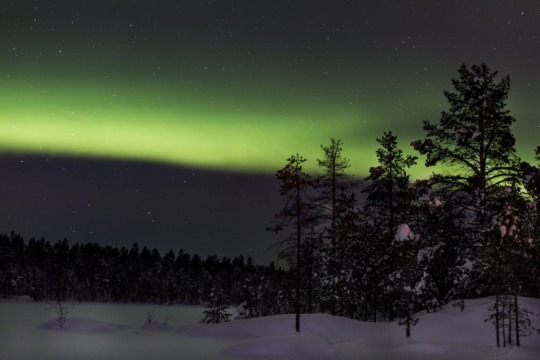
Seeing the Northern Lights is always a highlight. There are many websites which will tell you the best places and nights to go out chasing them.
4. Lighthouse Island
Finland's coastline has the largest archipelago globally. Naturally, you expect to see lighthouses by the hundreds all over the country's shoreline. The lighthouses have become a magnet for tourists, some with unique features to accommodate visitors willing to spend nights in them. The Bengtskär lighthouse is the tallest in the entire Nord region. It is a pretty magnificent sight to behold. Located on a spectacular Island, you can get to the island by boat, with the best possible season to visit between June - August. Make your bookings early in advance to secure your night stay. Bengtskär lighthouse has six rooms to stay in. Söderskär lighthouse in Helsinki is a must-see. The journey to Söderskär is more accessible by boat, and it takes an hour to get there and about two hours touring the lighthouse. Activities include; climbing the lighthouse; you get to see the entire landscape from an aerial view. It's quite spectacular. While there, you can have a cup of coffee at the keeper's cottage adjacent to it.
5. Finnish Saunas and Lakes
Kati and I love to take a sauna. We actually have two saunas. One at home and we built one in the woods in western North Carolina. There is nothing better and we actually give the sauna credit for keeping us healthy. If you think thousands of Finland Islands are enough for one tiny country, there are over 3 million saunas and nearly 190 000 lakes in Finland. Locals enjoy saunas and have made it a favorite pastime. Finns go to enjoy saunas at least once a week. So when you visit, indulge as excessively as time allows you to have a relaxing dip in one of the great saunas. Finnish Lakeland has the most summer cottages and saunas too. Experience swimming in winter and rolling in the snow around your holiday cottage.
6. Suomenlinna UNESCO Site
Finland has a record six cultural UNESCO World Heritage sites and one natural UNESCO World Heritage site. The Suomenlinna Fortress Island in Helsinki is a favorite tour destination in Finland. Added to the UNESCO Heritage List in 1991, Suomenlinna is an exceptional military architecture monument. The seven islands of Suomenlinna are comprised of old dungeons and fortresses in an inhabited district in Helsinki. To get to Suomenlinna, take a fifteen minutes ferry ride from the Kauppatori central market square.
7. Archipelago National Park
Archipelago National Park - a seascape filled with hundreds of islands! It is only 59kilometers away from Turku city. A convenient route to get to the park is through Kimito and Pargas. Positioned directly south of the city, The Archipelago National Park has a lot to give, from Viking settlements to fortified islands. Using Turku as your launching base, you can explore the park by either canoeing or cycling between the quaint towns, with breathtaking landscapes around every corner. You can cycle along the Archipelago trail to Pargas and Nagu islands, which offer an authentic archipelago life experience and a wide range of accommodation. While in Pargas, don't forget to pass by Art Bank for some fine art, then hop onto a boat and head out to Berghain, a fantastic comping site. If you don’t enjoy cycling, go for the Riverine route. You can opt for a kayaking adventure, or if you feel it's too much work, hop into one of the ferries available for a peaceful sightseeing day around the Archipelago Park. Notable areas not to miss include the Rosala Viking Village, the Military island of Oro, The isle of Bengtskar, and finally, the peaceful island community of Uto.
8. Bear Watching in Suomussalmi
For those who love bears, the best place to watch them is in Suomussalmi, a small region in Finland near the Russian border. There are approximately 1000 brown bears in Finland, but you are unlikely to meet with one while leisurely strolling through the forest. These brown beasts can smell you from afar, and they usually flee before your paths cross. For the best bear-watching experience, hire a local guide. The guides are familiar with the forest and know where to find these beasts.
9. Try Out Finnish Cuisine
Whether it's in the summer or winter, it doesn't matter which season; sampling out the authentic Finnish delicacy is a must-do activity for anybody visiting Finland. Finnish delicacies combine traditional and chic cuisine, with beef, pork, seafood, and reindeer as the primary ingredients. While strolling through Helsinki Old Market Area, you can start with quick bites, like Finnish Squeaky Cheese, Karelian Pie, and Rye Bread. Try lip-licking typical Finnish sauces with pancakes, Lapland bread cheese, or Riispurro (Rice Porridge) for a more severe breakfast. For lunch and dinner, you are full of choices. You can try out authentic Finnish meals like Pastry Macaroni With Beef Meatballs Smeared with Jam mixed with Mash Potatoes, Roasted Herring, and many other dishes. Lastly, beer lovers can try out local favorites such as Glogg Akvavit, Finnish beers, Finnish Vodka and Sima.
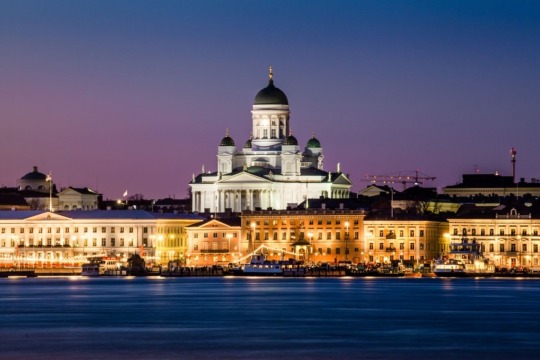
Helsinki is worth exploring and checking out some world class restaurants.
10. Oulanaka National Park
Oulanka National Park is widely regarded as one of the best national parks in Finland, and with good reason. There are a series of spectacular creeks that run through the Kiutakongas Falls canyon. It's a quick one kilometer stroll from the parking lot, so you can have a swell time hiking with your spouse or your loved ones. Just below the waterfalls, several beautiful rope swing bridges spanning over the canyon. Outdoor adventures are the thing here, and even if you are not athletic, you will have a good time.
11. Finnish Glass Igloo
Finland is a land of extremes in terms of season contrasts. During summer, the sun stays up all day, and all night, in Northern Finland . This phenomenon is known as "The Land of the Midnight Sun." During winter, the opposite happens: darkness fills the land, giving way to beautiful moonlighting, bright stars and a romantic setting for a cozy night under warm fires. This time is known as "kaamos." During kaamos, it is not entirely dark, the skies glow from the brisk the moon, and the stars, reflecting an amazing view from the backdrop of the bright snow across the landscapes. The Northern Lights project enchanting backdrops from the seashores. An exciting approach to experience the Midnight sun and Kaamos is to sleep in a a glass igloo, out in the open skies. It’s a magical experience! Our Final Word Finland is more than just a stunning European destination; it is mystical heaven on Earth that brings the human imagination to life. From the breathtaking sightseeing sites to the enchanted wonderland of snow and fascinating natural phenomena. Finland appeals to a wide range of tourists, including history lovers, nature-buffs, food lovers, and thrill-seekers. There really isn't a best time to see Finland. Both summer and winter offers travelers an incredible amount of activities. Head to Finland and discover why it is rated as the happiest country on earth.
Related Posts
Read the full article
0 notes
Text
Arplis - News: 38 Fun Things to Do in Tucson, Arizona
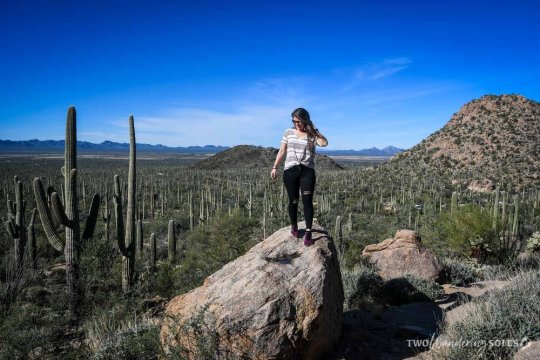
With incredible outdoor adventures, some of the best Mexican food in the U.S. (yes, seriously!), and a vibrant nightlife, Tucson may just be the perfect weekend getaway. Oh, and did we mention Tucson has wonderfully warm temperatures in the wintertime?! (Fellow Midwesterners, take note!)
The population of Tucson is just over half a million people, making it feel like a relatively small city. But dont be fooled there are an incredible amount of things to do in Tucson!
While there are many things to do in the city itself, the real draw of Tucson is what lies beyond. The Sonoran Desert which surrounds Tucson, is one of the only places in the world to see the iconic saguaro cactus, after all.
Were walking you through the very best things to do in Tucson, Arizona from epic outdoor adventures to foodie experiences to nightlife for all ages.
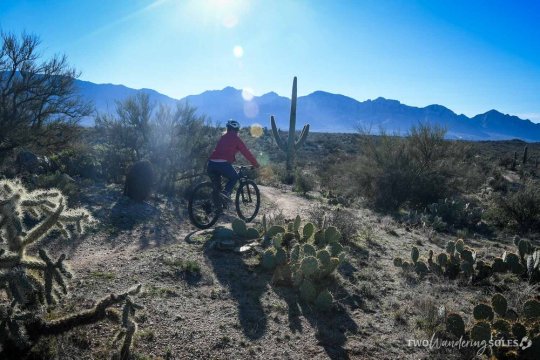
Our Experience in Tucson
Im going to be honest: Until recently, Tucson wasnt on my radar at all. Instead, I pictured the Grand Canyon and cities like Phoenix, Sedona and Scottsdale when I thought of Arizona.
So when my parents booked a 2-week Airbnb rental in Tucson to escape Minnesotas frigid winter clutches, I asked them, What is there to do in Tucson?
The timing was uncanny, because a week after my parents booked their trip, we were contacted by Visit Tucson (the tourism board) to work on a campaign with them. And all of a sudden, a city I hadnt ever thought much about took center stage in my mind.
When we started planning our trip to Tucson, I truly started to realize why my parents had booked 2 weeks there. As it turns out, theres a lot to do in this southwestern city!
This info-packed guide is full of top tips, where to stay, what foods to try , and everything else you need to know about planning an incredible trip to Tucson.
Contents:
Things to do in Tucson:
Outdoor Activities in Tucson
Food & Nightlife in Tucson
Art, Culture & History in Tucson
Planning your trip to Tucson:
Best Tucson Weekend Itinerary
Best time to visit Tucson
Where to stay in Tucson
How to Get Around Tucson
What to pack for Tucson
Tucson Map
Disclosure: This trip and article was sponsored by Visit Tucson. As always, all opinions are 100% honest and completely our own. Additionally, this article contains affiliate links. Read our disclosure policy for more information.
Outdoor Adventures in Tucson
If you like getting outside, youll find your bliss in Tucson because there are so many outdoor adventures to be had in the area surrounding this city.
1. Go horseback riding in the desert
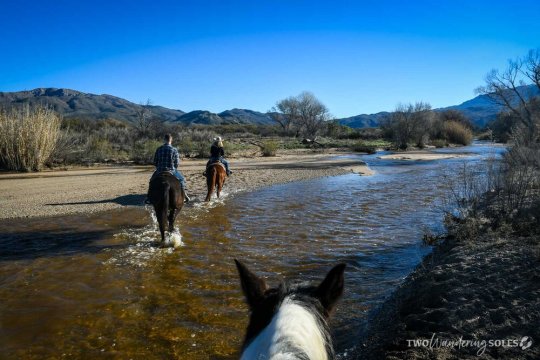
I am going to embarrass Ben for a minute while I tell you something about him few people know: Hes afraid of horses.
Hes looking over my shoulder as I type this and saying, Im not afraid, I just think theyre smart and strong, and we should respect them.
Yeah, okay whatever, Ben.
But to his credit, he agreed to go horseback riding on our trip to Tucson. (Ive been asking him for the last couple of years, and he finally gave in.)
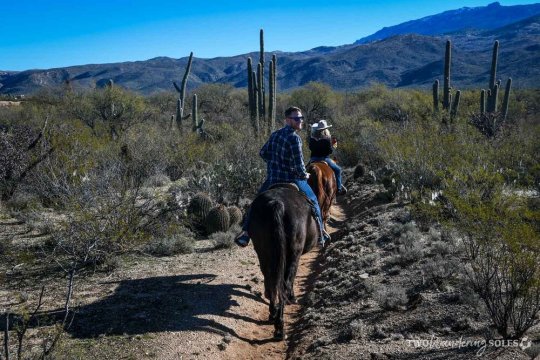
And you know what? When I asked Ben what his highlight was from our trip to Tucson, the first thing out of his mouth was, horseback riding!. So even if youre not an experienced rider, Bens reaction should give you some encouragement.
It was hands down one of my favorite experiences in Tucson too! We were able to see places we never would have without being saddled up on John Wayne and Mac (names of our horses).
Bobbi, the owner of Houstons Horseback Riding, led our group along the trail. We crossed rivers, ducked beneath low-hanging trees, and trotted past giant saguaro cacti with mountains looming in the distance. The landscape changed throughout the 2-hour journey, and the pace was slow and steady (great for those of us who arent experienced riders).
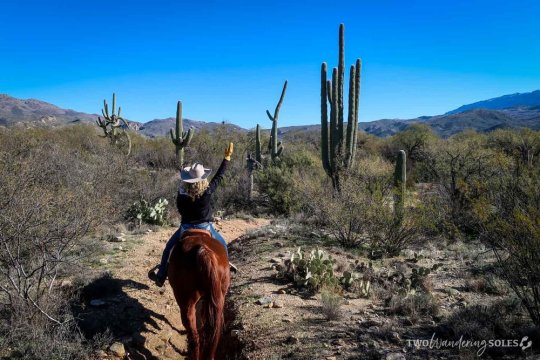
The views we got right up next to the saguaros on top of the horses was completely different than the perspective wed get walking on the trail with our own two feet. It was surreal.
And after chatting with Bobbi, its clear how much passion she has for this work. She has been working with horses for nearly her entire life and has passed on her admiration for these beautiful creatures to her children who help run the show as well. I mean, with about 30 horses to care for, the more hands the better.
So not only will you have an amazing experience with the horses, but youre supporting a family run business. Win-win!
Hours: Trail rides start at 9 a.m and 2:30 p.m.
Cost: $85 for a 2 hour walking ride
Book Your Horseback Ride Here!
Are you an experienced rider? If youre no stranger to horseback riding, you can book a private ride where your guide will adjust the speed to suit your experience level.
2. Visit Saguaro National Park

Saguaro are the huge cacti that adorn the Arizona license plate and serve as an icon of Southwest USA. And there is a National Park just 30 minutes from downtown Tucson that is dedicated to their existence.
Before we delve into the best things to do in Saguaro National Park, lets start with the basics pronunciation.
Say it with me: suh-waa-row
Now you wont embarrass yourselves like we did. (Youre welcome!)

And because I am fascinated by these cacti, Im gonna entertain you with some fun facts about the saguaro:
They can live to be 150 years old (some even are said to be 200 years old!).
They can grow up to 40-60 feet tall (12-18 meters).
They dont start growing arms until theyre around 70 years old.
They only grow in parts of the Sonoran Desert (a small area in Mexico, southern Arizona, and occasionally southeastern California.
They are expensive! Thats right, some people like to incorporate them into their landscaping, and the large ones can cost upwards of $10,000. The more arms it has, the more money it costs.
One foot of a saguaro weighs around 100 pounds!

We have a love affair with National Parks. Anyone else?! So it should come as no surprise that the first thing we plotted on our Tucson itinerary was a visit to Saguaro National Park.
And guess what?! It was our 20th US National Park! *cue champagne toast*
Saguaro is divided into two sections: one to the east and one to the west. In the middle lies the city of Tucson. Each side is a bit different. The west side of the park is more densely covered with saguaro, while the east side has more hiking trails and is more mountainous.
Try to see both sides if possible, but if youre short on time, visiting the west side of the park will be the best way to maximize your visit.
Best things to do in Saguaro National Park (with limited time):
West Side Saguaro National Park:

Drive around the 6-mile scenic Bajada Loop, and stop along the way at the spots listed below (plus any others that pique your interest):
Hugh Norris Trailhead: Hike up the trail for about 5-7 minutes and look west. Youll see tons of saguaro cacti and this spot would be wonderful for sunset.
Valley View Overlook Trail: 0.8-mile one-way (out and back) easy trail that is relatively flat. There are signs along the way pointing out the different types of plants and the final destination is a viewpoint over the vast valley below that is full of cacti.
Signal Hill Picnic Area: This short 0.3-mile hike up signal hill leads you to dozens of 800-year old petroglyphs that were created by the ancient Hohokam people.
East Side Saguaro National Park:
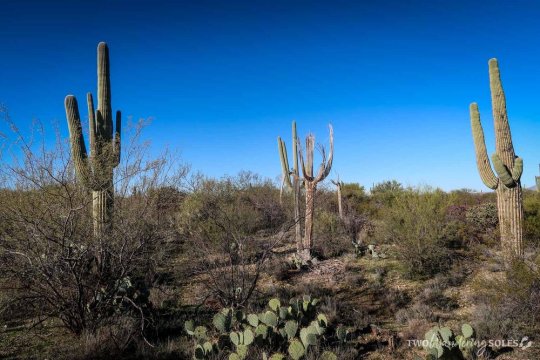
Drive along the Cactus Forest Drive Loop. It is an 8-mile self-drive loop that takes you to some of the major attractions in the east side of Saguaro National Park:
Mica View Trail: This relatively flat 2-mile return hike starts at a nice picnic area, goes through the cactus forest to East Broadway Blvd and back. You can also start the hike from E Broadway Blvd too.
Desert Ecology Trail: Paved 0.3-mile loop with signs to tell you more about desert plants. Great walk for kids.
Cactus Forest Trail: Splits the East Saguaro National Park from North to South. 5-mile return, mostly flat, but youll be surrounded with saguaro cacti the entire time.
Freeman Homestead Trail: Short 1-mile loop trail easy to do with kids. Youll walk by some of the biggest and oldest saguaros in the park.
Have more time in Saguaro National Park?

Douglas Spring Trailhead (East Side): This is a 16-mile out and back trail that is pretty flat for the first half and then switchbacks up the mountain until the top. About a quarter of the way on the trail, head to the left for 0.4 miles to see the Bridal Wreath Falls (dont expect a massive falls, but refreshing to see in the desert).
King Canyon Trail (West Side): The trailhead starts opposite of the Arizona-Sonora Desert Museum, this 7.1-mile moderate trail winds its way up to Wasson Peak. Many reports say its tough on the way up and you should start early, but youll be rewarded with an amazing view of the saguaro cacti filled desert.
Hours: Visitor Centers are open 9 a.m. to 5 p.m. but the park is open to vehicles from sunrise to sunset.
Cost: weekly pass to Saguaro National Park is $25 per vehicle.
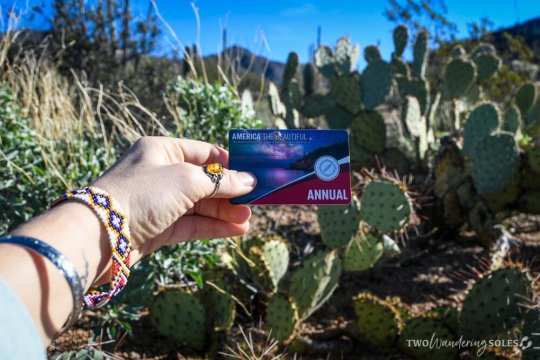
Insider tip: If you dont already have an America the Beautiful Pass, you might want to consider getting one before your trip to Tucson. It will not only cover your entrance to the National Park, but also to Sabino Canyon. Weve put together a guide thatll help you decide if the US National Park Pass is worth it for you.
3. Mountain Biking around Tucson

There are few things better than being outside, getting your heart pumping, and trying something totally new. And thats exactly what we did on our last morning in Tucson. We woke up before the sun, grabbed a breakfast burrito for fuel, and headed to a trailhead.
Tucson has some of the best places in Arizona if not the best for mountain biking. And whether youre a newbie to the sport (like us!) or a seasoned mountain biker, there are trails suited to all levels.
Important info about biking in Tucson:Here's the thing we wish we would have known before going mountain biking in Tucson... Some of the trails around the city are unsanctioned, meaningyou cannot legally ride on them without getting a permit. And the even sketchier thing is some mountain bike rental companies encourage riders to use these trails without first obtaining anArizonaState Trust Landpermit.
Even after quite a bit of sleuthing, we still can't figure out how a visitor to Tucson could actually purchase one of these permits (as the site to purchase them is broken). Moral of the story: When picking the trails you'll ride, be extra careful to choose only those that are sanctioned. Otherwise, you can be fined (and you're breaking the law).
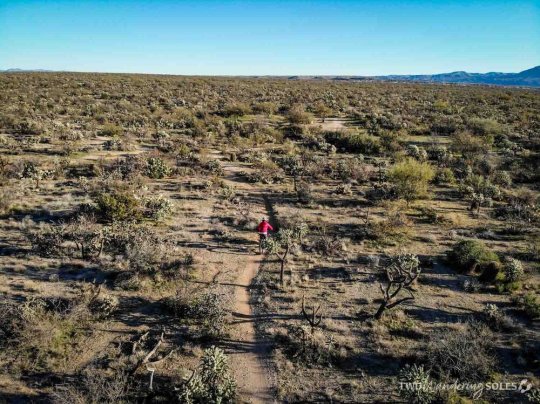
Luckily, there are some reputable biking companies that follow the rules and encourage safe riding on trails that are open for the public to enjoy.
Our recommendation:Home Grown Mountain Bikingis a trusted company that offers rentals, shuttle services, and guided rides so you have an expert with you on the trails.Cost: Mountain bike rentals start at $120 per day. You'll find other package options as well as multi-day discounts.
Some popular mountain bike trails in Tucson (that don't require a permit):
Mount Lemmon:Lots of rugged terrain and temperatures that are significantly cooler than you'll find closer to the city, which makes for comfortable biking even in hotter months.
Catalina State Park, Oro Valley:Lots of beautiful trails, like the intermediate track "50 Year". Note: to enter Catalina State Park, you will need to pay $7 per vehicle.
Tucson Mountain Park:Here you'll find 50 miles of trails that are primarily beginner and intermediate levels.
Insider Tip:Download theTrailForks app to get a detailed look at the trail you plan to ride.
4. Explore Colossal Cave

Stalactites, stalagmites, and bat poo, oh my!
Ive had a fascination with caves since I was a child, so weve visited all different types of caves on our travels around the world. When we heard there was a cave in Tucson, we didnt need much convincing to squeeze a visit into our itinerary.
Located a short 15-minute drive southeast of Tucson, the Colossal Cave has a pretty interesting history. It was once used as a temporary shelter for the Hohokam people (the regions first inhabitants) as early as 900 AD. And later, this cave served as a hiding place for 19th-century outlaws who didnt want to be found.
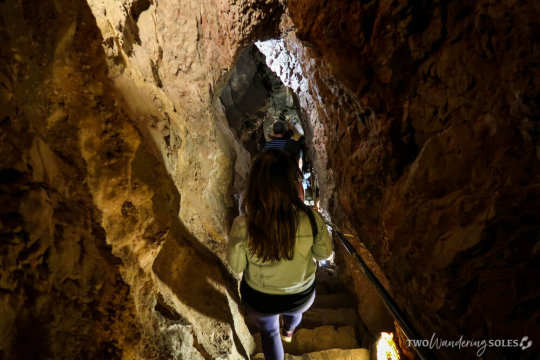
To enter the Colossal Cave, you must book a guided tour. There are a handful of options to choose from:
Classic Cave Tour: Good introduction to the cave and suitable for all ages.
Length: 50-minute tour
Cost: Adults: $18, Children (5-12 yrs): $9, 4 and under: free
When: 8 tours a day, depart hourly from 9 a.m. to 4 p.m.
Tip: Reservations are encouraged
Ladder Tour: Navigate narrow passageways, climb ladders, and cross rickety bridges in seldom-seen parts of the cave system.
Length: 1.5-hour tour
Cost: $35 per person
When: 2 tours a day 9:30 a.m. and 1:30 p.m.
Tip: Reservations required
Wild Cave Tour: The most adventurous of tours offered, guides will take you to the most remote parts of the cave system. Participants must be fit and ready for a rugged good time! Described as absolutely down-and-dirty caving!
Length: 3.5-hour tour
Cost: $85 (reservations required)
Restrictions: 16 years old and older
When: 1 tour a day at 1 p.m.
Tip: There is an Intermediate option as well as Advanced ($125).
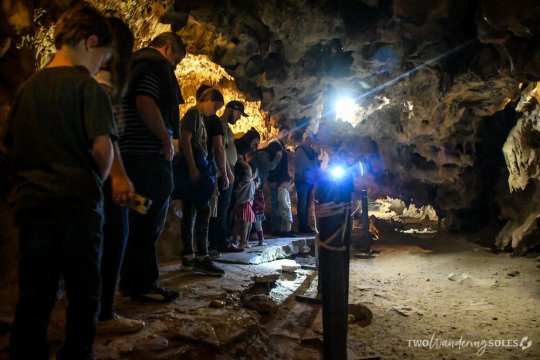
Our Opinion: Due to our limited time, the Classic Cave Tour was the one that best fit into our schedule. While it was a good introduction, it wasnt anything too different from what weve seen in other cave systems. We wished we had booked the Ladder or Wild Tour, as it would have been a bit more up our alley in terms of adventure!
Learn more about each tour and make your bookings here.
5. Sunset in the desert
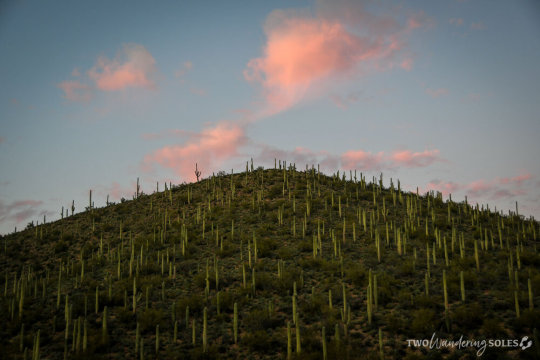
Look up to the skies at dusk and youre in for an incredible show put on by Mother Nature. Seriously though, Tucson is known for having some epic sunsets, so plan to be somewhere special for at least one of the evenings during your trip.
Theres nothing like seeing the cacti start to glow as the sky takes on a pinkish hue.
Some top spots around Tucson for sunset:
Gates Pass
Saguaro National Park
A Mountain
JW Marriot
Tucson Mountain Park
Mount Lemmon scenic drive
6. Get a view over Tucson from A Hill (aka Sentinel Peak Park)

Look to the horizon and you shouldnt have a problem spotting A Hill, which, as the name implies, is adorned with a giant letter A made of rocks. This tribute to the University of Arizona is not only a town icon, but it marks one of the best spots to get a view over the city.
As long as the sky is clear, any time of day will grant you a sweeping view. Get an early morning start here and view the city beneath blue skies.
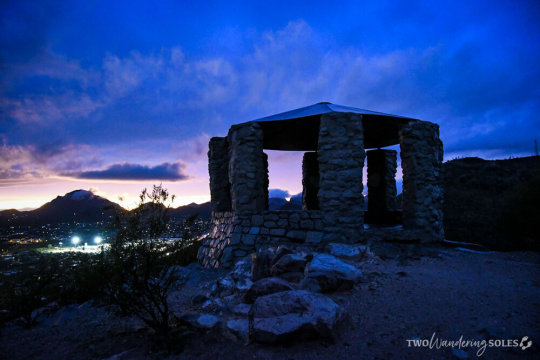
Or come for that golden hour glow and stay after the sun goes down to see the city lights begin to sparkle. Just know that after the sun sets, this is clearly a makeout spot, which is slightly awkward...
Alternative: Are you looking to get a workout in instead of taking the easy way and driving to the top? Pat yourself on the back, and then head to Tumamoc Hill. The trailhead is just a few minutes drive past the starting point of Sentinel Peak. This short but steep climb is a 3-mile round trip with a 700-foot elevation gain.
7. Arizona-Sonora Desert Museum
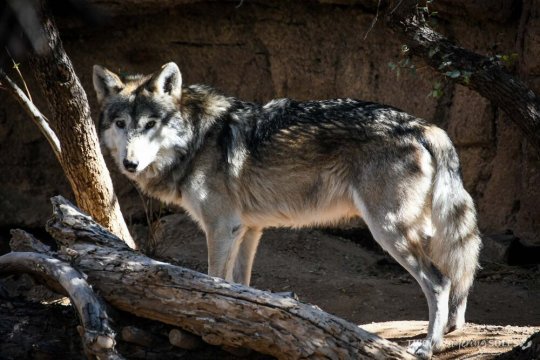
I hate to admit it, but unless it is truly something special like the Met in NYC or the Uffizi in Florence I dont always prioritize fitting museums into our travel plans. Honestly, Id rather be outside or eating which I suppose could be my life motto.
However, once we saw reviews for the Arizona-Sonora Desert Museum, we decided to squeeze it into our itinerary. I mean, its the top-rated Tucson attraction on TripAdvisor (earning 5 stars with more than 8,000 reviews!), so surely it has to be worthwhile, right?
Honestly, after checking it out, I would say it depends. I know thats annoying to hear when trying to plan your itinerary, but keep reading to see if it is an experience thatll float your boat.
First things first, dont think of this as a typical museum... It's more of a zoo blended with a botanical garden and a dash of museum thrown in there for fun.

Youll find a huge variety of exhibits and lots of information around the park. To really explore everything thoroughly, youll need at least 2 hours.
Here are some of the main exhibits:
Aquarium
Raptor Flights
Hummingbird Aviary
Cave & Earth Sciences Center (the cave is artificial but pretty convincing)
Botanical Garden
Indoor Play Area for kids
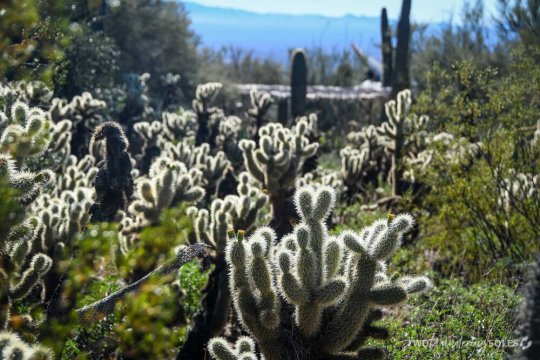
One major perk to visiting the museum is your entrance fee will help contribute to their ongoing conservation and research efforts. One of their primary missions is to understand, connect people to and protect the natural systems of the Sonoran Desert Region.
Considering that the Sonoran Desert region is home to one of the greatest varieties of plants and animals out of any desert in the world, you can see it is pretty important work.
Interested in hearing more? Check out their website to see their current conservation and research projects.
Our thoughts on the Desert Museum:
Our favorite parts were the cave and gemstone exhibits. We are big rock nerds, so this part was especially cool. Theres even a little piece of rock from the moon on display which Ben geeked out about!
We think this would be a fun activity with kids (though we arent experts on the whole subject of children just yet!).
Honestly, zoos usually arent our thing (but thats a topic for another time). So we werent all that fond of the animal exhibits at this museum.
There is a small pool with stingrays where people can pay a small fee to touch them. We personally try to avoid any animal attraction that encourages touching.
Summary: Overall, this attraction is very well put together with accessible paths, frequent water fountains and toilets, lots of informational signs, and activities for children. You can learn a lot here and spend quite a bit of time exploring it all. However, if youre short on time, going into Saguaro National Park and Sabino Canyon are going to be even more worth your while.
Hours: 8:30 a.m. to 5 p.m.
Cost: Adults - $21.95, Seniors (65+) - $19.95, Children (3-12) - $9.95, Children (under 3) - Free
8. Go hiking in Sabino Canyon
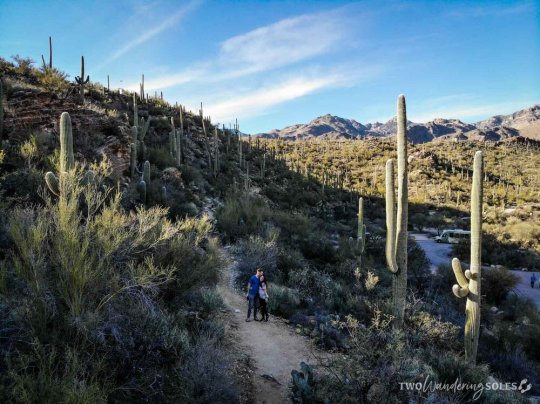
Sitting in the foothills of the Santa Catalina Mountains, Sabino Canyon Recreation Center draws more than a million visitors annually. And for good reason: This place is absolutely stunning and packed with adventures for all types of travelers.
Encompassing two gorges: Sabino Canyon and Bear Canyon, you can choose to hike along paved or gravel paths, or you can save your legs some work and hop on a shuttle (for a fee).
Bear Canyon Shuttle: $6 adults, $4 ages 3-12; leaves every 30 minutes
Sabino Canyon Shuttle: $10 adults, $5 ages 3-12; leaves every 30 minutes
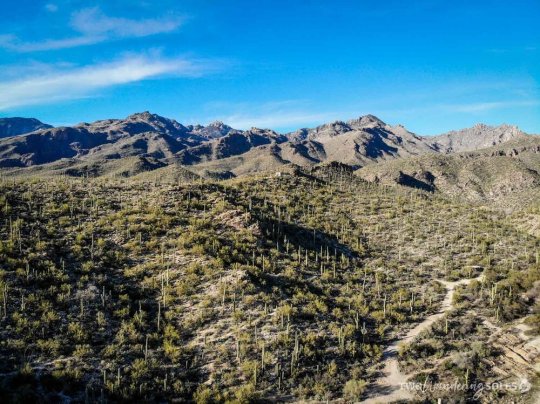
Seven Falls Hike
5 miles round trip
917 feet in elevation gain
If youre up for a challenging hike (thats well worth the effort), look no further than the Seven Falls Trail. You can hop on the Bear Canyon shuttle and get off at the last stop, which is at the trailhead. (Alternatively, you can skip the shuttle and hike the 2 miles to get to the trailhead.)
From here, its a 2.5-mile hike to the waterfalls that cascade over granite rocks to form pools that are perfect for taking a refreshing dip!
Important note: This trail requires some creek crossings, so be sure to check the conditions at the visitors center before attempting the hike. And be sure to carry plenty of water, as youll be hiking in some exposed areas and it can get very hot.
Cost: $8 per vehicle to enter Sabino Canyon
Hours: 8 a.m. to 4:30 p.m.
Good to know: If you have a National Park Pass, youll get into Sabino Canyon for free!
Planning your itinerary: Wed recommend combining a visit to Sabino Canyon and a drive up to Mount Lemmon (described below) on the same day since they are in the same relative area. If you plan to visit the DeGrazia Gallery as well (#19), you can tack it on the same day since its not far from Sabino Canyon.
9. Scenic drive to Mount Lemmon

When we started planning our trip to Tucson, at least three different people told us, You absolutely have to make the drive up to Mount Lemmon.
And were so happy we listened because it was one of the highlights of our trip. We only wish we had allotted more time to it.
This 40-mile drive snakes back and forth as it winds up through the mountains. There are viewpoints, pullouts, trailheads and campgrounds very frequently along the drive, so there are plenty of opportunities to stretch your legs and scope out the views.
Youll notice a drastic drop in temperature as you make your way up the mountain, and depending on the time of year, you may even start to see snow (a crazy sight when youre coming from the desert!).

At the very top of Mount Lemmon, sits the tiny town of Summerhaven, which is basically a handful of vacation homes and a few small stores. Satisfy your sweet tooth by sampling fudge at the General Store and ordering a cookie at the Mount Lemmon Cookie Cabin, and continue to drive to the Marshall Gulch Picnic Area where you can enjoy your sweet treats with some real food you packed!
Insider Tip: One of our friends messaged us and told us to go to the Cookie Cabin, for huge and delicious cookies. Sadly, we got the text too late. So if you have the chance, go to this mountaintop log cabin and order a giant cookie for us, please!
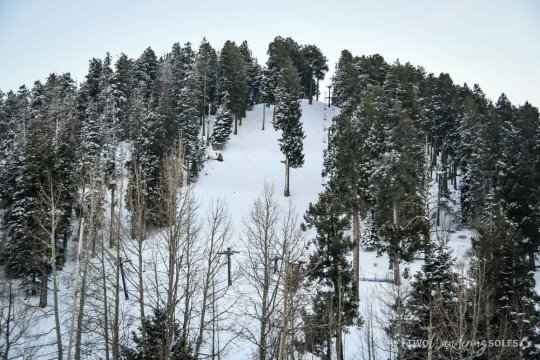
Another fun thing to see is the (tiny) Mount Lemmon Ski Valley before you begin your drive down the mountain.
How long does it take? The drive is roughly 42 miles from downtown Tucson and takes about 1 hour 20 minutes from bottom to top without stopping. Wed allot at least 3.5 - 4 hours for the drive up and down the mountain with a few stops along the way.
10. Explore Catalina State Park
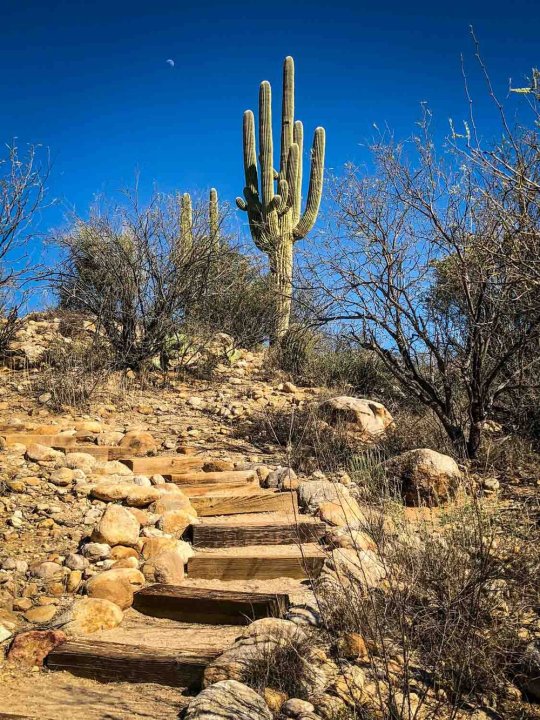
Catalina State Park | Photo Credit: My Mom ;)
Sitting at the base of the Santa Catalina Mountains, this state park is a haven for desert wildlife and is home to more than 5,000 saguaros.
Come to Catalina State Park put a few more miles on your hiking boots or to have a relaxing picnic surrounded by nature.
Hikes in Catalina State Park:
Romero Ruins Interpretive Trail: This short and easy loop is 0.6 miles and has just 68 feet in elevation gain, making it a good hike for most people. The trail brings you past some historic dwellings and archaeological sites that are marked with signs.
Romero Pools: This 4.9-mile out and back trail is rated as intermediate, and has a 1,047-foot elevation gain. Your efforts will be rewarded as the trail culminates at some beautiful pools.
Cost: $7 per vehicle
11. Drive through Tucson Mountain Park
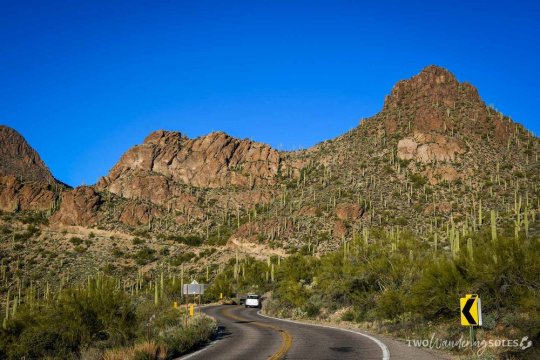
Another park in Tucson? Yep, thats right!
You will pass through the Tucson Mountain Park on your drive to the west portion of Saguaro National Park. And actually the Arizona-Sonora Desert Museum and Old Tucson are both located within the parks boundaries.
There are no entry fees, and unless youre looking at your map, you might not even realize youre inside the park at all.
Insider Tip: Be sure to stop at the Gates Pass viewpoint for an epic look over the valley. It is especially beautiful during golden hour. There are a few nearby trailheads too, so youll have the chance to stretch your legs if needed.
12. Visit Kitts Observatory
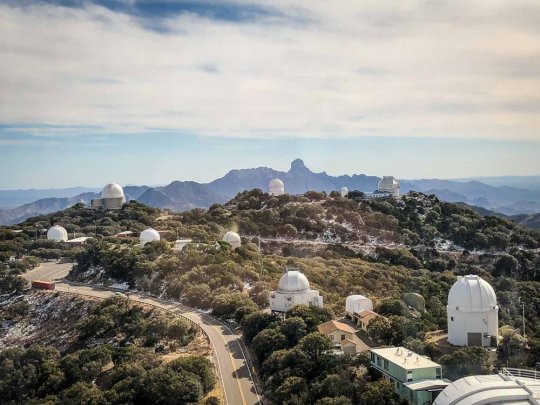
Kitt's Observatory | Photo Credit: My Mom ;)
Are you as big of a space geek as Ben?! If so, a trip to Kitts Observatory might be right up your alley. You can visit during the day to learn about telescopes and all the work that goes on behind the scenes, or you can take a night time tour and see the stars. But be sure to check the weather before you book.
Also, if the weather is cold, be prepared with warmer clothes because it can get even colder up on the mountain. Bring a good pair of shoes too because there is quite a bit of walking in the tour.
13. Tour Biosphere 2

Biosphere 2 | Photo Credit: My Mom ;)
Could you live in a bubble for 2 years?! Thats what 8 scientists did back in 1991 when the Biosphere 2 was first introduced to the world. Their goal was to study how a mini-biosphere would work with as few outside variables as possible.
Today, you can visit Biosphere 2 and tour the different ecosystems which range from rainforest to the ocean to a model city. The guided tours take you through various stations and highlight the ongoing experiments happening in the Biosphere.
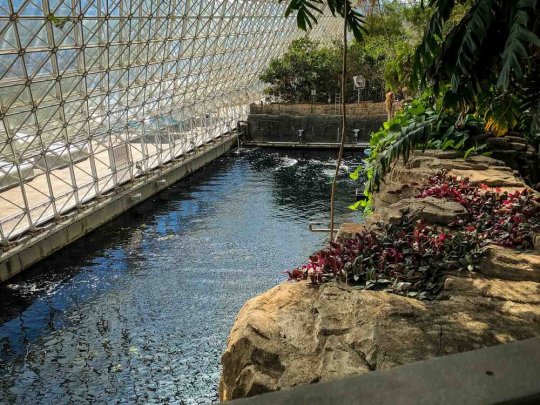
Inside Biosphere 2 | Photo Credit: My Mom ;)
Some tours are included with the General Admission fee, while other tours have an additional cost. Tours can take around 2 to 3 hours. Plus, getting to Biosphere 2 from the center of Tucson is roughly a 50-minute drive, so youll need to dedicate a good portion of a day to this excursion if you add it to your itinerary.
Hours: 9 a.m. to 4 p.m. daily
Cost: Adults: $21, Kids $14
Check the Biosphere 2 website for more details on times and prices.
Fun Fact: If this is Biosphere 2, where is Biosphere 1? Well, youre living on it right now (aka Earth!). Mind blown!
Food & Nightlife in Tucson
Foodies are in for a treat because Tucson is packed with incredible dining options, especially when it comes to Mexican cuisine. And night owls will have a long list of things to do at night, from sampling the best local craft beer to enjoying live music on the town.
14. Eat ALL the Mexican Food

One of the things we were most excited for on this trip was the food. Mexican food, to be precise. #allthetacos
Being that this city is just over 60 miles from the border of Mexico, it should come as no surprise that Tucson is known for having a killer Mexican food scene. In fact, Tucson is the first UNESCO City of Gastronomy in the United States!
Psst! If youre a foodie, youll love this intro to the Tucson culinary scene!
The worst part of the food in Tucson was that we couldnt eat it all. Well, that and the fact that our weekend in Tucson obliterated our meager attempt at doing the Whole30 in January. I mean, Im not going to go to a Mexican food Mecca and not eat as many tacos, tamales and guacamole as possible. Its against the laws of nature.
If youre still reading my food-crazed ramblings, youre probably wondering where you can find the best Mexican food in Tucson, and youre about to be rewarded, friend.
While you dont have to look far to find good Mexican food in Tucson, were sharing some top recommendations, from super authentic hole-in-the-wall spots to refined Mexican restaurants with an exceptional dining experience:
Los Tacos Apson: Tiny, unassuming shop with authentic fare and a generous salsa/topping bar. We ordered a handful of items but our favorites were the taco al pastor and taco hass (carne asada, queso, chili verde); and as we were leaving, a local recommended we try the taco rasuada (grilled ribs) next time! This is also a great spot to try a caramelo, Tucsons take on a quesadilla (cheese and lots of meat grilled between tortillas).
Bocas y Tequila: Popular spot, especially with the university crowd, it seems. The tacos were super tasty (albeit not very hot, but we were there at a super busy hour!). The elote (Mexican street corn) was also very good.
Cafe Poca Cosa: An upscale Mexican restaurant with a menu that changes daily.
Taco Fish: Come here for fresh ceviche and tacos de pescado (fish) or camarones (shrimp).
Penca: Contemporary Mexican fusion with a chic atmosphere.
Mi Nidito: Serving Tucson since 1952, this place is a local legend known for large portions, delicious food, and as a place Bill Clinton once ate.
Taqueria Pico De Gallo: Best known for its award-winning fish tacos, this is another local favorite for authentic (and cheap!) tacos.
Taqueria Porfis: While the menu is small, thats okay because what they do, they do well. And the item theyre most famous for is their potato taco, which is stuffed with carne seca, tomatoes, lettuce, sour cream, and you guessed it potatoes!
Rollies Mexican Patio: Known for their rolled tacos, this cute and colorful cafe makes a great lunch stop.
El Charro Cafe: Set inside a century-old home, this restaurant serves up large home-cooked meals in a charming, yet casual atmosphere.
Fun Fact: This is the nations oldest Mexican restaurant run continuously by the same family.
Street Taco and Beer Co.: Good for late night bites, street tacos, and tequila cocktails.
Insider Tip: We read that if you want to find really authentic, no-frills Mexican food, head to the neighborhoods south of 22nd Street. And 12th Ave, which runs north to south, has a dense concentration of amazing Mexican restaurants.
These streets are part of whats known as the Best 23 Miles of Mexican Food (aka a 23-square-mile area in the city thats known as the best Mexican food north of the border).
15. Try a Sonoran Dog

Im not usually one to order hot dogs, but when we learned that Sonoran Dogs are a must try specialty from this region, we had to give it a go. For research purposes.
And lets just say Im pretty happy I made the sacrifice in the name of work. And while Sonoran Dogs arent something I would eat on a regular basis, they are pretty damn good.
So what exactly is a Sonoran Dog, you ask? This tasty blend of American and Mexican cuisine is comprised of bacon-wrapped hot dog, topped with pinto beans, chopped tomatoes, onions, mayonnaise, mustard and jalapeo salsa, all stuffed into a soft, sweet Mexican bun called a bolillo.

Rumor has it that there are two rival Sonora dog establishments in Tucson that both claim to serve the best:
BK Carne Asada & Hot Dogs: Winner of a Sonoran Dog locally-judged blind taste test against El Guero Canelo, it is definitely worth a try. They also have a large menu of fantastic Mexican fare, some may say the best in Tucson.
El Gero Canelo: With 3 locations in Tucson, this is a Tucson must! We sampled the one on Oracle road, and it did not disappoint. The combo of sweet, spicy and savory is an explosion in your mouth. Youre gonna want more than one.
After a little research, we chose to try our first Sonoran Dog at El Gero Canelo. While we dont have anything to compare it to, it was pretty darn tasty! If you have the time (and room in your tummy!), try them both on your trip to Tucson to determine the winner!
16. Sample Vegan Mexican Fare

Most restaurants featured on Diners, Drive-ins and Dives are laden with grease, layers of cheese, deep-fried everything, and meat. Lots of meat.
But an exception to this is Tucsons beloved Tumerico, which was featured on this hit series in 2018. This local favorite serves up scratch-made Mexican dishes with a menu that changes daily.
While clearly very popular, the service was fast, the prices reasonable, and the food delicious.
Our recommendations: The menu is constantly changing so we cant give specific recommendations, but if there is a taco made with jackfruit, TRY IT. You will thank us! Also, the turmeric lemonade was seriously yummy.
Moral of the story: Even if you do eat meat, Tumerico is well worth a visit.
Good to know: Tumerico is closed on Mondays.
More vegetarian options in Tucson
While these are not Mexican restaurants, here are a few other good options for vegetarians/vegans visiting Tucson.
Charro Vida: While not fully veggie, this Mexican-Mediterranean fusion restaurant (located close to Tohono Chul #35) donates proceeds to local school gardens throughout the region in partnership with the University of Arizona. Just looking at their menu makes my mouth water...
The Tasteful Kitchen: A somewhat upscale restaurant that specializes in vegan, gluten-free and raw cuisine. And while youre there, be sure to check out the mural depicting Mother Earth on the side of their building.
Urban Fresh: Casual cafe with plant-based wraps, salads and soups.
Zinmans Food Shop: carry-out spot with a patio, serving an eclectic assortment of dishes with influences from around the world.
17. Grab a cup of Tucsons best coffee

My name is Katie, and Im a coffee addict. If you are too, youll definitely want to start your day at Exo. Praised as the best coffee in Tucson, Exo does it all, and they do it well.
If you want to switch up your order and get something a little more unique than your everyday latte, order a chiltepin cold brew, which is made with spicy peppers!
And if your tummys a grumblin pick up one of their super tasty breakfast sandwiches, breakky bowls, or to keep the Mexican food theme going, try their breakfast tacos!
18. Visit a Farmers Market

When you combine locally grown produce, artisans selling their creations, and food vendors all in one place, youve got yourself some farmers market bliss.
With a handful of farmers markets around the Tucson area, youll likely be able to squeeze one during your trip.
Here are 3 farmers markets that are closest to town, and are easy to work into your sightseeing schedule:
Rillito Park: Makes a good stop if youre headed up to Catalina State Park, Tohono Chul, or over to Sabino Canyon.
Oro Valley: Stop here on your way to Catalina State Park.
Rincon Valley: Make a stop here on your drive down to Colossal Cave.
We visited the market in Rincon Valley on our way to the Colossal Cave, and while not huge, it was a nice stop to browse some local artists work and nibble on kettle corn!
Hours: All the markets listed above have the same hours.
Winter Hours (Oct. - Mar.): Saturdays, 9 a.m. - 1 p.m.
Summer Hours (Apr. - Sept.): Saturdays, 8 a.m -12 p.m.
These farmers markets are all put together by an organization called Heirloom Farmers Markets, and you can find more info here.
19. Go on a Food Tour
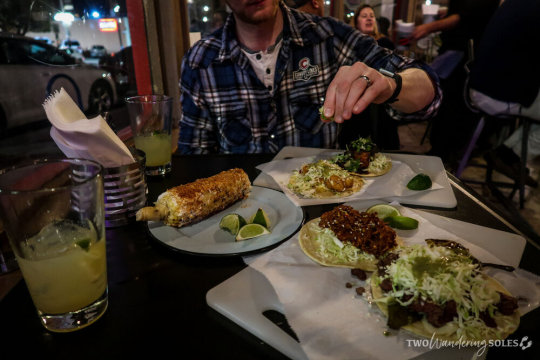
Im someone who gets serious FOMO when it comes to food.
When visiting a city thats known for its food scene, I feel like I should try everything, which is not exactly an ideal habit for my waistline or my wallet.
If you can relate (yay, Im not alone!), youll want to keep reading because I recently found the cure: Food Tours!
Food tours are a way for you to try a little of each (my favorite!). Plus, your guide usually brings you to local spots you wouldn't find on your own, and gives you insight to the citys history, culture and culinary scene.
So if youre interested in food especially Mexican food (Tucsons pride and joy!), you might want to consider adding a food tour into your itinerary.
There are two companies that run highly-rated food tours in Tucson:
Tucson Food Tours
Taste of Tucson
Weve taken food tours all around the world, and wish we had time to take one on our trip to Tucson. Guess weve gotta save something for our next trip, right?!
20. Hang out in Mercado San Agustin

This square just west of downtown has a collection of high-end boutiques, produce vendors, artisans and eateries surrounding a pretty courtyard. We were there on a rainy day (a rare occurrence in Tucson!), but with nice weather, this would be a prime spot to wander and grab a bite.
Insider Tip: We were told that Seis Kitchen is amazing, and La Estrella Bakery also looks really good. Try them out and let us know what you think!
21. Eat a flight of Ice Cream

Can I confess something? I have an ice cream problem.
Someone once told me, No matter how full you are, theres always room for ice cream because it can fit in all the cracks! And I think Ive taken those words a little too seriously over the years.
This is coming from someone who almost missed the last train of the day in a tiny Italian village because I *needed* to get gelato. And someone who has (successfully) completed more than one ice cream eating challenge.
So lets just say you should consider me something of an expert on the topic of ice cream.
When I heard about the ice cream flights (yes flights!) at The Screamery, I told Ben we had to make it part of our itinerary.
And when I found out it was right across the street from our hotel as well as another highly rated ice cream shop (Hub), I told him we better go to both. Ya know, in order to research as many flavors as possible.
The Screamery: Tons of unique flavors to choose from, reasonable prices, and the option to have a flight!
Flavors we loved: Sweet Cream Honeycomb and Rough at Sea
Hub: A little more expensive, less choices, and no ice cream flight option (dang it!). But still seriously good ice cream.
Flavors we loved: Queen Bee and Mexican Hot Chocolate
Overall, theyre both really good choices. I think the ice cream was pretty similar in quality, so choose the one that has flavors youre more excited about.
22. Sample the best Craft Beer in Tucson

While not exactly the level of craft beer scene youll find in Portland, Tucson has a decent amount of breweries in town.
If youre a purveyor of craft brews (were right there with ya!), here are a few breweries youll want to check out:
Dragoon Brewing Company: Open warehouse-style brewery with a great selection of all kinds of brews. We sampled a flight here, and it was our favorite beer of the breweries we visited in Tucson, but a bit outside the center of town.
Barrio Brewing Co.: Rustic-chic brewery close to downtown with happy hour specials.
Public Brewhouse: Tucked in a dark alleyway, they brew a mean Belgian Dubbel. Worth a stop if youre exploring 4th Ave. Seems to be a pretty new spot, and popular with locals.

Pueblo Vida: Small, hip spot downtown with lots of unique fruit-forward IPAs and complex malty dark pours.
Gentle Bens Brewing: We wanted to visit this brewery just because of the name! Well, that, and it looks like they have some good brews!
Crooked Tooth Brewing Co.: Highly rated brews with a typical brick wall interior. Flights come on a skateboard!
Borderlands Brewing Company: German Chocolate Cake Porter, need I say more Okay I will: female head brewmaster, daily food trucks, & massive murals on the wall.
Iron Johns Brewing Company: Fantastic micro-brewery with crazy concoctions in the heart of downtown.
23. Soak up some speakeasy vibes

Weve been on a speakeasy kick lately. And Ive gotta say, Tucson has a few great options if youre looking for handcrafted cocktails, and a mysterious, 1920s-esque atmosphere.
The Independent Distillery: Pre-prohibition style bar serving their own spirits and enticing cocktails.
Surly Wench Pub: Good for a couple of drinks in what they call an industrial goth bar. The vibe we got was new-age biker bar but apparently the burgers are good.
Club Congress: Throw on your shiniest flapper dress and striped suit and step back in time to this historic bar. Not only do they host the best 1920s themed parties, they have a jammed-pack event calendar including rock bands, cabarets, free yoga and stand-up comics.
Tough Luck Club: In the basement of Reilly Craft Pizza (an old funeral home!), youll find this cozy cocktail bar. Oh, and outside is a beer garden if you prefer a more casual vibe.
24. Tequila toast at JW Marriott
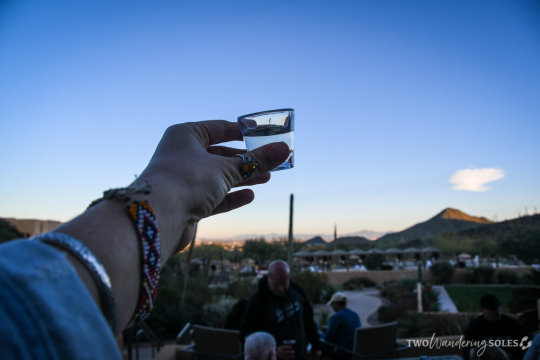
When in the Arizona desert it only seems right to have some tequila! And do you know what the best kind of tequila is?
FREE tequila!
Now that Ive got your attention, lets talk about how to get that free tequila, shall we?
The JW Marriott is in a stunning location that gives new meaning to the term desert oasis. But even if you dont have the budget to splurge on a $250-per-night room, you can enjoy unrivaled views and a free tequila toast at sundown.

Simply show up to Salud, the Marriotts on-site bar and restaurant, to take part in their nightly tradition of raising a (complementary) shot of tequila and share the legend behind the classic Mexican cheers, arriba, abajo, al central, en dentro.
And of course as soon as the story is over, everyone gathered there is invited to raise their glasses and make a toast as the sun sets. Tequila is passed around at 5:30 p.m., so be sure to arrive a bit earlier to get a seat by a firepit and enjoy the view.
And if you feel so inclined, try one of their specialty handcrafted cocktails or order your liquor straight up from their selection of more than 150 tequilas. Who knew there were so many tequilas?!
25. Mezcal Tasting

Tequila gets a lot of hype in the US; but in Mexico, people are all about the mezcal!
We learned a lot about mezcal during our travels in Oaxaca, and have been really interested in tequilas smokier cousin ever since.
Whether youre a mezcal connoisseur or youve never heard of the stuff until now, doing a mezcal tasting is a great way to learn more about Mexicos favorite spirit.
While theyre best known for coffee, each Thursday starting at 7 p.m., Exo Coffee hosts an hour-long mezcal tasting at their onsite bar.
While sipping on samples of several high quality mezcal (they have a collection of more than 150 mezcals!), proprietor Doug Smith walks guests through everything youve ever wanted to know about this liquor. This informational tasting costs $20 and reservations are not necessary.
And if Thursday doesnt work for you, tastings are also offered Wednesdays and Sundays between 6 - 9 p.m. for $25. For these tastings, you must make a reservation in advance.
If youre not interested in a full tasting, you can always come during their bar hours to enjoy beer, wine, or mezcal cocktails. They have a great happy hour from 6 - 8 p.m., where cocktails are just $5, and beer and wine are $1 off.
26. Get your giggle on at a comedy show

Weve realized that comedy clubs almost always guarantee a night of fun! Plus, its a great way to spend an evening in a new city, and most big(ish) towns around the world have at least one comedy club.
Tucson is no exception. There are a handful of comedy clubs, but it seems that Laffs gets the biggest national names in stand-up, so we decided it would be a good way to spend our Friday night.
We gave the address of Laffs to our Uber drive and had no idea what to expect, but when we pulled up to a strip mall on the outskirts of suburbia, we were a little surprised.
And when we walked inside, we soon realized this no-frills club was not going to win us over on atmosphere. So we crossed our fingers that at least the show would be good
Lets just say that we were clutching our stomachs from laughing so hard for the next 90 minutes!
Weve been to enough comedy shows to know its not as much about the atmosphere as it is about the people on stage. The comics themselves are what are going to make the experience belly-hurts-from-laughing-so-hard good or just alright.
Theres always the off-chance that youll hate the comedians style of humor (which has happened to us in a comedy club with a top-notch atmosphere!).
We were at Laffs on a night with great talent, and hopefully youll catch a great line-up as well! Our advice is to read up on the comedian who is performing to see if youll like their style, or just show up with an open mind and ready for a laugh!
And dont worry, you wont go hungry or thirsty. There is a long list of cocktails with quirky names, a small selection of beer, and a menu of pub food and snacks.
Laffs has a handful of shows each week:
Thursdays: 8 p.m. Open Mic, free show!
Friday: 8 p.m. and 10:30 p.m., doors open at 7 p.m.
Saturday: 7 p.m. and 9:30 p.m., doors open at 6 p.m.
Cost:
General Seating: $12.50
Preferred Seating: $17.50
You can pay in advance, or you can make a reservation but pay at the door.
Check out their schedule to see upcoming shows.
Psst! If youre into improv or are looking for a family-friendly comedy show, Unscrewed Theater might be more your scene.
27. Spend the evening at a Film Bar

Check Casa Film Bar's Facebook Page for New Showings
Looking for something fun and lowkey to do at night in Tucson? Oh, we have got just the idea for you!
Combine craft beer, food trucks and movies (three of our favorite things!), and youre in for a great time. Youll find this magical combo at Casa Film Bar, which is something of a local secret.
Essentially a bar inside a video rental store, come on a weekend night and youll be able to enjoy a movie showing with a craft brew (or wine or coffee).
They play films ranging from 90s classics, like Teenage Mutant Ninja Turtles, to little-known indie films, to brand new Oscar nominees (Once Upon a Time in Hollywood was playing while we were there, just 6 months after being released in theaters).
Casa Film Bar Schedule:
Films & rotating food trucks: Thursday, Fridays & Saturdays (check their Facebook page for showtimes and to see which food truck will be there).
Smartphone Trivia: Tuesdays from 7 - 9 p.m. (free to play & winners get prizes)
Food Truck only: Sundays 6 - 8 p.m., Pop's Hot Chicken is the Sunday evening staple
Not only will you be supporting one of the few standing video rental stores left, but youll be able to check out a local hot spot and have an all around good evening!
28. Live Music in Tucson

While Tucson certainly wont make the cut for top live music cities in the US, that doesnt mean you should give up hope on catching a performance. In fact, as we wandered around downtown and along 4th Ave, we heard more bands performing than we could count!
From hipster bars to honky tonks, and century-old theaters to swanky resort patios, youll have plenty of choices when it comes to choosing a spot to catch some tunes.
Here are some of the venues in Tucson that regularly host live music:
Thunder Canyon Brewery: Large brewery downtown that hosts live music.
La Cocina: This restaurant has a large menu and an even bigger patio, complete with cafe lights and live music on the weekends.
Club Congress: Its hard to beat the atmosphere youll find in Club Congress, though most acts that come through here require you buy a ticket in advance.
Ches Lounge: Yummy cocktails and beer with an outdoor patio and stage for music.
Exo Coffee: Not just a coffee shop, Exo also has a mezcal bar and hosts live music most weekend nights!
Hacienda Del Sols Terraza: If you prefer your live music with a side of class and a bottle of fine wine, the patio at Hacienda del Sol is a good place to catch some jazz or classical tunes as the sun sets.
29. Nightlife on 4th Ave

Being that this street sits directly between the university campus and downtown, it draws a young student crowd as well as a mix of young professionals and tourists. And lemme tell ya: It comes alive at night!
You can find all sorts of quirky bars, restaurants of all kinds, cafes with poetry readings, and shops selling everything from cowboy boots to hippy garb.
Walk down 4th Ave and pop into any establishment that strikes your fancy.
30. Brunch in Tucson

Need a pick-me-up after a big night out on 4th Ave? Lucky for you, Tucson has some amazing brunch options thatll get you feeling like yourself in no time!
Insider Tip: If youre looking for a kickass Bloody Mary to start your day, Elliotts on Congress is where youll want to go. Their infused vodkas make a great base for the drink, and if you like spicy, order the Habanero Bloody for a real wake up call!
And even if youre not hungover, who doesnt love a good brunch?
Seasonal fruit, eggs, flaky pastries fresh outta the oven, housemade jam youre speaking my language! Oh, and we cant forget about the mimosas and bloody Marys.
Tucson has a healthy variety of brunch spots that are sure to strike your fancy:
Prep and Pastry
Cup Cafe
Baja Cafe
Five Points Market
Cafe a La CArt
Art, Culture & History in Tucson
For lovers of all things art, history and culture, theres no shortage of ways to fill up your time in Tucson. Were sharing some of the top things to do if you want to delve into this citys history and art scene.
31. Hunt for Street Art!






Tucsons street art scene is off the hook!
Ermmm do people even say off the hook anymore? Im going to assume no, but still, you know what I mean.
Youll notice colorful murals covering the sides of buildings all over town. Depictions range from desert scenes, to whales and fish, to cultural references, to random but pretty paintings of birds
You really wont have to make much of an effort to spot murals around town, but if you want some direction, here are some of our personal favorite murals in Tucson (and their location pins):
Whale mural by Joe Pagac
Goddess of Agave
Greetings from Tucson Postcard
Girl in Barrio Viejo (Across the street from El Tiradito)
Girl by Charro del Rey
32. Visit Mission San Xavier del Bac
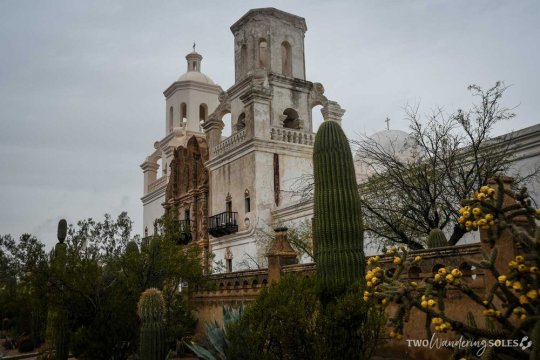
One of Tucsons most iconic buildings, the Mission San Xavier del Bac is a not only a historic landmark, but it also still operates as a church to this day. If you happen to visit on a Sunday, you might just see a church service taking place.
This building is a beautiful example of 18th-century architecture, and has been nicknamed the White Dove of the Desert. As you wander around the mission and church property, youll notice influences of Renaissance, Byzantine and Mexican architecture styles.
If youre interested in hearing about the churchs history, consider taking a guided tour. They are free to join and dont require making a reservation. Simply show up at the museum entrance to join in this 45-minute tour. Tours run quite frequently, but timing depends on the season. Check here for tour hours.

Feeling hungry? If you happen to be visiting Mission San Xavier del Bac on a weekend, keep your eyes peeled for food vendors from the Tohono Oodham Nation who often sell frybread tacos in the open-air market space just across from the mission.
Frybread is pretty much just what it sounds like, a dough (sort of similar in appearance to naan) that has been deep fried to golden deliciousness. This traditional Native American staple is then topped with different ingredients, either sweet or savory.
Weve tried frybread tacos once before, and theyre really tasty. Theyre not all that easy to find in most places, so do yourself a favor and try one while youre at the mission!
Mission San Xavier del Bac Hours:
Hours: 7 a.m. to 5 p.m.
Cost: Free, donations welcome
Insider Tip: If you arrive in Tucson at a reasonable hour and arent too tired, wed recommend heading straight to Mission San Xavier from the airport, as its quite close (and a bit out of the way to come from downtown Tucson). Alternatively, you could stop for a quick visit before heading to the airport on your way out of Tucson.
33. Visit the historic Hotel Congress

It might seem strange that we have a hotel on our list of things to do, but hear us out...
Nestled right in the center of downtown, Hotel Congress is the stuff of local legends. Built just after the turn of the 20th century, it was here that John Dillinger, an infamous American gangster during the Great Depression era, was arrested and brought to jail.
Although he later escaped, Tucsonians take great pride in the fact that Dillinger, a prolific bank robber, was caught in their city. They are so proud, in fact, that there is an annual celebration and recreation of these events which takes place each year in mid-January (we were actually there for it!).

Hotel Congress still retains its quirky, colorful, historic charm. And walking into the lobby feels as if youve stepped back in time. Grab a drink at one of the many onsite bars, or catch a concert at Club Congress. And if you want to spend the night, the historic rooms are cozy, however, there is a caveat...
Our honest opinion: We stayed at Hotel Congress during our trip to Tucson, and while we would definitely recommend stopping in for a drink and checking it out, we would not advise staying here unless youre in Tucson to party.
They dont try to hide the fact that this hotel gets loud like really loud at night. There are even ear plugs in each room. Lets just say we did not sleep very well during our entire 3 nights in Tucson.
Interesting Fact: It is said that Hotel Congress is haunted! While were not ones to really believe these things, we did have a very weird experience where our closet door swung open suddenly. And at night, the 2nd floor where we were staying smelled like smoke from a fire. Spooky...
34.DeGrazia Gallery in the Sun
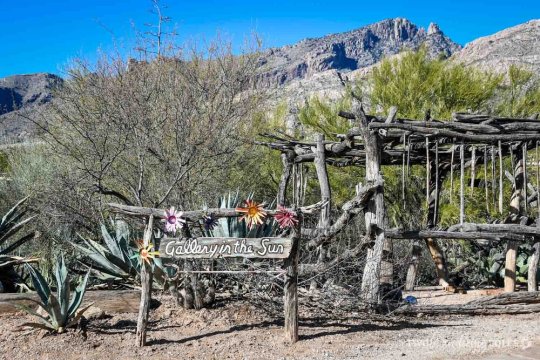
If youre an art buff, the DeGrazia Gallery in the Sun makes an interesting stop. This is a gallery dedicated to the works of one man: Ettore Ted DeGrazia.
Dont worry, I hadnt heard of him either; but DeGrazia is pretty well-known in Arizona.
So who is Ettore DeGrazia? Well, heres the short version:
DeGrazia was born into a family of Italian immigrants who lived in a mining camp in rural Arizona. Ettore later enrolled at the University of Arizona, and created a life around his passion: art.
In adulthood, he married (twice) and bought a 10-acre plot of land in the foothills of the Santa Catalina Mountains which would become both his home and gallery.
His works were underappreciated for many years until his oil painting Los Nios was selected by UNICEF to be printed on a 1960 holiday card, which sold millions worldwide. DeGrazias fame spread during the next decade, drawing hundreds of thousands of visitors to his gallery each year.
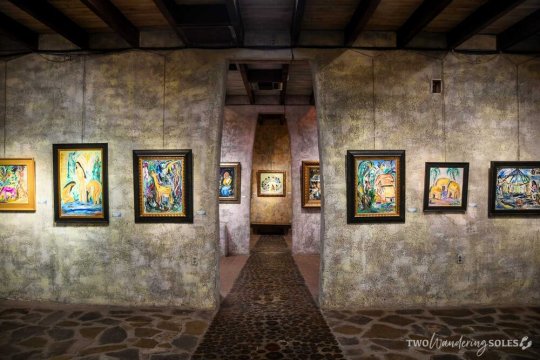
Visiting the Gallery in the Sun
A visit to the Gallery in the Sun will leave you in awe at the sheer amount of artwork DeGrazia created in his lifetime. The museum has a rotating collection of more than 15,000 DeGrazia originals! Anyone else wondering how he had enough hours in the day to make all of this?!
DeGrazia liked using all different mediums. Youll see oils, watercolors, sketches and even pottery on display. And another impressive fact is that the gallery was designed by DeGrazia himself.
When you visit the Gallery in the Sun, not only will you see DeGrazias artwork, but youll also be able to walk through his home and his private chapel, both of which are on the property.
Hours: 10 a.m. to 4 p.m., daily
Cost: $8 for adults, $5 for ages 12-18, children under 12 are free
35. Wander the gardens at Tohono Chul
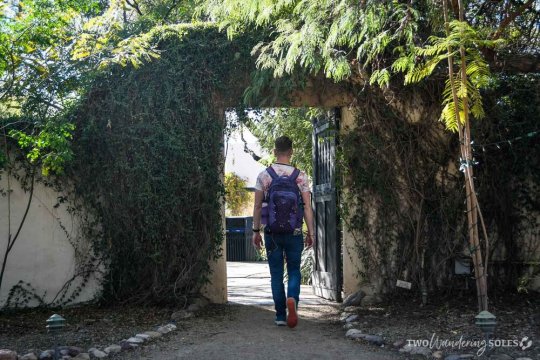
Hailed as one of the countrys best botanical gardens by Travel + Leisure, Tohono Chul is popular with locals and visitors alike. Covering nearly 50 acres, this is said to be a place where nature, art, and culture connect.
But were not gonna gloss over the fact that when we visited in mid-January, there wasnt all that much to see due to the transition of seasons.
Wed imagine during other times of the year, there are more things to see. Weve heard March is particularly beautiful with the desert flowers starting to bloom. They also host occasional live music and other events throughout the year.
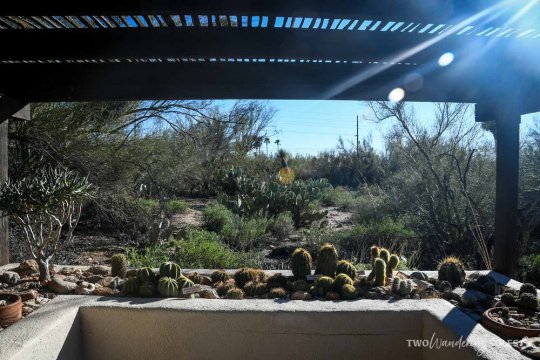
Our Opinion: Before planning your visit, wed do some research to see if it will be worthwhile during the season in which youre visiting. Perhaps between the months of March and May there would be more to see, as the desert flowers are in bloom during this time.
Hours: 8 a.m. - 5 .p.m.
Cost: Adults - $15, Children (5-12) - $6, Children under 5 - Free, Seniors (62+) - $13
36. Explore Barrio Viejo
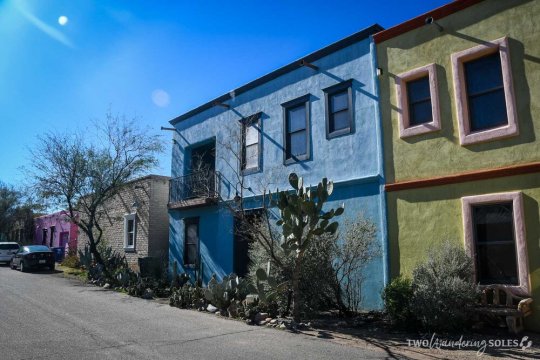
Translating to old neighborhood, Barrio Viejo is just that: a section of Tucson that still has old charm. Sometimes called the real "soul" of Tucson, you can drive around and see colorful Spanish Colonial architecture and find authentic Mexican restaurants.
While some parts of the neighborhood are lively, there are other sections that have a run-down feeling.
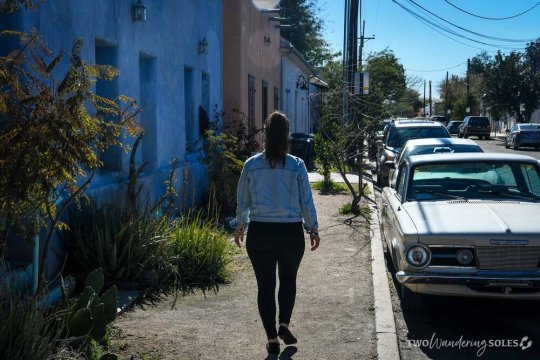
We drove around Barrio Viejo for a while trying to find some of the beautiful, colorful adobe houses we had seen pictures of.
So to point you in the right direction (and minimize your time spent driving around in circles like we did!), here are some points of interest in Barrio Viejo (Note: please be respectful in this neighborhood because people do live here):
Colorful houses on S Meyer Ave and W Kennedy St (and further south on Meyer Ave until 22nd St)
El Tiradito Shrine (described below)
El Minuto Cafe: Mexican restaurant next to El Tiradito
The Coronet: brunch and late night food
Five Points Market & Restaurant: cute and lively brunch spot
Cafe Desta: popular Ethiopian restaurant
37. Visit El Tiradito Shrine
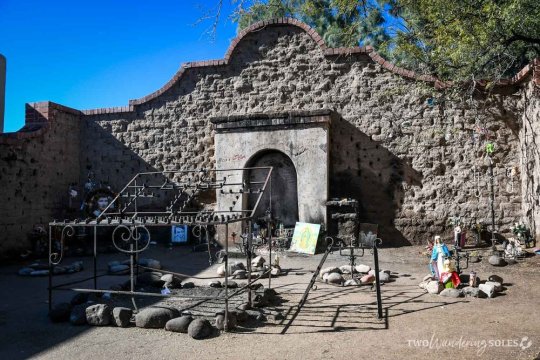
If youre exploring the Barrio Viejo neighborhood, make a quick visit to the El Tiradito Shrine. Stopping here only requires a few minutes and to the naked eye its nothing too special.
It is scattered with candles, flowers, and images of saints. But this is no ordinary shrine, folks. And once you know the legend behind this shrine, its kind of an interesting place to see.
Nicknamed the wishing shrine, El Tiradito is the USs only Catholic shrine dedicated to a.... wait for it SINNER! Scandalous, I know. But thats not even the crazy part.
Heres the short version of the legend of Juan Oliveras, the man who is buried beneath El Tiradito Shrine: Juan, a young ranch-hand, is married to his bosss daughter, but soon becomes infatuated with his mother-in-law (yep, you read that right), and makes a move. The two carry on an affair, which is eventually busted by the husband/father-in-law/boss. Ouch!
He gets so angry that he kills Juan right there before escaping to Mexico, where he is later murdered. The wife allegedly kills herself, and after all this horrifying drama and death, the daughter (who, by the way, we should mention is pregnant with Juans child) hangs herself as well.
It is said that Juan is buried beneath El Tiradito, a shrine that people visit for all different reasons. Some come out of sheer curiosity about the legend and others see it on a things to do in Tucson list, like this one!
But there is another group of people who come to this spot: Those who empathize with Juan and have similar love triangles in their own lives. It is said that if you write your wish on a piece of paper and have good intentions, it will come true.
Just behind the shrine is a crumbling brick wall, and if you look closely, youll see scraps of paper stuffed in the holes between bricks, many of which are wishes from past visitors.
This shrine was almost demolished when the city was building a new highway, but people in the community fought to preserve it. Perhaps they want to protect history, or maybe some people are protecting their wishes!
38. Step back in time at Old Tucson
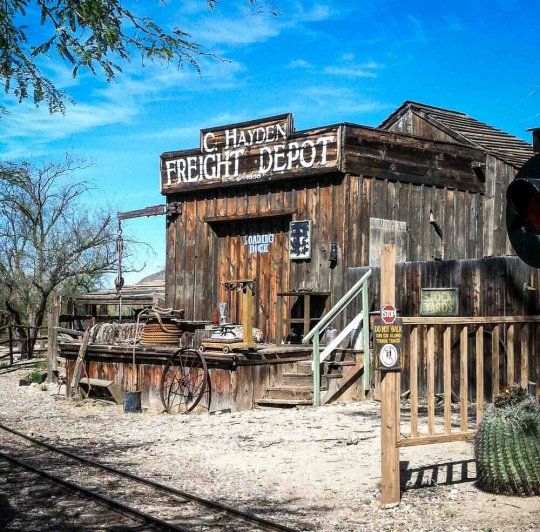
Old Tucson | Photo Credit: My Mom ;)
Walk through what looks like a scene straight out of a John Wayne film, and watch as actors from the Wild West perform demonstrations and stunts.
Old Tucson is an amusement park of sorts, complete with a town hall, a saloon and a haunted mine, like all good Western desert towns have.
We didnt have enough time to visit Old Tucson during our weekend trip, and to be honest, it didnt really seem like our type of place. However, if youre looking for things to do in Tucson with kids, this could be a fun activity for a family.
Be sure to look up the schedule of events to time your visit right.
Cost: Adults: $21.95, Children (4-11): $10.95, Children under 4: Free
Hours: 10 a.m. to 5 p.m. (times may change seasonally)
Best Tucson Weekend Itinerary

Are you overwhelmed with the massive list we just gave you?
Dont worry, were going to help you pare it down a bit. Below, weve listed some highlights you can choose from based on your travel style:
If you love the outdoors:
Visit Saguaro National Park
Hike to Seven Falls in Sabino Canyon
Drive up to Mount Lemmon and stop on the way for hikes and lookout points
Explore Romero Ruins in Catalina
If youre traveling with kids in Tucson:
Do the Classic Tour at Colossal Cave
Sonoran Desert Museum
Go horseback riding
Order an ice cream flight at The Screamery
Visit Old Tucson
If youre into food:
Eat a Sonoran Dog
Check out our list of top Mexican food and try as many as you can!
Have a leisurely brunch
Order an ice cream flight at The Screamery
Go on a Tucson food tour
Try a vegan Mexican meal at Tumerico
If youre an art & culture lover:
Check out the Degrazia Gallery in the Sun
Explore Barrio Viejo and visit El Tiradito Shrine
Visit Tohono Chul botanical gardens (if the time of year is right)
Spend an evening at Casa Film Bar
Visit the Tucson Museum of Art
If youre into nightlife:
Tequila toast at the JW Marriot at sunset
Go brewery hopping
Scope out some live music
Grab a drink at Hotel Congress
Head to 4th Ave after dark for a night on the town
Do a mezcal tasting
If youre on a budget:
Do the scenic drive to Mount Lemmon
Go on a scavenger hunt to find as much street art as you can!
Watch sunset at A Hill with a view over Tucson
Have a picnic lunch
If youre craving adventure:
Go mountain biking
Go horseback riding
Book the Ladder or Wild Cave Tour at Colossal Cave
Hike to Seven Falls in the Sabino Canyon
Best time to visit Tucson, Arizona
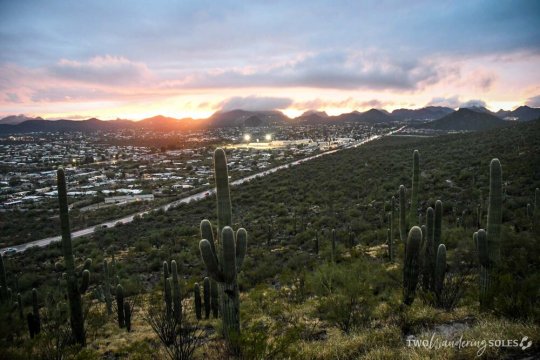
Tucson is a great destination year round, however it can get quite hot in the summertime (albeit a dry heat). June is the hottest month in Tucson, with average highs soaring to 103F (40C). Yikes!
For the most comfortable temperatures, plan your trip to Tucson between mid-September and mid-May.
Even during December (Tucsons coldest month), the average temperature hovers just above 50F (10C) and it rarely dips below freezing. This weather will feel downright balmy to anyone from the Midwest (peace out Polar Vortex!).
Being that Tucson is smack dab in the middle of the desert, there is little chance that rain will ruin your vacation (unless youre traveling during the monsoon season of July and August). We arrived in Tucson on a rare rainy day, but by the next morning, most of the puddles had evaporated and there wasnt a cloud to be seen!
Another thing to keep in mind about this desert city is that temperatures can drop drastically from midday to evening. Be sure to pack layers to keep warm during the nights.
When Do the Desert Flowers Bloom?

It depends on the plant, but the flowering season is from mid-February to mid-June, with the biggest blooms peaking from mid-March to late April. Each year is different depending on rainfall, freezing temperatures during the winter, and springtime weather during the growing season.
Where to Stay in Tucson
Most of the time when were visiting a city, we like staying downtown so we can walk places and be near all the major sights. But depending on your interests, Tucson is a place where wed actually say you dont need to stay in the city center. As you can see from reading our massive list of things to do, many of Tucson's major attractions are on the outskirts of the city.
Weve rounded up some recommended Tucson hotels and Airbnbs below, with a mix of locations in the city as well as some that are a literal desert oasis.
Hotels in Tucson, Arizona

JW Marriott Tucson Starr Pass Resort
In the foothills of Tucsons Mountain Park, sits the massive JW Marriott Tucson Starr Pass Resort. With easy access to Gates Pass and the Western Side of Saguaro National Park, this resort has a great location. It also has 3 golf courses, 4 restaurants (with a daily tequila toast!), and 3 outdoor pools, you can really enjoy your stay in Tucson.

Azure Gate B&B
Located in NE Tucson, this charming B&B is a quick drive to the Sabino Canyon Recreation Area or the East Side of Saguaro National Park. Included in each stay is daily ( breakfast, an onsite pool, and free parking.

Hotel McCoy - Art, Coffee, Beer, Wine
This modern hotel is perfect for a couple or a family who wants to stay a little bit outside of downtown. There are murals everywhere (check out the pictures!), an excellent staff, and a daily continental breakfast.

Hotel Congress
If youre looking to stay downtown, Hotel Congress has an unrivaled location. Add to that its historic charm, and you might be ready to book. However, we would be remiss if we didnt mention that this hotel is directly above a club, and it can get incredibly loud on weekend nights.
So loud, in fact, that the hotel provides guests with ear plugs. If that doesnt scare you away, then you might love staying at this historic property.
Airbnbs in Tucson
There are tons of amazing Airbnb options in Tucson. Overall, they are very reasonably priced, and some even have pools. Just take a look at some of the Airbnbs we hand-selected for you!
Insider Tip: Find out how we set our Airbnb filters to find the best properties anywhere in the world!

'Case Study' Guest House: Charming guest house and hosts. Youll have the entire place yourself with a full kitchen and a rain shower in the bathroom. Southeast of Downtown. Check Availability here.

Historic 4th Ave Herbie House: Beautiful studio apartment in the 4th Avenue Neighborhood. Close to bars, restaurants and the metro stops. Check Availability here.

Sonoran Desert Retreat: This inexpensive but lovely place is located in the Catalina Foothills close to shops and restaurants. This would be perfect for a couple looking to get away from the busyness of town. Check Availability here.

Self Check in Airbnb - Near I-10: This cheap Airbnb is located in the northern suburbs of Tucson and is great for a solo travel or a couple wanting to mountain bike the local tracks. Its a small, clean studio, but it has everything you need for a basic stay. Check Availability here.
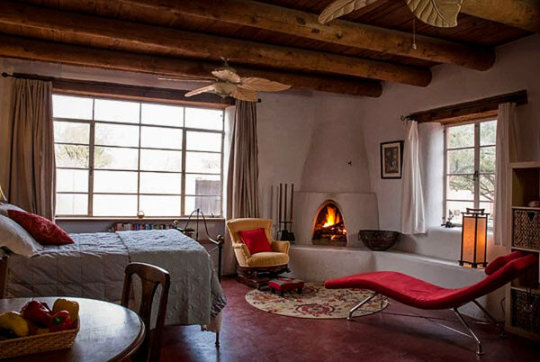
Tucson Poet's Studio: This Santa Fe Style studio comes with a beehive corner fireplace and a small lounging outdoor pool. Its pretty close to central Tucson just a few blocks east of the university, so its a great location for exploring. Check Availability here.
Psst! Is it your first time using Airbnb? Follow this link and well give you $55 off Airbnb!
Getting Around Tucson
While Tucson itself is a relatively small city, youve probably noticed that most of the major attractions are outside the center. In order to be able to see the best things to do in Tucson, you really do need a car to get around.
Rental Car

If youre flying into Tucson, you can pick up your rental car at the airport. We usually reserve cars through RentalCars.com because we have used them before and they have the best deals for rental cars. When searching I found deals around $36 per day for a standard sedan, which is all you would need in Tucson.
However, this time, we tried reserving our rental car through our American Express Platinum card and we found the same cars for about $23 per day! This saved us about $40 over the 3 days we were visiting Tucson. Head to this article if you want to learn more about the travel credit cards we use to get free or discounted travel.
When driving in Tucson: Be aware that some areas have speed traps enforced by cameras, so keep an eye on your odometer.
Uber or Lyft
If you plan to have a few beverages out on the town, dont risk driving. Instead, order an Uber to get you where you need to go. Downtown Tucson is not that big so rides are pretty cheap.
Metro
In Tucson there is a Light Rail metro line called the SunLink that connects University of Arizona to the 4th Ave District to Downtown (Centro) and finally to the Mercado District including Mercado San Agustin.
For a single one-way fare it costs $1.75, but you can purchase a 1-Day SunGO ticket for $4.50 which is good for 24 hours.
What to pack for a trip to Tucson

Camelback (if you think youll be hiking a lot)
Daypack for hikes
Chacos or other hiking shoes that wont get too hot
Closed toe shoes (for horseback riding or mountain biking)
Layers (it gets cold at night and hot during the day)
Swim suit (if your hotel has a pool)
Sunscreen
Sunglasses
Reusables: Weve been kind of living in a bubble in Oregon where plastic bags are banned and many establishments encourage you to bring your own reusables, or provide a somewhat eco-friendly option (like wooden utensils and paper straws).
While many Tucson restaurants and accommodations, like Charro Vida, Boca Tacos y Tequila and Hotel Congress, offer eco-friendly options, there is still a lot of room for improvement when it comes to reducing unnecessary waste (just like many other cities around the U.S.).
We had our reusables packed (as we always do!) which helped a bit, but it was still a challenge.
Responsible Travel Tip: Pack your reusables (listed below), and eat inside restaurants as much as possible to avoid waste like styrofoam and plastic utensils.
Its difficult to avoid it altogether, but wed recommend bringing the following to help you reduce the waste you create:
Coffee tumbler
Utensil set (great for picnics!)
Reusable straws
Reusable bag (one that stuffs up like this is great!)
Water bottle
For more tips on how to reduce your waste while traveling, check out our article on 18 Simple Ways to Reduce Your Plastic Use Everyday.
You May Also Like
31 Best USA Road Trips
7 Best Desert Hikes in California Most Don't Know About
Las Vegas on a Budget: 17 Cheap Things to Do
Plan a Trip to Zion National Park
Going to Tucson soon? Share this Article on Pinterest!
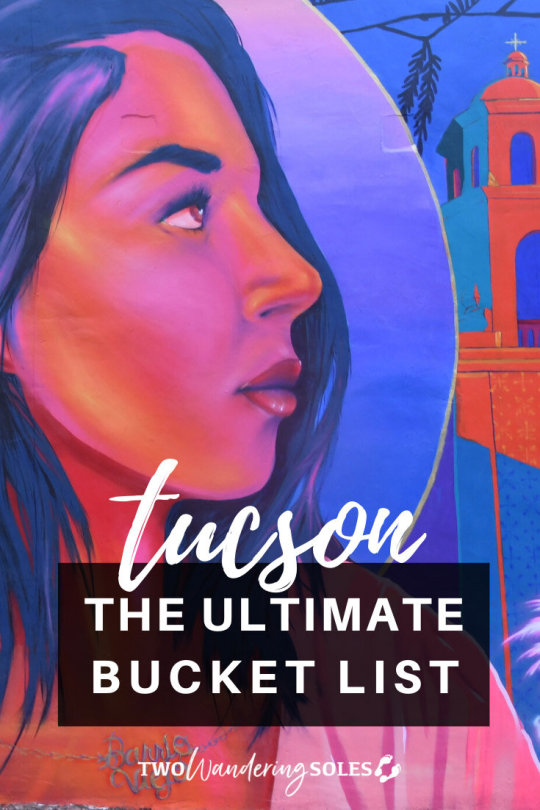

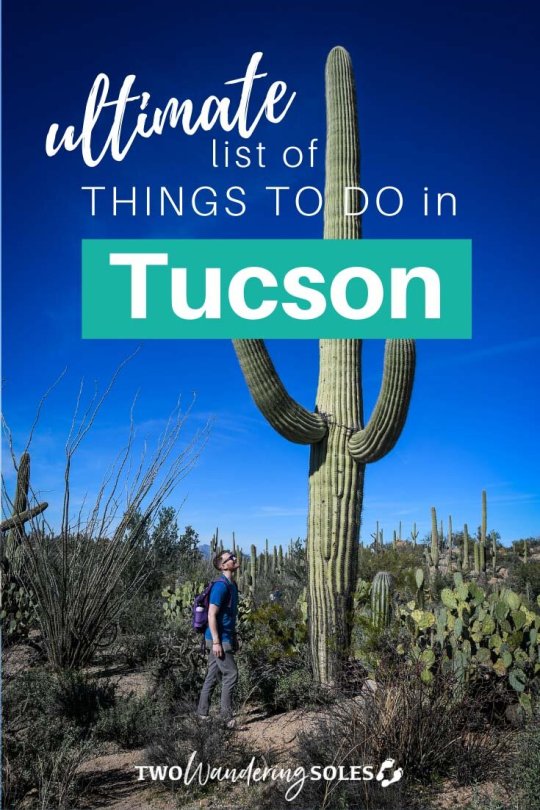

We want to hear from you!
Are you planning a trip to Tucson? What things are on the top of your list? Do you have any additional questions for us? Write to us in the comments below and well do our best to get back to you!
Arplis - News source https://arplis.com/blogs/news/38-fun-things-to-do-in-tucson-arizona
0 notes
Photo

Luz Medina Bonta
Article by Mark A. Bonta
Photo by Rebecca Schmidt
In October 2010, Luz Medina Bonta’s Madreselva Collection – 15 silk, cotton, and bark cloth outfits colored with natural dyes – premiered on the runway at Fashion Week Honduras. This marked the first time that truly ecological fashion had been on display in that country, and the first foray into high fashion for a Honduran-born artist based in the Mississippi Delta. But most notable about the Madreselva Collection is the fact that it is the culmination of a non-profit effort supported by the United Nations Development Program, the Honduran government, and the indigenous development organization MOPAWI to showcase the skills and potential of indigenous Miskita women artisans from the remote Mosquito Coast region.
The project, Bonta’s brainchild, demonstrated decisively that traditional Honduran natural dyeing and color-fixing techniques, when combined with the expertise of a trained artist, can lead to the creation of clothing of sufficiently high quality to be attractive in even the most demanding of markets. This is a far cry from the typical emphasis on handicrafts for the tourist trade, and has potential to return a much higher profit to local artisans. Bonta, who herself grew up in small Honduran town, is keenly familiar with the struggles of impoverished rural women in her country, who are particularly marginalized in the Mosquito Coast and in her own home province of Olancho, along the rainforest frontier. Indeed, Bonta’s entire professional trajectory has been grounded in the realities of daily life in the Honduran ‘outback,’ one of the most underdeveloped terrains in the Americas.
Luz Medina Bonta, growing up in Juticalpa in the 1980s, first became fascinated with natural dyes through observing the turmeric (curcuma or yuquilla) and annatto (achiote) her grandmother put in foods to turn them a pleasing yellow or orange. But by that time Honduras, like almost every country, had been using synthetic dyes for its fabrics for over a century, and natural dyes were retained only for certain household uses, an important part of the culture but a distressing loss when you consider that at one time, native indigo had been the major ingredient of ‘Mayan Blue’ used by the rulers and scribes of the great city-state of Copán in western Honduras. Indeed, Honduras, part of the vast cultural domain of Mesoamerica that gave the world such staples as corn, tobacco, and several races of cotton, had known cochineal dye from the scale insect, purple dye from molluscs, and numerous natural colors of all hues from the amazing diversity of plants that grew in its forests and grasslands. After contact with Europeans, Honduras came to play a key role in the international dye trade—which at one time was centrally important in the world economy—and was particularly known for its brazilwood and fustic.
But as is always the case, as the centuries wore on, only the remotest of Honduran communities—often those that were still indigenous—retained knowledge of these and dozens of other natural dyes. But even where the plants and some of the dyeing practices are still remembered, natural colors typically only emerge through the work that certain cooperatives do in creating handicrafts. Even on the Mosquito Coast, as Bonta discovered, only a few of the many local natural dye plants are still used regularly, and in most cases the necessary color fixing techniques have been lost or neglected; without these mordants – which can often be obtained from alum or various muds – cloth easily fades in the sun and colors run upon washing.
The rescue of Mesoamerican dyeing techniques is already well advanced in countries such as Mexico and El Salvador, but lags far behind in Honduras. Bonta’s years of experimentation as a student in the fiber laboratory at Delta State University—often with local plants such as osage orange, elderberry, and goldenrod—had shown her the potential of such dyes, and also their generally benign effects on human health. By contrast, synthetic dyes, not to mention certain mordants, can be extremely hazardous. But natural dyeing is far more than producing ‘natural colors’—it also is compatible with a wide range of stamping, tie-dyeing, Shibori, and other techniques, and like all textile art, demands a high degree of imagination and skill in the elements of design. The production of a naturally-dyed AND (and mordanted fabric) is labor-intensive, but the next step—the creation of a wearable garment that is attractive to potential consumers—adds several more layers of complexity. Nevertheless, Bonta believed it possible to start ‘at the tree’ so to speak, literally in the middle of the Honduran rain forest, and end up on the runway, without the use of synthetics and without damaging the environment. That is to say, the entire process of creating the Madreselva Collection was to be sustainable and earth-friendly to the maximum extent possible.
It went without saying, then, that the natural dyes had to be applied to natural fibers. Honduras, while once an important producer of cotton, today is known primarily for bark cloth (tuno and tuno blanco) harvested from certain trees, including a species of rubber. The fabric that results is highly versatile and receives several natural dyes extremely well; Bonta worked with these on the Mosquito Coast as well as with raw cotton and various silks that were not available locally. During the course of summer seminars with the Miskita women, Bonta not only worked with the dyes the women were already using for handicrafts, but also introduced dyeing with the sawdust of mahogany from a local sustainable-harvest cooperative, and with the wood from branches of various other rainforest trees. In another part of the country, Bonta obtained sawdust from a ‘waste tree’ known as palo de brasil— the brazilwood or brasiletto, once one of the most famous sources of red hues and now a forgotten species. Once the requisite amount of fabric had been prepared, it was ‘simply’ a matter of having the 15 outfits sewn, as well as training 15 volunteer models and dealing with all the other minutiae involved in putting on a runway show. In Bonta’s case, this was mostly achieved long-distance, via Facebook, as she had commitments in Mississippi up until almost the last minute. This included some desperate fundraising in the Delta, as the funds provided in Honduras had run out, and not doing the show was not an option. Indeed, the stateside fundraising showed just how interested many people were in this unique effort to marry indigenous artisanry and the ‘save the rainforest’ mantra with ecologically-sustainable fashion. In addition, the ‘tree to runway’ demonstration project is also the topic of Bonta’s presentation at the International Symposium and Exhibition on Natural Dyes (ISEND-2011) in La Rochelle, France, where she will hopefully be joined by two of the Miskita women involved.
As has been hinted at several times, there are many benefits for an income-strapped country like Honduras in the rescue of natural dyes and fibers. If a fair-trade model can prevail and a demand develops, then income generation for small producer groups will follow. Natural dye sources are found throughout the country, not just in the rainforest: indeed, any community can start a dye garden and quickly grow their own dyes, which have value on their own (particularly well-known ones such as indigo and brazilwood). Most importantly for many, the harvesting of dye materials can be sustainable, through the removal of fallen limbs and other non-harmful practices; this is particularly attractive for conservationists looking for ways that local communities can be enticed to preserve natural resources. Of course, successful initiatives, especially those that seek internationally-recognized certification, need to adhere to strict environmental standards, since even the use of firewood for heating dye pots, and disposal of waste materials, has to be done in an ecologically correct manner.
There is also the matter of accessories: Bonta was delighted to discover that the women of Krausirpi, along the Patuca River in the Mosquitia, are already producing naturally-dyed handbags woven of majao, a fiber from the bark of certain trees. Using her ceramics skills, she also made the jewelry for the Madreselva Collection, and she points out that small-scale pottery production still exists in Honduras, thus there is plenty of potential for artesanal involvement in the creation of a wide range of fashion accessories.
Realizing that all the supply in the world comes to naught if the demand is not there—and the means to connect the two--Luz Medina Bonta brought her demo collection back to Mississippi to begin the arduous task of promoting the Madreselva Collection overseas, helping it stand out in the burgeoning ecofashion world, on a shoestring budget but with strong ties to the Delta artist and university community, and via Facebook with kindred souls across the planet. She hopes to attract interest in what she has done and what she can do, and by extension what the women of Honduras can do, if somebody invests in them and helps them connect to the world.
0 notes
Text
Urgency
400 miles south of New Zealand’s mainland, across a vast expanse of the South Pacific Ocean, there is a mountainous, subantarctic World Heritage Site known as Campbell Island. While otherwise noteworthy for a few different reasons, this uninhabited isle made news recently for its possible role in determining when, exactly, the Anthropocene began.
A proposed term for our current geological epoch, the ‘Anthropocene’ is meant to demarcate the point from which humanity began to profoundly impact the biogeochemical systems of Earth as a whole. While it has yet to be officially adopted and accepted by the appropriate institutions, there can be no doubt that humans are doing exactly what it describes. More on that in a moment.
Back to Campbell Island; scientists made the long journey down there a few years back in order to check in on what is known as ‘the world’s loneliest tree’. A perpetually juvenile Sitka spruce (Picea sitchensis) planted by the governor of New Zealand in the early 1900s. This conifer’s closest arboreal neighbors are 170 miles away. It is also in a completely different hemisphere from the nuclear bomb tests whose fingerprints the scientists were looking for.
Ambient spikes in atmospheric radiocarbon during the 1950s and 1960s have been detected in the northern hemisphere in everything from tree rings to lake sediments. To detect it half a world away from where the tests were actually happening though, the authors reasoned, would surely be the clearest evidence possible that the actions of humans are radically affecting the globe in ways that will be detectable in geologic records for eons to come. Not only did a sample of this lonely tree demonstrate the expected radiocarbon spike, but they could pinpoint a high point between October and December of 1965; a perfect match for the one known from the northern hemisphere. [1]


Campbell Island and a failed attempt to spruce it up a bit.
Personally, I think the fact that there’s a Sitka spruce growing on Campbell Island in the first place is a sign that something’s not right, but the study does put a rather fine point on things. We are at an absolutely critical juncture in our history, and in the history of the planet. Whether we start the clock on the Anthropocene or just admit that that’s what the Holocene has been all along, we are surrounded by ecological crises of our own make.
The largest and most well-known of these is of course climate change. The environmental boogeyman that for most of my adult life has felt like a threat perpetually looming just over the horizon, has finally arrived in earnest. Last year alone, and in the United States alone, climate change put up numbers that would make Godzilla blush. Through a combination of extreme wildfire, flooding, hurricanes, tornados, winter storms and droughts, megadisasters influenced by climate change caused:
At least $306 billion in damages (the costliest on record for U.S. natural disasters). Some estimates say it was closer to $400 billion.
16 separate events costing $1 billion or more.
Over 1,100 deaths (most from Puerto Rico).
4.7 million people registering for Federal disaster aid via FEMA.
That, unfortunately, is expected to become the norm rather than the exception during the years to come. [2] And that’s just the start of the human cost. Throughout the coming century, temperature-related deaths in the U.S. are projected to dramatically increase under climate change – to the tune of tens of thousands every single year. If we do nothing to mitigate climate change, the word ‘tens’ becomes extremely plural. [3]
Elsewhere, rising sea levels due to climate change have already swallowed up 13 small islands in the Pacific Ocean, while shrinking several others considerably. [4][5] The San Francisco Bay area is currently undergoing 2 mm of sea level rise per year. Treasure Island is already sinking, and estimates are that anywhere from 20 to 165 square miles of the mainland, including half of the San Francisco Airport, will be lost by 2100. This kind of overwhelming challenge is being faced by densely populated coastal communities like Florida and New York City all over the country – challenges that no sea wall will abate. [6]
Up north, not only do we have to worry about a potentially nightmarish negative feedback loop caused by the release of ancient methane reserves from a melting permafrost (1,400 billion tons of carbon are locked away up there at the moment – a volume that would take humanity decades to match) [7], but we’ve also recently discovered that the permafrost is holding down about 15 million gallons of frozen mercury; almost twice as much as the rest of the world holds combined, and about 10 times more than all anthropogenic mercury emissions over the last 30 years. [8]
As if climate change wasn’t enough to contend with on its own; we are also in the middle of an extinction crisis. Modern extinction rates have recently been found to be an order of magnitude worse than previously thought – up to 1,000 times higher than the ‘standard’ rate. [9] At that pace we are hurtling towards a sixth mass extinction event, and it is anyone’s guess when we will finally hit the event horizon on that terrible legacy. [10] If we do cross that line though, then we will have truly made our mark on the Earth and its fossil record. Previously, it has taken between 5 and 10 million years for Earth’s biodiversity to fully recover from an extinction event – perhaps up to 30 million in the very worst cases. [11][12] The minimum recovery time there is more than twice as long as humans have existed as a species on Earth.
The list of modern ecological crises and their shocking urgency could fill volumes. The point of this though, is that we alive today are uniquely positioned in geologic history to make a real, lasting difference. As the first self-aware extinction event, what we do, or do not do, will echo through the eons. In light of that, I believe that humanity today faces one of the most important tasks in our entire history. Maybe you believe that it is important to preserve biodiversity for its many immediate and direct benefits to humanity. Maybe you believe that things will take too long to recover after an extinction event, and that humanity would not be able to endure the re-calibration period. Maybe you just really, really love nature in all its wonder, and it is important to protect what you love. Whatever your reason may be, we have a lot of work ahead of us.
Fortunately, not only do we have one of the most important tasks ever ahead of us, but there are direct, immediate and effective actions we can take today in order to tackle the afore-mentioned crises. According to a new study published in the Proceedings of the National Academy of Sciences, reforestation and better land management practices could reduce carbon emissions by 11.3 billion tons/year by 2030. That would be the equivalent of completely stopping the burning of all oil worldwide. By itself, this type of action could provide 37% of the total emissions reductions necessary to keep global average temperature increase below the critical 2 degrees Celsius threshold. [13]
Is this really achievable though? While of course no single person or institution could possibly do all that is required, if we maintain the right perspective, it becomes clear that this goal is achievable if we truly will it. At my place of work, Ash Creek Forest Management, our rough internal estimates show that the millions of native plants we have installed over the years are enough to sequester ~20,000 tons of CO2 annually. And that’s just Ash Creek. Combine that with the work being done by other contractors and non-profits in Oregon’s Willamette Valley where we operate, then combine that with the work being done by dedicated, passionate people all around the world, and you start to see how, in aggregate, our actions can add up and make a real, meaningful impact.
Every single season that we plant, that annual sequestration we provide shoots up significantly. Every single Ash Creek Crew Member who has made it through an entire planting season has personally planted at least 40,000 native trees and shrubs in this place we call home. Now consider how many a whole crew can put in, or a whole company. What could humanity do, if we truly willed it?
Every tree that survives to maturity will absorb an average of 48 lbs of carbon every single year. Every acre of healthy forest we produce will absorb enough carbon to offset the annual emissions of two cars. [14] It adds up! Ash Creek alone has restored over 5,000 acres of habitat thus far. That’s over 10,000 vehicle emissions that we have completely neutralized. And that doesn’t even touch on the various benefits to wildlife habitat, water quality, erosion control and more (all factors in that extinction crisis mentioned above). Not to keep belaboring the point, but if that’s just one small company in western Oregon, what could all of us do?
So plant hard. Take this seriously; like there are hundreds of billions of dollars in damages at stake. Like there are tens of thousands of lives at stake (at the very least). Climate change and the extinction crisis are not the kind of flashy, in-your-face disasters that usually incite action, like a terrorist attack or a derailed train. They are slow burning, insidious, creeping threats that are easy to ignore or dance around. They deserve the same decisive action as any other disaster though. So let’s do something about them now while we still can.

If you want to do your part, I guarantee that wherever you live, there are some hard-working and under-funded nonprofits that would be extremely grateful for your time and effort. I’ll even help you find them! Send me a message if you want to volunteer but don’t know where to start; I’ll work with you to find a group that would be a good fit for your skills and interests. If you happen to live in Oregon’s Willamette Valley, my own group, the Willamette Restoration Volunteers, would love to have you join us on our projects!
#Climate change#mass extinction#Extinction crisis#Campbell Island#Anthropocene#carbon sequestration#restoration#reforestation#land management#volunteering
0 notes
Text
On Unusual Career Choices or ‘WTF Am I Doing Anyway?’
Dear Nobody,
October 31, 2017: I’m writing this from my field station, far from home, in a remote village in the far-flung state of Arunachal Pradesh, India. I first arrived here in October last year, where I then spent the next nine months managing a wildlife conservation program that involves the local tribal community. I’m back here again until next July. The past one year has been one crazy adventure, with all the trials and tribulations that come with living and working in the field for such long periods of time. I get so caught up with day-to-day life that I barely spend any time reflecting on the vast majority of these experiences. I would like to take some time out to do this before it all fades from memory, and I would like to share my thoughts with you. Having someone listen to you sometimes validates your experiences. So, while I know this is a selfish gesture - because I’m writing more for myself than for you - I do hope that it will prompt you to share things with me in return, if you should feel like it.
I’m going to start by telling you how to get to our field station located in this remote village in Arunachal Pradesh. It is, after all, the first hurdle. The easy part is the direct flight to Guwahati, the capital of the neighbouring state of Assam. Once you land, the quickest and most convenient option is to take a taxi to our destination, which is 6-7 hours (about 260 km) away by road. However, since this taxi ride costs as much as the airfare to Guwahati, you will often take the other more painful route. First, you take an Uber from the airport to a location 25 km away from the city. Here you’ll find a big government interstate bus stand and further down, another unofficial (basically illegal) stop with a line of tempo travellers. You head for the latter. But brace yourself because there will be a crowd of young men here, all talking at you in rapid Assamese, tugging at the suitcase or backpack you might be carrying, insisting that you get on board their traveller. Beware because they will tell you anything you want to hear. “Are you going to Place X?” “Yes, yes, madam, of course.” A few hours later, you may find yourself and your luggage on the highway, waiting for another mode of transport because apparently the traveller you took was going to Place Y. Assuming you took the right traveller though, you will reach Place X, a busy township. You then shoulder your massive backpack or drag your heavy suitcase a little way down the road and across a major intersection, get on another traveller which passes by Place Z. If you make all the connections in time, you will get off at Place Z and might be able to take the bus which goes to our destination. If not, you’ll be stuck haggling with a few local taxi drivers until they’re willing to take you down the terrible 20 km stretch of road to our village for a reasonable price. Once you get to the check gate at the border of Assam and Arunachal, you will see a looming, rather un-aesthetic archway that says ‘Welcome to Place XYZ’, where the driver will pay Rs. 50 so that his Assam registered car can enter Arunachal without a permit (a bribe, in other words). If you’re unwilling to cover this ‘extra charge’, then you’ll be dropped off unceremoniously at the check gate, walking the remaining 1.5 km to our field station in the village, luggage in tow. This entire journey from home, starting with the commute to the airport, until you arrive at the field station may take about 12 hours, if all goes well.
You might wonder why anyone who isn’t a masochist would endure such a journey and to what end? In one of his papers, Nigel J. Collar, one of the inspiring wildlife conservationists of our times had this to say about our kind – “[conservationists are] widely perceived as benign and generous people, committing their careers to a regime of low pay, long hours, high stress and worthy — even if, in some estimations, essentially lost — causes.” However, as noble as our cause may seem, it doesn’t make much sense to a vast majority of the population who are preoccupied with the accumulation of wealth or material possessions. Hence, it isn’t surprising that my parents aren’t the only people who ask me why I do what I do. I get it all the time with tones ranging from utter disbelief to genuine bafflement. Why would I leave the convenience and comfort of the city to live in a tiny village of 50 houses and to carry out fieldwork in the forest in some isolated part of the country that nobody’s even heard of? Why would I leave behind my family, friends, Ultimate frisbee, cellphone network, hot water baths, chocolate cake and venture out so far? And just to save some endangered species - never mind that nature in all its glory and wrath needs no ‘saving’, it’s our own skins that we’re really trying to save.
In the past, I have warded off these questions by saying that wildlife conservation is my passion, that I want to be working in these challenging landscapes. But more recently, I’ve started to wonder at the truth in these statements. Passion is a word that’s thrown around too loosely in SOPs and CVs, in conversations with new acquaintances and old friends alike. ‘Bellydancing is my passion’, ‘chemical engineering is my passion’, ‘changing babies’ diapers is my passion’, whatever. I’ve started to really dislike that word. Passion implies a gravity that I simply don’t feel for anything, not even for Ultimate frisbee, a sport which I���m completely addicted to. Why then did I set myself on this strange career path (ignoring the fact that I think ‘careers’ are a ridiculous concept to start with)? More often than not, wildlife conservation is futile and frustrating. You’re up against economic forces and selfish human interests that you can’t possibly hope to reason with. There are many mornings when I wake up and wonder what the fuck (excuse my French) I’m doing with my life. I constantly question the point of any of it. And yet, for reasons unknown even to myself, I persist. I would pick this thankless, gruelling job over a 9-to-5 in front of a computer screen any day. So, the honest answer to my parents and the puzzled circle of friends and relatives is that I’m not sure.
While I can’t answer the ‘why’ of my choice of career, I know that the how of it plays a pivotal role in enabling this choice. What I mean is this – I can afford to go off the radar and live in the middle of nowhere because I have an older sister who valiantly shoulders all the adult responsibilities that I shirked off when I decided to come here, the care of our aging parents being just one tiny example. She was also the reason I got to go off and do a master’s abroad (the first in my family) in something as obscure as ecology, without having to worry about whether I’d be able to find a job after graduation. If it hadn’t been for the constant support and backing of my family, if it weren’t for all the privileges I’ve been fortunate enough to enjoy (sometimes without even realizing it – take this quiz), I doubt I would have been able to choose such a career. I think that when a lot of people in underpaid (and often glorified) jobs, like conservation or journalism, say that they aren’t doing it for the money, it often means that they don’t have to (here’s a link to an article about conservation careers and privilege – stop kidding yourself).
Do you ever guess at your true motivations for doing things?
Until next time, D
0 notes
Text
'Forest Bathing': How Microdosing on Nature Can Help With Stress
On first glance, it looked like a two-hour walk in the woods. Our guide had already tackled the hard part of finding a trail with minimal elevation gain and limited poison oak along its flanks. This wasn’t a hike, we were reminded. A hike usually involved clear endpoints and physical exertion. We were invited to walk slower than usual, perhaps a quarter of our normal speed. To pay attention to the different shades of green we encountered, the snapping of twigs beneath our feet, the sudden vaulting of winged life—nothing was ornamental. Everything was in its right place, including us. The forest bathers and I had come to the woods in search of peace. All of us were to be present, focused solely on the moment. Our immersion in the natural world would act not only as a balm to everyday stresses but a catalyst: According to the event description, we had gathered outside that day to emerge, as flowers might after a long winter.
In 1982, Japan made shinrin-yoku, or “forest bathing,” a part of its national health program. The aim was to briefly reconnect people with nature in the simplest way possible. Go to the woods, breathe deeply, be at peace. Forest bathing was Japan’s medically sanctioned method of unplugging before there were smartphones to unplug from. Since shinrin-yoku’s inception, researchers have spent millions of dollars testing its efficacy; the documented benefits to one’s health thus far include lowered blood pressure, blood glucose levels, and stress hormones.
I showed up at Joaquin Miller Park in Oakland, California that afternoon for the purported mental-health boost. The four other attendees and I exchanged pleasantries by the trailhead as the sun baked our arms. All of us were women—although San Francisco’s “Forest Bathing Club” Meetup group boasts 428 members across the gender spectrum. However, I’d discovered this outing not on the Meetup but via a late-night, anxiety-induced Google search.
We started off by walking down a paved path. Talking among ourselves was not discouraged, exactly, but neither was it encouraged. A children’s birthday party had claimed a coveted nook among the redwoods to our left. The streaming tinsel of their conical hats could be seen between the branches. I trained my gaze higher, slowly, until it nearly grazed the sky. Six shades of green. A short while later we were in the forest proper. Airplanes could be heard overhead, but just barely. In the woods, the sounds of our wandering were deafening. Each step we took brought an orchestra to life. At one point a blanket emerged from our instructor’s pack. We lay on our backs in a circle, our bottom halves flat against the earth. A stray ant traced the length of my index finger and disappeared behind a rock. The five of us were invited to consider the tops of the trees above, how they swayed even when thick trunks kept them rooted. We closed our eyes as our instructor continued to speak in soothing tones. My mind, blissfully, went blank.
The popularity of forest bathing in the U.S. is unsurprising, particularly in metropolitan areas where people may wish to get outside more often than they wish to go outdoors. To many, the former sounds closer to a stroll in the park than a trek up a mountain. Forest bathing sits in the middle of this false dichotomy, one where people associate being in nature with roughing it or struggle to think of experiencing nature as relaxing. Instead, forest bathers intentionally go outside to relax with nature, and allow nature to help them relax.
An entire industry has cropped up around the practice of forest bathing, ranging from high-end spas eager to lure guests with eco-therapy offerings to training sessions around the globe for the next generation of forest bathing instructors. Tuition for those looking to become formally certified as forest bathing guides runs upwards of $3,200, not including travel, lodging, or food. Some might scoff, but upcoming training sessions in the Berkshires as well as in Northern California are already at capacity.
But what does forest bathing at large look like in a country as vast as America? How does it differ from park prescriptions, where doctors prescribe park outings to their patients? Or from organizations such as GirlTrek, whose aim is to get black women to walk outside for a minimum of 30 minutes a day? While Japan has numerous official “forest therapy trails,” the size and ecological diversity of the U.S. makes it impossible for most people to forest bathe in the ways described thus far. So who, exactly, has access to forest bathing? And is there room for interpretation when it comes to the term? Forest bathing made complete sense in certain geographic areas, namely those with low humidity and temperatures in the 70s. It made less sense in the swamps of South Carolina. I’d felt at peace floating down a river in an inner tube in Florida as a child, but I’d also felt sweaty, thirsty, itchy, and uncomfortable often enough to dive into the water and climb back out.
In Japan, a forest-therapy base must meet certain criteria to be recognized by the government, including a scientific evaluation of its healing ability. In America, however, there are no set guidelines for what constitutes a forest bathing environment. Which raises the question: Is a forest essential to forest bathing? Could one forest bathe in the desert? Or in a park in the middle of a city?
I brought up these questions with my instructor after our walk. He believed anyone anywhere could forest bathe, that the term was never intended to limit what kind of nature individuals expose themselves to. According to him, if people are going outside and centering themselves in nature, they’re forest bathing, even if they’re at the beach. He stressed that the most important thing was getting people to associate being in nature with feeling good. According to the Association of Nature and Forest Therapy, forest bathing “is a research-based framework for supporting healing and wellness through immersion in forests and other natural environments.” That last “and” is important; the forest itself might not be necessary.
Certain research indicates that perhaps you can get some benefits even without the actual outdoors, although such extrapolation is bound to be contentious. Studies conducted by Roger Ulrich at Texas A&M concluded that “environments with nature-related imagery, such as photographs and paintings on the wall, reduce anxiety, lower blood pressure, and reduce pain.” Just looking at an image of nature could be healing.
Virtual environmental therapy may offer a middle ground for those unable to enjoy the outdoors for one reason or another, whether due to physical or environmental limitations. “A real-life experiment is under way at the Snake River Correctional Institution in eastern Oregon,” writes Florence Williams in National Geographic. “Officers there report calmer behavior in solitary confinement prisoners who exercise for 40 minutes several days a week in a ‘blue room’ where nature videos are playing, compared with those who exercise in a gym without videos.”
Likewise, video game consoles are nature-themed, living-room holodecks waiting to happen. Games like Firewatch, a walking simulator set in Shoshone National Forest, offer a free-roam mode, where one can wander hiking trails aimlessly to their heart’s content. In Flower, one plays as a petal that endlessly floats on a breeze. Walden, A Game is an adaptation of Henry David Thoreau’s life among nature. Such gaming experiences fill a niche that appears poised to grow substantially. If individuals recovering from surgery with a view of a garden can heal faster than those with a view of a brick wall, can non-immersive exposure to nature benefit people in other ways.
Admittedly, nothing can take the place of actually going outside and feeling the sun and wind against one’s skin. However, one of the biggest hurdles to getting people the health benefits of the outdoors is helping individuals, especially those from marginalized groups, to feel more comfortable in natural settings. I came to nature through water. A love of beaches and rivers primed me to love other outdoor environments. Everything has to start somewhere. Video games might lead to forest bathing, and forest bathing might lead to hiking (or swimming, or outdoor yoga); all of these are a means to an end, and that end is better health.
My forest bath concluded with a tea ceremony of foraged California bay leaves. They’d been steeped in a thermos of hot water my instructor had brought along. Everyone pooled their snacks together. The group discussed how we felt before and after the walk. Several noted a significant drop in anxiety, including myself. I had come to the woods that day as an experienced thru-hiker, with the hope forest bathing would feel like microdosing a rest day on the Appalachian Trail. And to an extent it did, even without the associated prolonged exertion and endorphins. Transformations come in packages big and small. What forest bathing got me to do for the first time since leaving the A.T. was prioritize my mental health. I could have been recreating with friends in a number of different ways, or working on writing assignments, or on chores at home. Instead, forest bathing reminded me of how important it was to leave my house, shut off my phone, tell my loved ones I’d see them later, and breathe in the world because it was mine.
from Health News And Updates https://www.theatlantic.com/health/archive/2017/06/forest-bathing/532068/?utm_source=feed
0 notes
Text
'Forest Bathing': How Microdosing on Nature Can Help With Stress
On first glance, it looked like a two-hour walk in the woods. Our guide had already tackled the hard part of finding a trail with minimal elevation gain and limited poison oak along its flanks. This wasn’t a hike, we were reminded. A hike usually involved clear endpoints and physical exertion. We were invited to walk slower than usual, perhaps a quarter of our normal speed. To pay attention to the different shades of green we encountered, the snapping of twigs beneath our feet, the sudden vaulting of winged life—nothing was ornamental. Everything was in its right place, including us. The forest bathers and I had come to the woods in search of peace. All of us were to be present, focused solely on the moment. Our immersion in the natural world would act not only as a balm to everyday stresses but a catalyst: According to the event description, we had gathered outside that day to emerge, as flowers might after a long winter.
In 1982, Japan made shinrin-yoku, or “forest bathing,” a part of its national health program. The aim was to briefly reconnect people with nature in the simplest way possible. Go to the woods, breathe deeply, be at peace. Forest bathing was Japan’s medically sanctioned method of unplugging before there were smartphones to unplug from. Since shinrin-yoku’s inception, researchers have spent millions of dollars testing its efficacy; the documented benefits to one’s health thus far include lowered blood pressure, blood glucose levels, and stress hormones.
I showed up at Joaquin Miller Park in Oakland, California that afternoon for the purported mental-health boost. The four other attendees and I exchanged pleasantries by the trailhead as the sun baked our arms. All of us were women—although San Francisco’s “Forest Bathing Club” Meetup group boasts 428 members across the gender spectrum. However, I’d discovered this outing not on the Meetup but via a late-night, anxiety-induced Google search.
We started off by walking down a paved path. Talking among ourselves was not discouraged, exactly, but neither was it encouraged. A children’s birthday party had claimed a coveted nook among the redwoods to our left. The streaming tinsel of their conical hats could be seen between the branches. I trained my gaze higher, slowly, until it nearly grazed the sky. Six shades of green. A short while later we were in the forest proper. Airplanes could be heard overhead, but just barely. In the woods, the sounds of our wandering were deafening. Each step we took brought an orchestra to life. At one point a blanket emerged from our instructor’s pack. We lay on our backs in a circle, our bottom halves flat against the earth. A stray ant traced the length of my index finger and disappeared behind a rock. The five of us were invited to consider the tops of the trees above, how they swayed even when thick trunks kept them rooted. We closed our eyes as our instructor continued to speak in soothing tones. My mind, blissfully, went blank.
The popularity of forest bathing in the U.S. is unsurprising, particularly in metropolitan areas where people may wish to get outside more often than they wish to go outdoors. To many, the former sounds closer to a stroll in the park than a trek up a mountain. Forest bathing sits in the middle of this false dichotomy, one where people associate being in nature with roughing it or struggle to think of experiencing nature as relaxing. Instead, forest bathers intentionally go outside to relax with nature, and allow nature to help them relax.
An entire industry has cropped up around the practice of forest bathing, ranging from high-end spas eager to lure guests with eco-therapy offerings to training sessions around the globe for the next generation of forest bathing instructors. Tuition for those looking to become formally certified as forest bathing guides runs upwards of $3,200, not including travel, lodging, or food. Some might scoff, but upcoming training sessions in the Berkshires as well as in Northern California are already at capacity.
But what does forest bathing at large look like in a country as vast as America? How does it differ from park prescriptions, where doctors prescribe park outings to their patients? Or from organizations such as GirlTrek, whose aim is to get black women to walk outside for a minimum of 30 minutes a day? While Japan has numerous official “forest therapy trails,” the size and ecological diversity of the U.S. makes it impossible for most people to forest bathe in the ways described thus far. So who, exactly, has access to forest bathing? And is there room for interpretation when it comes to the term? Forest bathing made complete sense in certain geographic areas, namely those with low humidity and temperatures in the 70s. It made less sense in the swamps of South Carolina. I’d felt at peace floating down a river in an inner tube in Florida as a child, but I’d also felt sweaty, thirsty, itchy, and uncomfortable often enough to dive into the water and climb back out.
In Japan, a forest-therapy base must meet certain criteria to be recognized by the government, including a scientific evaluation of its healing ability. In America, however, there are no set guidelines for what constitutes a forest bathing environment. Which raises the question: Is a forest essential to forest bathing? Could one forest bathe in the desert? Or in a park in the middle of a city?
I brought up these questions with my instructor after our walk. He believed anyone anywhere could forest bathe, that the term was never intended to limit what kind of nature individuals expose themselves to. According to him, if people are going outside and centering themselves in nature, they’re forest bathing, even if they’re at the beach. He stressed that the most important thing was getting people to associate being in nature with feeling good. According to the Association of Nature and Forest Therapy, forest bathing “is a research-based framework for supporting healing and wellness through immersion in forests and other natural environments.” That last “and” is important; the forest itself might not be necessary.
Certain research indicates that perhaps you can get some benefits even without the actual outdoors, although such extrapolation is bound to be contentious. Studies conducted by Roger Ulrich at Texas A&M concluded that “environments with nature-related imagery, such as photographs and paintings on the wall, reduce anxiety, lower blood pressure, and reduce pain.” Just looking at an image of nature could be healing.
Virtual environmental therapy may offer a middle ground for those unable to enjoy the outdoors for one reason or another, whether due to physical or environmental limitations. “A real-life experiment is under way at the Snake River Correctional Institution in eastern Oregon,” writes Florence Williams in National Geographic. “Officers there report calmer behavior in solitary confinement prisoners who exercise for 40 minutes several days a week in a ‘blue room’ where nature videos are playing, compared with those who exercise in a gym without videos.”
Likewise, video game consoles are nature-themed, living-room holodecks waiting to happen. Games like Firewatch, a walking simulator set in Shoshone National Forest, offer a free-roam mode, where one can wander hiking trails aimlessly to their heart’s content. In Flower, one plays as a petal that endlessly floats on a breeze. Walden, A Game is an adaptation of Henry David Thoreau’s life among nature. Such gaming experiences fill a niche that appears poised to grow substantially. If individuals recovering from surgery with a view of a garden can heal faster than those with a view of a brick wall, can non-immersive exposure to nature benefit people in other ways.
Admittedly, nothing can take the place of actually going outside and feeling the sun and wind against one’s skin. However, one of the biggest hurdles to getting people the health benefits of the outdoors is helping individuals, especially those from marginalized groups, to feel more comfortable in natural settings. I came to nature through water. A love of beaches and rivers primed me to love other outdoor environments. Everything has to start somewhere. Video games might lead to forest bathing, and forest bathing might lead to hiking (or swimming, or outdoor yoga); all of these are a means to an end, and that end is better health.
My forest bath concluded with a tea ceremony of foraged California bay leaves. They’d been steeped in a thermos of hot water my instructor had brought along. Everyone pooled their snacks together. The group discussed how we felt before and after the walk. Several noted a significant drop in anxiety, including myself. I had come to the woods that day as an experienced thru-hiker, with the hope forest bathing would feel like microdosing a rest day on the Appalachian Trail. And to an extent it did, even without the associated prolonged exertion and endorphins. Transformations come in packages big and small. What forest bathing got me to do for the first time since leaving the A.T. was prioritize my mental health. I could have been recreating with friends in a number of different ways, or working on writing assignments, or on chores at home. Instead, forest bathing reminded me of how important it was to leave my house, shut off my phone, tell my loved ones I’d see them later, and breathe in the world because it was mine.
Article source here:The Atlantic
0 notes